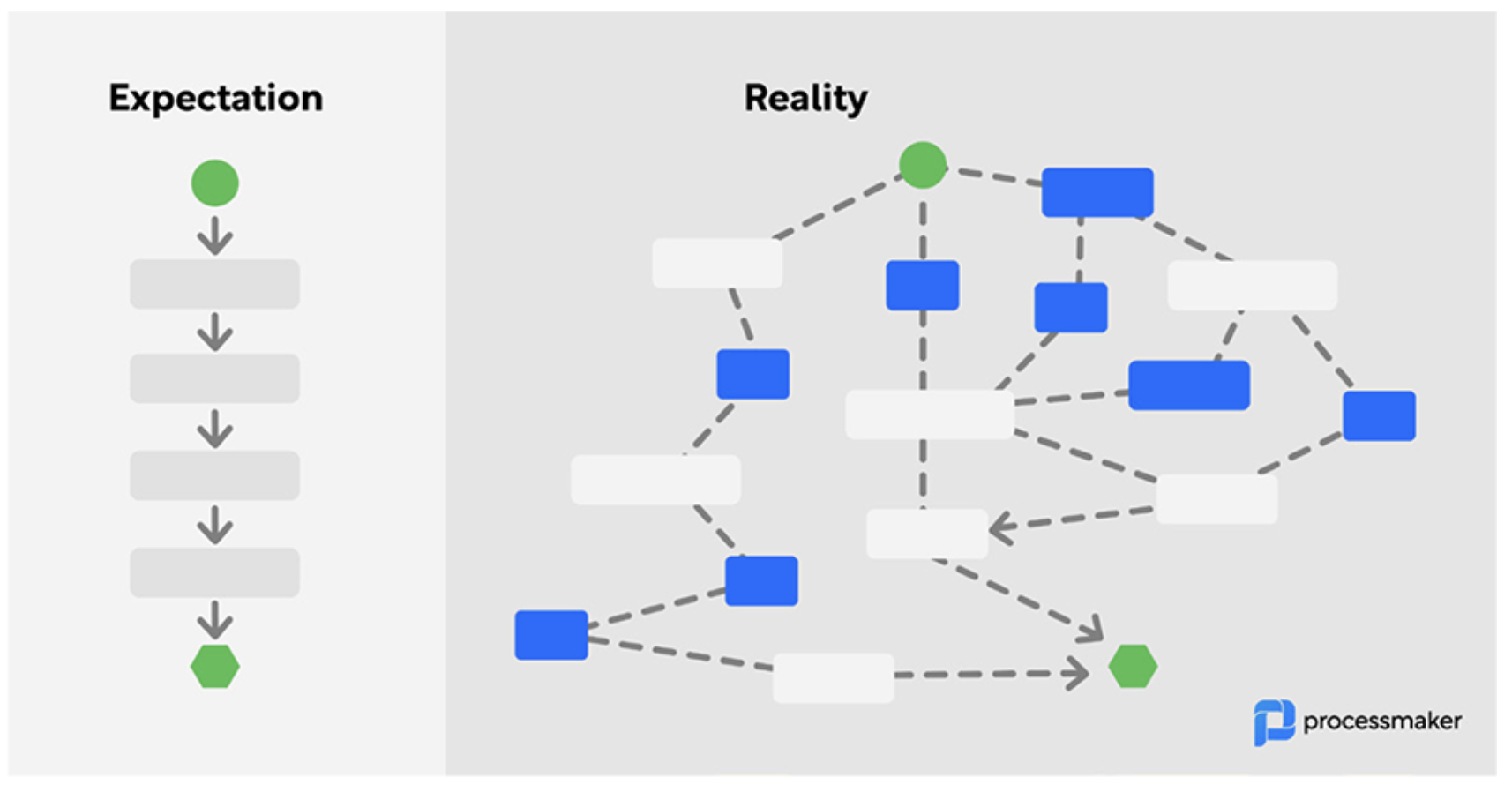Intelligent Automation – WDP1 (Roadmap for Success)

The Appleton Greene Corporate Training Program (CTP) for Intelligent Automation is provided by Dr. Raina Certified Learning Provider (CLP). Program Specifications: Monthly cost USD$2,500.00; Monthly Workshops 6 hours; Monthly Support 4 hours; Program Duration 48 months; Program orders subject to ongoing availability.
If you would like to view the Client Information Hub (CIH) for this program, please Click Here
Learning Provider Profile
Dr Raina is an accomplished consultant with experience in business process automation and digital technologies. He received a Bachelor of Engineering degree in Electronics from Mangalore University (India), a Master of Science degree in Computer Studies (Artificial Intelligence) from Essex University (UK) and a PhD in Computer Science from Bristol University (UK). He has over 25 years of experience and runs a small successful consultancy established over 10 years ago. He specialises in creating business value leveraging technology innovations and best practice. He has provided technical leadership on a number of large and complex, multi-million-dollar transformation programmes involving business process automation.
Dr Raina has industry experience in a variety of sectors including healthcare, finance, public sector, utilities and FMCG. He has worked with multi-national companies based in Europe and the US. He regularly blogs on topics related to process automation and innovative technologies. He is co-inventor on a recent patent application related to adapting chatbots for the air transport industry.
MOST Analysis
Mission Statement
The first step in planning process is to map out the transformation journey in the form of a roadmap. It acts as a blueprint for ensuring that the outcome meets the desired quality, cost, and time constraints. The process kicks off with conceptualization, where the strategy and vision of the Intelligent Automation are laid out. This stage is pivotal as it sets the objective, scope, and requirements of the project, laying the groundwork for subsequent planning. The next crucial step is the readiness assessment of the organisation’s current capabilities and the maturity of its automation practices. It takes into account factors like available resources, existing processes, systems and data quality. The next step in the roadmap delves into a cross-functional center of excellence to lead and support the development of Intelligent Automation. This specialist team consists of members from IT, operations, finance and business units within the organization to drive the development effort. The journey then moves into detailed discovery and analysis of existing business processes to identify use cases with high potential for automation and strong business impact. Stakeholders are engaged to prioritize development activities and to ensure alignment with business objectives. Once the use cases have been identified, an operating model is defined to provide a framework for operational activities as well as associated roles and responsibilities. Organizational change management is an important part of initial planning to prepare the organization for the adoption of automation. It includes communication strategies to educate employees about the benefits of IA and training programs to upskill or reskill the workforce and help with the transition. The next stage is the development of the technical capabilities that enable the automation solutions. It includes selection of appropriate tools and platforms as well as ensuring integration with existing systems. Once the planning stages are completed, the attention turns to execution, to bring the plan to life. The development and delivery of IA solutions follows a Lean-Agile process. Benefit hypotheses are validated and iteratively refined into solutions that add value, reducing waste and increasing the chances of successful outcomes. In this phase, coordination among teams, departments, or stakeholders is vital to maintain smooth execution. After execution follows the monitoring and evaluation phase, where the outcomes are compared against the initial goals. This phase includes defining KPIs and measuring the value and impact of process automations. Lastly, the continuous improvement and sustainability phase are key part of the transformation journey to ensure that the impact of the project lasts long beyond the initial adoption. It’s not just about reaching the end goal, but about constantly refining and enhancing the process.
Objectives
01. Strategy and Vision: departmental SWOT analysis; strategy research & development. Time Allocated: 1 Month
02. Readiness Assessment: departmental SWOT analysis; strategy research & development. Time Allocated: 1 Month
03. Cross-functional CoE: departmental SWOT analysis; strategy research & development. Time Allocated: 1 Month
04. Use Case Discovery: departmental SWOT analysis; strategy research & development. Time Allocated: 1 Month
05. Target Operating Model: departmental SWOT analysis; strategy research & development. Time Allocated: 1 Month
06. Organizational Change Management (OCM): departmental SWOT analysis; strategy research & development. Time Allocated: 1 Month
07. Intelligent Automation Technology: departmental SWOT analysis; strategy research & development. 1 Month
08. Lean Agile Development: departmental SWOT analysis; strategy research & development. Time Allocated: 1 Month
09. Measuring Value: departmental SWOT analysis; strategy research & development. Time Allocated: 1 Month
10. Roadmap Delivery: departmental SWOT analysis; strategy research & development. Time Allocated: 1 Month
11. Continuous Improvement: departmental SWOT analysis; strategy research & development. Time Allocated: 1 Month
12. Adoption and Industry Trends: departmental SWOT analysis; strategy research & development. Time Allocated: 1 Month
Strategies
01. Strategy and Vision: Each individual department head to undertake departmental SWOT analysis; strategy research & development.
02. Readiness Assessment: Each individual department head to undertake departmental SWOT analysis; strategy research & development.
03. Cross-functional CoE: Each individual department head to undertake departmental SWOT analysis; strategy research & development.
04. Use Case Discovery: Each individual department head to undertake departmental SWOT analysis; strategy research & development.
05. Target Operating Model: Each individual department head to undertake departmental SWOT analysis; strategy research & development.
06. Organizational Change Management (OCM): Each individual department head to undertake departmental SWOT analysis; strategy research & development.
07. Intelligent Automation Technology: Each individual department head to undertake departmental SWOT analysis; strategy research & development.
08. Lean Agile Development: Each individual department head to undertake departmental SWOT analysis; strategy research & development.
09. Measuring Value: Each individual department head to undertake departmental SWOT analysis; strategy research & development.
10. Roadmap Delivery: Each individual department head to undertake departmental SWOT analysis; strategy research & development.
11. Continuous Improvement: Each individual department head to undertake departmental SWOT analysis; strategy research & development.
12. Adoption and Industry Trends: Each individual department head to undertake departmental SWOT analysis; strategy research & development.
Tasks
01. Create a task on your calendar, to be completed within the next month, to analyze Strategy and Vision.
02. Create a task on your calendar, to be completed within the next month, to analyze Readiness Assessment.
03. Create a task on your calendar, to be completed within the next month, to analyze Cross-functional CoE.
04. Create a task on your calendar, to be completed within the next month, to analyze Use Case Discovery.
05. Create a task on your calendar, to be completed within the next month, to analyze Target Operating Model.
06. Create a task on your calendar, to be completed within the next month, to analyze Organizational Change Management (OCM).
07. Create a task on your calendar, to be completed within the next month, to analyze Intelligent Automation Technology.
08. Create a task on your calendar, to be completed within the next month, to analyze Lean Agile Development.
09. Create a task on your calendar, to be completed within the next month, to analyze Measuring Value.
10. Create a task on your calendar, to be completed within the next month, to analyze Roadmap Delivery.
11. Create a task on your calendar, to be completed within the next month, to analyze Continuous Improvement.
12. Create a task on your calendar, to be completed within the next month, to analyze Adoption and Industry Trends.
Introduction
The first workshop is aimed at charting the course for the successful implementation of intelligent automation, from establishing a clear definition of the vision and scope to bringing that vision to life, while addressing all the dependencies and enablers necessary for success. During the workshop, participants will learn about the importance of the implementation roadmap. They will also learn how it can be used to identify potential roadblocks and develop strategies to overcome them. By the end of the workshop, attendees will have a comprehensive action plan in place. This plan will outline tasks, timelines, and responsibilities to ensure the smooth implementation of intelligent automation within the organization. This workshop serves as a crucial first step toward achieving operational excellence through automation. It sets the stage for future workshops that will delve into more specific aspects of the implementation process.
When implementing automation, many organizations tend to take a technology-centric approach and do not focus enough on the business and organizational impact. Indeed, many earlier implementations of IA have failed because of a lack of alignment between technology and organizational goals. Prioritizing a holistic approach that considers both technology and organizational needs is essential for ensuring successful implementation and maximizing the benefits of intelligent automation.
According to a Deloitte Insights survey titled “Automation with Intelligence,” the main obstacles to adopting intelligent automation are fragmented processes, lack of IT readiness, and unclear vision.
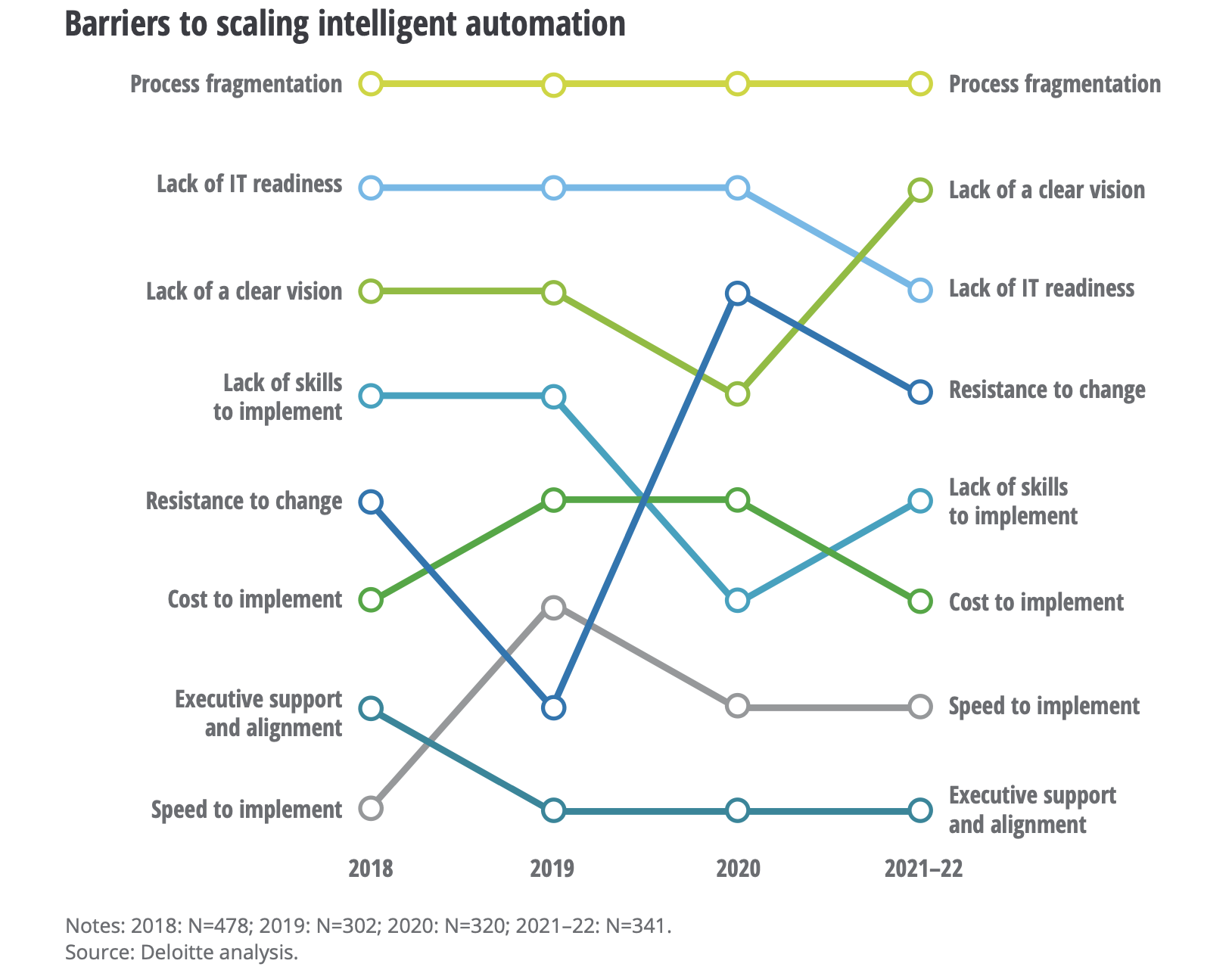
The roadmap developed in this workshop will address the people, processes, and technology aspects of intelligent automation, ensuring that individuals within the organization are well-prepared to effectively embrace and utilize this technology. By the end of the workshop, attendees will have a clear plan for implementation and a solid foundation for successfully navigating the cultural shifts that come with adopting intelligent automation.
Vision and strategy
The foundation of any successful Intelligent Automation (IA) implementation is the establishment of a clear strategy and vision. A clearly defined plan guarantees alignment with corporate objectives and promotes sustainable growth when firms adopt automation to improve productivity, cut costs, and streamline operations. A clear plan and vision are imperative for achieving significant and enduring outcomes in IA transformation; they are indispensable. They act as a compass, helping businesses navigate the challenges of automation and making sure that each action leads to a better, more productive future.
The IA transformation is guided by a strategy and vision that answer critical questions: Why are we implementing automation, and what outcomes do we expect? This clarity ensures that automation initiatives align with organizational goals, like improving customer satisfaction, increasing productivity, and fostering innovation.
The organization’s vision clarifies the purpose behind pursuing those goals, while the strategy outlines the intended achievements. Combined together, they work as a compass, guaranteeing that the roadmap has a defined course and is not veered off course by unintended diversions or snap judgments. It helps organizations prioritize projects that support the overall goals of the company and ensure that resources are allocated effectively.
Diverse teams and several departments are frequently involved in IA initiatives. Stakeholders from all areas of the company are brought together by a common goal, which unifies the automation strategy. This alignment guarantees that everyone is working toward the same goals, reduces opposition to change, and promotes teamwork. Instead of treating automation projects as discrete endeavors, the roadmap merges them cohesively through a well-defined strategy and vision. This alignment guarantees that each initiative avoids duplication, adds to the overall transformation objectives, and generates cumulative value.
A solid vision and strategy offer a framework for assessing and choosing automation options. They assist decision-makers in determining which technologies to use, which processes to automate first, and how best to distribute resources. This reduces risks and guarantees that investments have the greatest possible impact. A strategic framework helps with prioritizing investments in automation technologies. Organizations can efficiently allocate resources and prevent effort from being wasted on low-value projects by concentrating on areas that have the greatest impact or are in line with long-term objectives.
Establishing a vision ensures that the roadmap addresses scalability and quick wins effectively. A clear plan foresees future growth, allowing businesses to create an automation ecosystem that adapts to evolving business requirements and technological progress. Organizations set success standards by integrating the strategy and vision into the roadmap. Throughout the IA process, quantifiable results such as cost reduction, increased productivity, or improved customer satisfaction, help monitor progress and guarantee accountability.
A well-defined strategy should also incorporate governance concepts that preserve control over automation initiatives. Organizations should address compliance, security, and ethical issues early on and minimize implementation disruptions by integrating risk management into the strategy. People are just as important to intelligent automation as technology. Employees are inspired to embrace automation and see its potential to improve the workplace when a compelling vision is presented. By developing a narrative that connects specific actions to significant results, they assist stakeholders in understanding how each stage advances the organization’s ultimate objectives.

Case Study: Benefits of Joined-Up Vision and Strategy at Christian Aid
As a leading charity organization, Christian Aid has a global presence and operates a diverse set of programs, providing relief to communities affected by disasters. Their early attempts at digital transformation were characterized by multiple projects with a focus on execution and internal processes rather than the outcomes required by the organization as a whole, operating in a digital world. Their passionate workforce was committed to digital transformation and had some idea of the benefits of digital technology at individual or project level. However they felt their efforts were not delivering the anticipated change.
They needed a common vision and an outcomes driven strategic direction. They started by taking a broader view of the needs of digital technology across the organization and over a longer horizon of 3-5 years. The focus was shifted to outcomes and how the organization operated and interacted with the outside world. At the core of the strategy was how they delivered services to their beneficiaries and how they could improve their fund raising capabilities through digital transformation. The strategy also adjusted their apetite for risk and accptance of some wasted effort due to the evolving nature of digital technology. This was a challenge given the frugal operating culture of a charity organization.
The result was that the executives, trustees and wider organisation had a clear understanding of how digital will change and benefit Christian Aid. A prioritised roadmap was generated based on the strategy. All projects were aligned to the common outcomes of the organization. The stakeholder engagement was broadened, and there was greater clarity around digital initiatives.
Where are we?
This is the first question any transformation roadmap should address, and IA is no exception. It is an opportunity to establish a baseline of the current state of the business, its people, processes, and technology. Understanding the readiness of the organization for change is essential in determining the success of implementing intelligent automation. This assessment will help identify any potential barriers or challenges that may arise during the transition process. By addressing these issues early on, the organization can better prepare for the changes that come with adopting IA. Additionally, evaluating the current state of the business will provide valuable insights into where improvements can be made and how IA can be effectively integrated to enhance operations.
A maturity assessment is used by an organization to evaluate its current capabilities and readiness for scaling automation or other strategic initiatives. It helps businesses understand where they stand in terms of their processes, technology, workforce skills, and governance structures relative to industry best practices. By identifying strengths and weaknesses, a maturity assessment provides a clear view of the gaps that need to be addressed to reach higher levels of performance. For intelligent automation, it can help determine how prepared an organization is to expand automation efforts and ensure alignment with business objectives. It provides the necessary basis for creating an effective roadmap.
Another key technique for a successful transformation journey is to use As-is vs To-be process mapping. By understanding where you are (As-is) and where you want to go (To-be), organizations can chart a clear, actionable path to success, ensuring their automation journey delivers measurable value.
The As-is process represents the current state of a business operation. It reflects how tasks are executed today, capturing every step, decision point, dependency, and tool involved. It involves current process automation activities and how they are managed, including the stakeholders involved. The as-is analysis should also include the inputs and outputs as well as the pain points experienced by stakeholders.
The To-be process represents the desired future state after improvements and automation are applied. It envisions how the process will function with enhanced efficiency, reduced manual intervention, and optimal use of IA technologies. It includes the streamlined target workflows, the new ways of working and the improved outcomes.
The comparison of as-is and to-be processes enables the identification of gaps and how to prioritize initiatives to address the gaps. It also helps foresee and mitigate risks arising due to change.
Organizational Transformation
Organizational change management is an important aspect of any large transformational project. It involves preparing employees for the changes that will come as a result of the roadmap implementation and providing support throughout the transition. By prioritizing effective change management strategies, the organization can minimize resistance and maximize buy-in from all stakeholders. Additionally, regular monitoring and feedback mechanisms should be put in place to track progress and make necessary adjustments along the way.
The Center of Excellence (CoE) serves as a central hub for best practices, training, and resources related to the automation transformation program. It acts as a guiding force for the organization, ensuring that all departments are aligned and working towards the same goals. By leveraging the expertise within the center of excellence, the organization can navigate challenges, streamline processes, and achieve successful outcomes in a timely manner. Establishing a cross-functional CoE early on in the roadmap is crucial for creating a strong foundation for the automation transformation program. This allows for collaboration and communication between different departments, ensuring that everyone is on the same page and working towards a common goal. The CoE also helps in identifying potential roadblocks and finding solutions quickly, leading to a more efficient and effective implementation of the automation program.
Besides the CoE, a number of supporting stakeholders provide valuable contribution in the development of the automation roadmap. An automation champions group includes representatives from different lines of business within the organization and they play an instrumental role in the promotion and syndication of automation capabilities and the ensuing benefits. Enterprise architects help with the governance of the solution as well as providing the bridge between the business and the CoE. For example, an enterprise architect may work closely with the CoE to ensure that the automation solutions align with the overall IT architecture and strategic goals of the organization. Additionally, they may collaborate with business stakeholders to gather requirements and provide guidance on how best to leverage automation technologies for maximum efficiency and effectiveness. It is also important to engage the wider user base as citizen developers. This helps provide valuable feedback and encourages discovery of new opportunities for automation.
Lack of focus on adoption and communication is a common reason why automation efforts fail. Successful adoption requires effective communication and training, and the roadmap must support this process by making sure that all parties involved are aware of the advantages of automation. Organizations can maximize the return on investment and raise the probability that automation projects will be implemented successfully by giving adoption and communication top priority. Employee participation in the development process and clear communication of the advantages of the IA solution are two strategies to boost acceptance and reduce resistance to change.
What should be Automated?
The roadmap depends on a clear set of requirements and what processes to automate. Determining what tasks should be automated can be achieved through conducting a thorough analysis of existing processes within the organization. This includes identifying repetitive and time-consuming tasks that can be streamlined through automation. By engaging employees who are directly involved in these processes, valuable insights can be gained to uncover automation opportunities. Automation opportunities can be found across the business functions of an organization and across industry sectors.
According to a McKinsey study, AI and analytics have the potential to create between $3.5 trillion and $5.8 trillion in value annually across nine business functions in 19 industries.
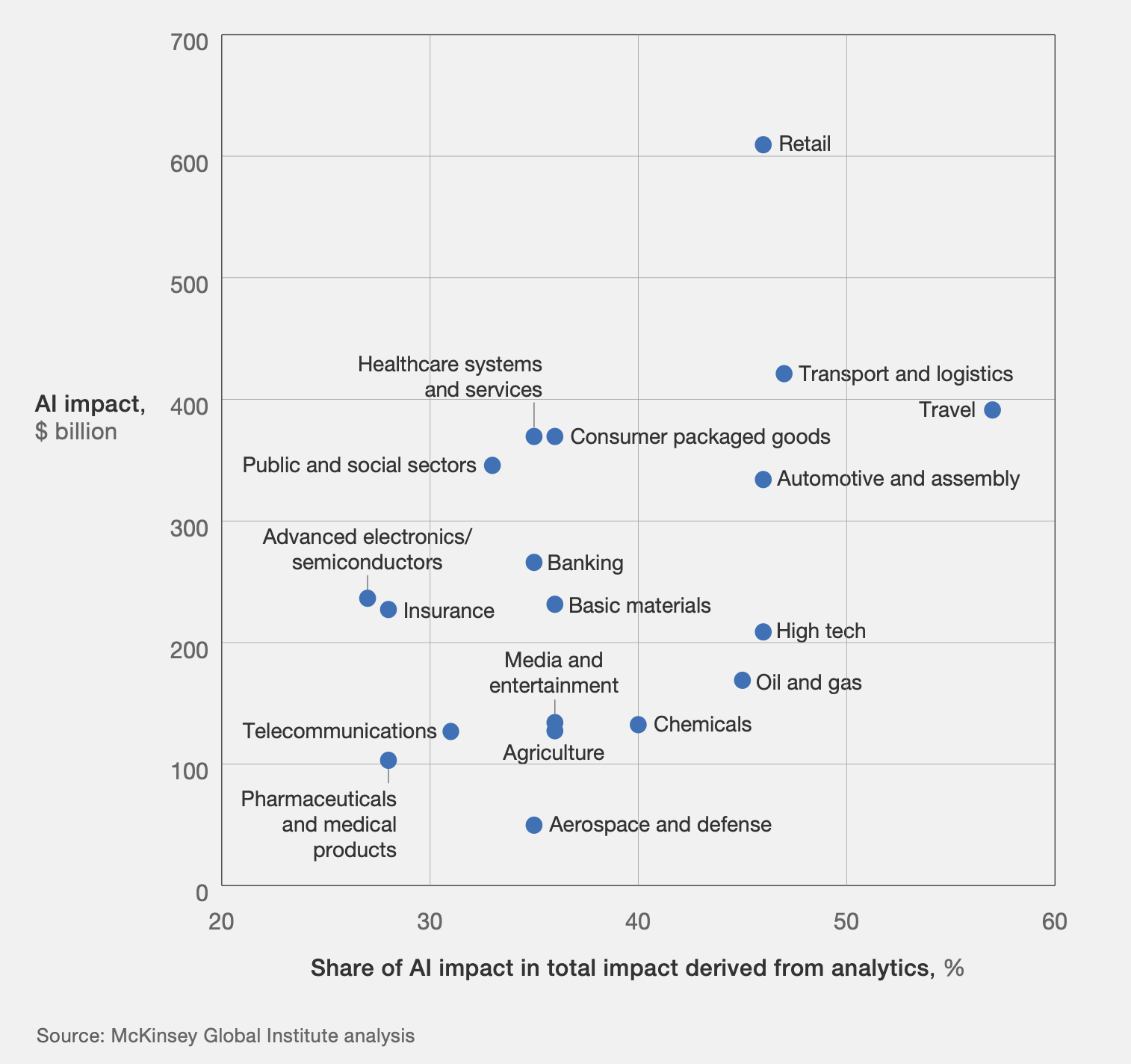
Understanding the goals and objectives of the organization is crucial when deciding which processes to automate. By aligning automation efforts with the overall business strategy, companies can ensure that resources are allocated efficiently and effectively. This approach also helps prioritize automation projects based on their potential impact on key business outcomes. A number of analytical tools can be used to help identify scope and develop the transformation roadmap.
One such tool is the Business Model Canvas. It helps organizations visualize and understand their current business model, as well as identify areas where automation can be integrated for maximum benefit. Its visual and collaborative nature simplifies strategic planning, fosters innovation, and ensures alignment across teams. This framework consists of a simple, structured approach generally utilized for mapping out the key elements of an established or startup business. Automation transformation initiatives at large organizations can be thought of as a startup business, and the business model canvas helps organize an initiative into interconnected building blocks to enable a comprehensive understanding of how the transformation creates, delivers, and captures value for the business. Organizations can experiment with different configurations to identify new opportunities, such as targeting untapped customer segments, introducing innovative revenue streams, or leveraging automation to reduce costs. By simplifying complex business models into a one-page visual representation, it can help decision-making, communication, and alignment among stakeholders. It is especially useful for presenting ideas to executives, investors, or teams without overwhelming them with low-level technical details. It also promotes collaboration across departments. Teams can jointly map out the business model, ensuring alignment and shared understanding. This collaborative process fosters ownership and encourages diverse perspectives when addressing challenges of a large transformation exercise.
A key component of the business model canvas is the value proposition, often analyzed separately to focus on the needs and wants of the users and stakeholders of the automation solution. A Value Proposition Canvas outlines the pain points and the expected gains as seen from the perspective of the consumers of the solution. These pains and gains are then mapped to particular elements of the solution and processes that address them.
Analyzing current processes involves evaluating the efficiency and effectiveness of existing workflows to determine where automation can provide the most benefit. This is where Process Mining tools can help. By examining each step in a process, organizations can pinpoint areas that are repetitive, time-consuming, or error-prone, making them prime candidates for automation. Process mining tools can analyze event logs and extract valuable insights into how processes are actually being executed. By visualizing the flow of activities and identifying bottlenecks and deviations, organizations can make informed decisions on where to implement automation. These tools can also provide metrics on process performance, allowing for continuous improvement and optimization.
Another useful analysis methodology is Value Stream Mapping. It is a lean management practice that visually represents the steps required to deliver a product or service. It highlights the flow of materials and information through a process, identifying value-adding and non-value-adding activities. By analyzing this map, organizations can streamline operations, eliminate inefficiencies, and maximize value to the customer. It is a powerful tool for improving efficiency, reducing waste, and adding value. A value stream map starts with the current state map, representing the current process flows and provides a clear picture of how work is done today, including tasks, delays, and inefficiencies. A future state map outlines the desired process flow after improvements, showing how the system should operate to maximize efficiency and deliver value. Each step in the process is categorized as: adding value, non-value-adding but necessary and waste. Key data points are captured for each step, such as cycle time, lead time, inventory levels, and error rates. Visualizing the process in such a way helps understand the key activities of the process, target inefficiencies and streamline workflows.
Once potential automation opportunities have been identified, the next step is to assess the benefits and the impact that implementing automation will have on the organization. This involves considering factors such as cost savings, increased productivity, improved accuracy, and enhanced customer satisfaction. By conducting a thorough impact analysis, companies can make informed decisions about which automation projects to prioritize and invest in.
Prioritizing use cases based on their potential impact on the organization is crucial in ensuring that automation efforts are focused on areas that will provide the most benefit. By ranking use cases according to their potential ROI and strategic value, companies can allocate resources effectively and maximize the return on their automation investments. Additionally, prioritizing use cases allows organizations to inform the roadmap for automation implementation, outlining clear objectives and timelines for each project.
Navigating Technology
The availability of technology that can be used for automation is truly mind-boggling. In particular, AI developments such as generative AI and ChatGPT have shown the potential of a whole new class of cognitive automation opportunities. Outside of AI, the availability of advanced low-code and no-code tools has made the development of automation solutions easier and more cost-effective.
It is important to exercise caution when selecting the appropriate technology for automation implementation. Before making any strategic decisions, organizations must carefully evaluate their current capabilities and business requirements.
The technology readiness element in the roadmap should ensure that the organization has an understanding of and access to key technologies such as Robotic Process Automation, Artificial Intelligence, and Machine Learning. It may require partnering with technology providers and consultancies to gain expertise and support in implementing these technologies effectively.
A key factor in technology assessment is how well it integrates with existing systems and processes. By conducting a thorough evaluation of available technologies and assessing their compatibility with existing systems, organizations can ensure a successful automation implementation that aligns seamlessly with their business goals. The solution should provide robust APIs, pre-built connectors, and the flexibility to connect to various systems without needing significant changes.
Additionally, organizations should also consider the scalability and flexibility of the chosen technologies to accommodate future growth and changes in business requirements. The right platform should allow you to expand the scope of automation beyond initial use cases, enabling you to automate additional processes, integrate new technologies, and scale across multiple departments or regions.
Technology selection should follow a rigorous process that includes evaluating the compatibility of the platform with existing systems, assessing the level of technical support provided by the vendor, and considering the long-term cost implications. By carefully considering these factors, organizations can ensure that they choose a platform that not only meets their current automation needs but also has the capability to evolve and adapt as their business expands and changes over time.
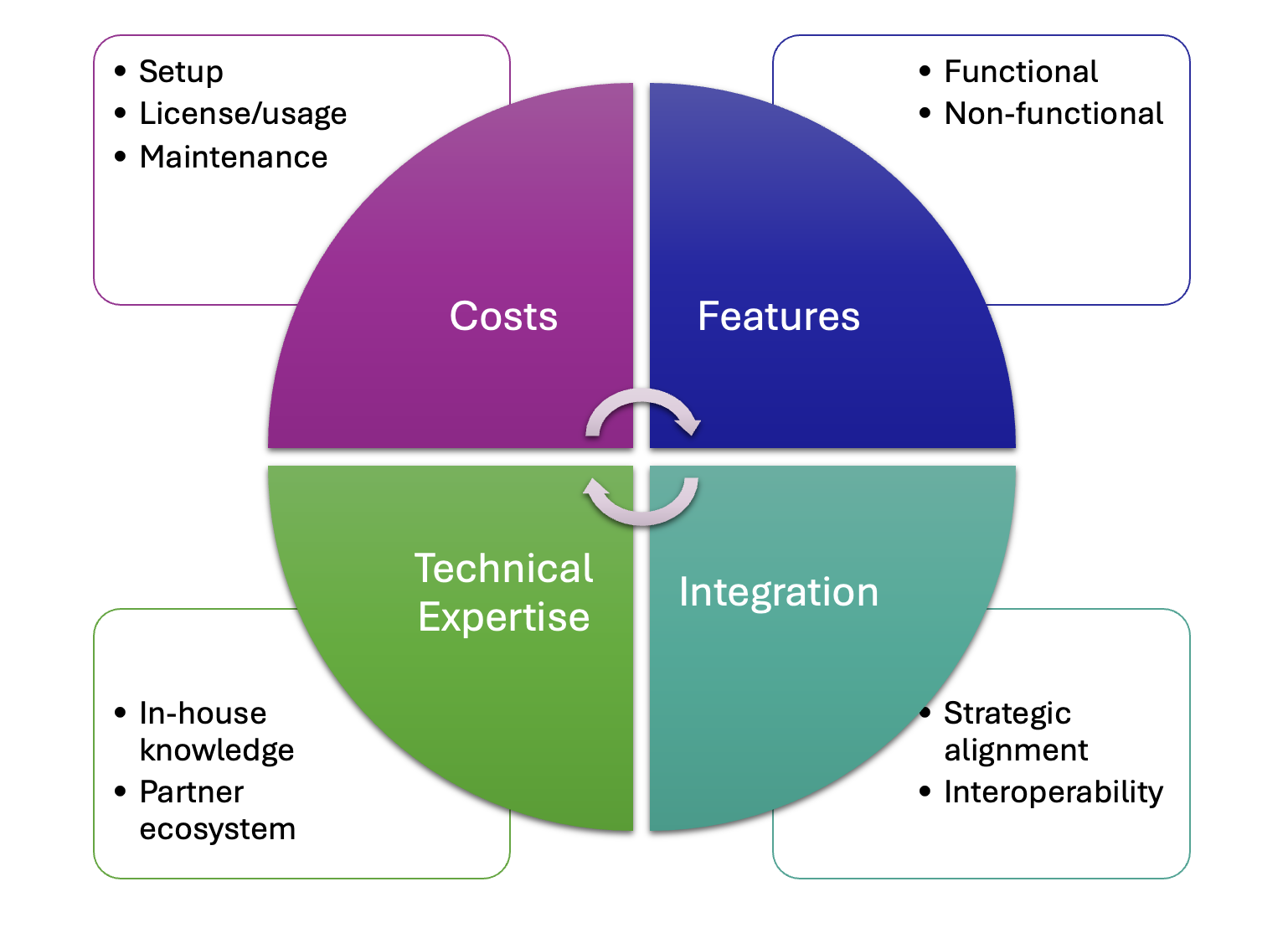
Bringing the Roadmap to Life
The first step in realizing the roadmap is to mobilize a cross-functional team of experts that will drive the implementation. This team consists of individuals from various departments within the organization to ensure that all perspectives are considered. Other stakeholders within the organization should also be involved in the process to provide valuable input and insights. By engaging a diverse group of individuals in the roadmap development, the organization can ensure that all potential challenges and opportunities are addressed effectively. Additionally, clear communication and collaboration among team members will be crucial for successfully implementing the roadmap and achieving the desired outcomes.
Additionally, establishing efficient processes to govern the implementation of the roadmap will help to keep the project on track and ensure that goals are met on time. The processes manage the automation project lifecycle from business as well as technical perspectives. Lean principles such as value driven development and customer development will be used to create benefit hypotheses and validated against business requirements. This ensures that automation solutions do not just solve a perceived technical problem but create business value and are customer centric. When it comes to the development of automation solutions, a flexible and iterative methodology is best suited. A culture of experimentation and incremental change that embodies Lean and Agile principles enables solutions to be built with uncertain requirements and limited investment. This allows for adjustments to be made as needed based on feedback and evolving needs, ensuring that the final product meets the requirements of the organization. Additionally, regular communication and transparency throughout the process are essential in order to keep all stakeholders informed and engaged.
The experimental culture allows multiple versions to be prototyped and proven to deliver business value before committing resources for a fully functional solution. The roadmap will include development of the minimum viable product and other pilot versions to test different features and gather user feedback. By following this iterative approach, the organization can minimize risks and maximize the chances of success when launching the final solution. This method also fosters a culture of continuous improvement and innovation, as teams are encouraged to experiment, learn from failures, and adapt their strategies accordingly. The approach enables businesses to deliver value quickly and continuously, ensuring that processes remain efficient, customer-focused, and adaptable.
A governance framework and operating model ensure that the IA solution lifecycle is effectively managed and aligned with the organization’s strategic objectives. By establishing clear guidelines and responsibilities, the governance framework helps to mitigate risks and ensure that the IA solution is implemented smoothly. The operating model, on the other hand, outlines the roles and processes needed to support the ongoing development and maintenance of the IA solution, ultimately maximizing its effectiveness and impact on the organization. Overall, these components work together to ensure that the IA solution is successfully integrated into the organization and delivers sustainable value in the long run.
Culture of Continuous Improvement
To achieve lasting benefits from investment in intelligent automation solutions, organizations must foster a culture of continuous improvement. This involves regularly evaluating the IA solution’s performance, gathering feedback from users, and making necessary adjustments to enhance its functionality.
Regularly updating automation processes, conducting market research for new technologies, and soliciting feedback from users are effective ways for organizations to adapt to evolving business needs in automation solutions. By continuously monitoring and optimizing the IA solution’s performance, organizations can ensure that it is operating at its full potential. This includes identifying areas for improvement, such as reducing response times or increasing accuracy, and implementing changes to enhance overall efficiency. Establishing feedback loops allows organizations to gather user input, analyze performance data, and make informed decisions for optimizing IA solutions over time.
Key Performance Indicators (KPIs) are essential metrics that help organizations measure progress, assess performance, and identify areas for improvement. In the context of continuous improvement, KPIs play a crucial role in driving systematic and data-driven enhancements to processes, products, and services. KPIs highlight the critical areas that need attention, ensuring efforts are aligned with organizational goals. By tracking these indicators, teams can concentrate their resources on activities that deliver the most value. Continuous improvement initiatives aim for incremental changes over time, and KPIs allow organizations to measure the impact of these changes, providing quantifiable evidence of progress and ensuring initiatives are moving in the right direction. KPIs establish accountability by assigning ownership of performance metrics to individuals or teams. This transparency motivates employees to strive for excellence and fosters a culture of responsibility. Data from KPIs equips leaders with the insights needed to make informed decisions. Whether it is reallocating resources, tweaking processes, or setting new goals, KPI data provides a reliable foundation for action. Tracking KPIs helps pinpoint inefficiencies, bottlenecks, and underperforming areas.
Risks and Ethics
As organizations adopt intelligent automation, it is essential to address the associated risks and ethical considerations. A proactive approach to these issues ensures responsible implementation and fosters trust among stakeholders. By identifying potential risks and implementing strategies to minimize their impact, organizations can build trust with stakeholders and ensure the success and integrity of their IA solutions. With the increasing use of AI and cognitive capabilities, organizations must also address ethical issues. This includes ensuring that AI systems are transparent, accountable, and unbiased in their decision-making processes. Organizations must also consider the broader implications of their use of Intelligent Automation, such as privacy concerns and potential job displacement.
The following key risks should be considered in an IA roadmap.
Data security and privacy: IA systems often rely on large volumes of sensitive data. Improper handling or inadequate security measures can lead to breaches, exposing organizations to legal penalties and reputational damage.
Job displacement: Automation may replace human roles in repetitive tasks, raising concerns about unemployment and workforce displacement. While automation creates opportunities for higher-value roles, the transition can be disruptive.
Bias in decision-making: IA systems, particularly those using AI, can inherit biases present in their training data, leading to unfair or discriminatory outcomes. These biases can undermine the credibility and fairness of automated decisions.
Over-reliance on automation: Excessive reliance on IA can lead to risks when systems fail, encounter edge cases, or produce incorrect outputs. A lack of human oversight may exacerbate errors.
Regulatory non-compliance: Automation processes that fail to comply with industry regulations or data protection laws can expose organizations to fines and operational disruptions.
The roadmap should also address the following ethical considerations.
Transparency: Organizations must ensure transparency in how IA systems operate, particularly when they impact customers or employees. Clear communication fosters trust and mitigates fears about hidden algorithms.
Accountability: Establishing accountability for decisions made by automated systems is critical. Organizations should define who is responsible when systems fail or produce unintended outcomes.
Fairness: Ethical IA implementation requires eliminating bias and ensuring systems treat all users fairly. Regular audits and diverse training datasets can mitigate bias risks.
Human-centric design: IA should enhance human capabilities, not diminish them. Designing systems with user experience in mind ensures technology supports, rather than undermines, human roles.
Social responsibility: Organizations must consider the broader societal impact of IA, including workforce implications and accessibility, and actively work to create opportunities for reskilling and upskilling.
Future Outlook
The technology horizon related to IA continues to expand at a frenetic pace, and the adoption and associated best practices are also evolving rapidly. The roadmap must allocate sufficient time to leverage of new technological advances. In particular, the developments in AI and machine learning will continue to impact and disrupt business processes.
AI Agents and Agentic AI is a key technology area likely to play an important role in future intelligent automation systems. AI Agents are autonomous capabilities that can perform a series of tasks, using intelligent decision-making to iteratively plan and orchestrate the tasks. Agentic AI systems can operate with minimal human intervention, making them ideal for tasks that require continuous monitoring or rapid decision-making. By combining machine learning capabilities with goal-oriented behavior, agentic AI can tackle complex challenges in novel and efficient ways. These systems can adjust their strategies based on new information or changing environments, making them more resilient and effective in dynamic situations. Agentic AI has the potential to provide highly tailored experiences and solutions, learning from user interactions to better serve individual needs. Agentic AI can process natural language, confirm expectations, discuss tasks, and demonstrate a degree of reasoning in decision-making, making it easier for humans to interact with and direct these systems.
Agentic AI can be applied to business processes across industry sectors. In future, agents could autonomously manage supply chains, optimize inventory levels, forecast demand, and even handle complex logistics planning. By analyzing extensive data and making instant decisions, they could greatly enhance operational efficiency and cut costs. In healthcare, AI agents can engage with patients daily, monitoring their mental and physical health, adjusting treatment plans in real-time, and even providing personalized therapy support. By analyzing vast amounts of medical data, they could also predict potential health issues before they become serious, enabling truly proactive healthcare. Similarly, in human resources, AI agents can transform talent management by automating and enhancing various HR processes. From screening job candidates and arranging interviews to facilitating employee onboarding and continuous training, these agents could enhance HR processes. They could also provide personalized career development advice to employees based on their skills, performance, and company needs.
Other technology areas to watch out for include Hyperautomation, Multi-modal automation and Low-code, citizen development. These technologies are not only important in their own right but also in terms of how they complement each other to provide new avenues of automation opportunities. Hyperautomation is maturing towards more collaboration, standardization, agility, and the integration of cutting-edge technologies. Multimodal AI technologies are also evolving at a rapid pace, with a range of non-text models being developed recently. Combining the capabilities of these diverse models to solve real-world business problems is an exciting area of research. Low-code, citizen development, leveraging advances in Generative AI is another key trending area to watch – in future we can expect businesses to empower and enable their wider workforce to build technical solutions and innovations rather than relying on armies of developers.
When planning the IA journey, it is crucial to include early evaluation of these trending technologies in the roadmap. These technologies have the potential to revolutionize the way businesses operate and the speed at which they can adapt to changing market conditions. By incorporating advanced AI technologies into their IA strategies, companies can streamline their processes and empower employees at all levels to contribute to technical solutions.
Furthermore, companies that prioritize ongoing training and education for their employees on these emerging technologies will be better equipped to leverage their full potential. Investing in AI and IA not only enhances efficiency and productivity, but also opens up new opportunities for growth and innovation. As the digital landscape continues to evolve, organizations must be willing to adapt and evolve with it in order to remain relevant and competitive in their respective industries.
Executive Summary
Executive Summary: Roadmap for Success
The purpose of this workshop is to create a comprehensive roadmap for implementing intelligent automation (IA) successfully. By the end of this workshop, participants will have a clear understanding of how to align IA initiatives with business goals and secure buy-in from key stakeholders. The roadmap acts as a blueprint for planning the technical and organizational changes for the successful implementation of automation projects. The workshop aims to equip participants with the necessary tools and knowledge to drive sustainable and impactful change within their organizations through intelligent automation.
Chapter 1: Strategy and Vision
This chapter will cover the significance of aligning IA initiatives with business goals, securing buy-in from key stakeholders, and the role of leadership in driving the IA strategy forward. We will explore how to align IA initiatives with overall business goals and objectives, as well as how to identify key stakeholders and secure their buy-in. Additionally, we will discuss the role of leadership in driving the IA strategy forward and ensuring its successful implementation. By the end of this chapter, you will understand why creating a clear strategy and vision is crucial for the intelligent automation roadmap.
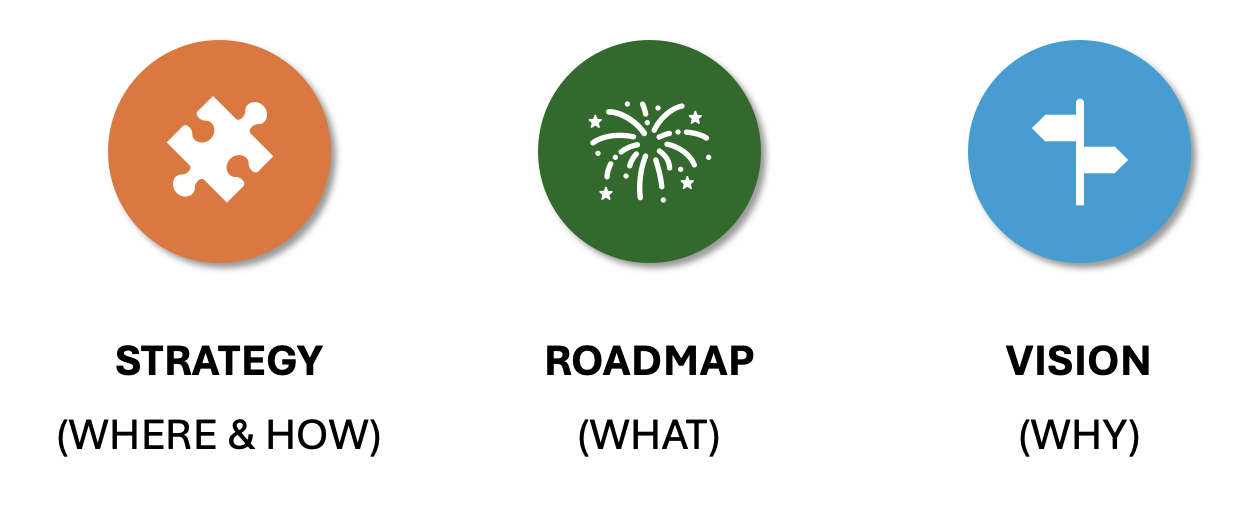
To align with the organization’s strategic goals, you need to identify specific business processes where IA can add the most value, such as automating customer service inquiries or optimizing supply chain operations. Additionally, understanding the unique needs of departments, like IT requiring efficiency improvements or HR needing streamlined onboarding processes, is essential. By aligning IA initiatives with the organization’s strategic goals, you can ensure that resources are allocated effectively and that the technology is being used to support key business objectives. This alignment will also help to secure buy-in from key stakeholders, who will be more likely to support and champion the IA strategy if they see how it directly contributes to the organization’s success. A clear vision and a well-aligned IA strategy can help drive innovation, improve decision-making, and ultimately drive the organization toward its long-term objectives.
At the core of the strategy are the business processes and key areas where automation can drive the most value. A well-defined strategy allows you to prioritize initiatives and allocate resources effectively, ensuring that time, money, and manpower are invested where they deliver the highest value. A shared strategy and vision also provide a common understanding across teams and stakeholders. This helps to foster collaboration and ensure that everyone is working towards the same outcome. Furthermore, establishing a clear vision for how IA will transform operations and improve outcomes ensures that all actions and projects within the roadmap consistently support the end goal, avoiding misaligned efforts.
Leadership plays a crucial role in defining the strategy by effectively communicating the benefits of IA, such as cost savings through automation or improved decision-making with data analytics. They also play a key role in aligning IA initiatives with strategic business goals, emphasizing increased operational efficiency or enhanced customer experiences. Additionally, leaders provide the necessary resources and support to ensure that automation initiatives are executed efficiently and effectively. Highlighting the role of leadership in driving strategy is an important part of a successful roadmap.

Chapter 2: Readiness Assessment
This chapter delves into the importance of conducting a readiness assessment before implementing an IA strategy. This assessment will help identify any gaps in the organization’s current capabilities and resources, as well as determine the level of support and buy-in from key stakeholders. By understanding the organization’s current state and readiness for IA adoption, you can better tailor your roadmap to address specific challenges and ensure successful implementation. A thorough assessment can also help you to identify potential barriers to adoption and to develop strategies to overcome them.
As organizations move from their current state (as-is) to their desired future state (to-be) with automation, it is crucial to understand and document the existing processes accurately. As-is process modelling helps identify inefficiencies, bottlenecks, and opportunities for improvement that can be addressed through automation. On the other hand, to-be process modeling involves designing and mapping out the ideal automated processes that align with the organization’s goals and objectives. By effectively bridging the gap between the current and future states, organizations can streamline their operations and maximize the value of IA implementation.
Utilizing tools such as the business model canvas, organizations can visualize and analyze their business process management in a clear and structured way. This allows them to articulate the value proposition and how that value is created and consumed. A maturity assessment can help organizations evaluate their current level of automation and where they currently stand relative to where they need to be to achieve the automation vision.
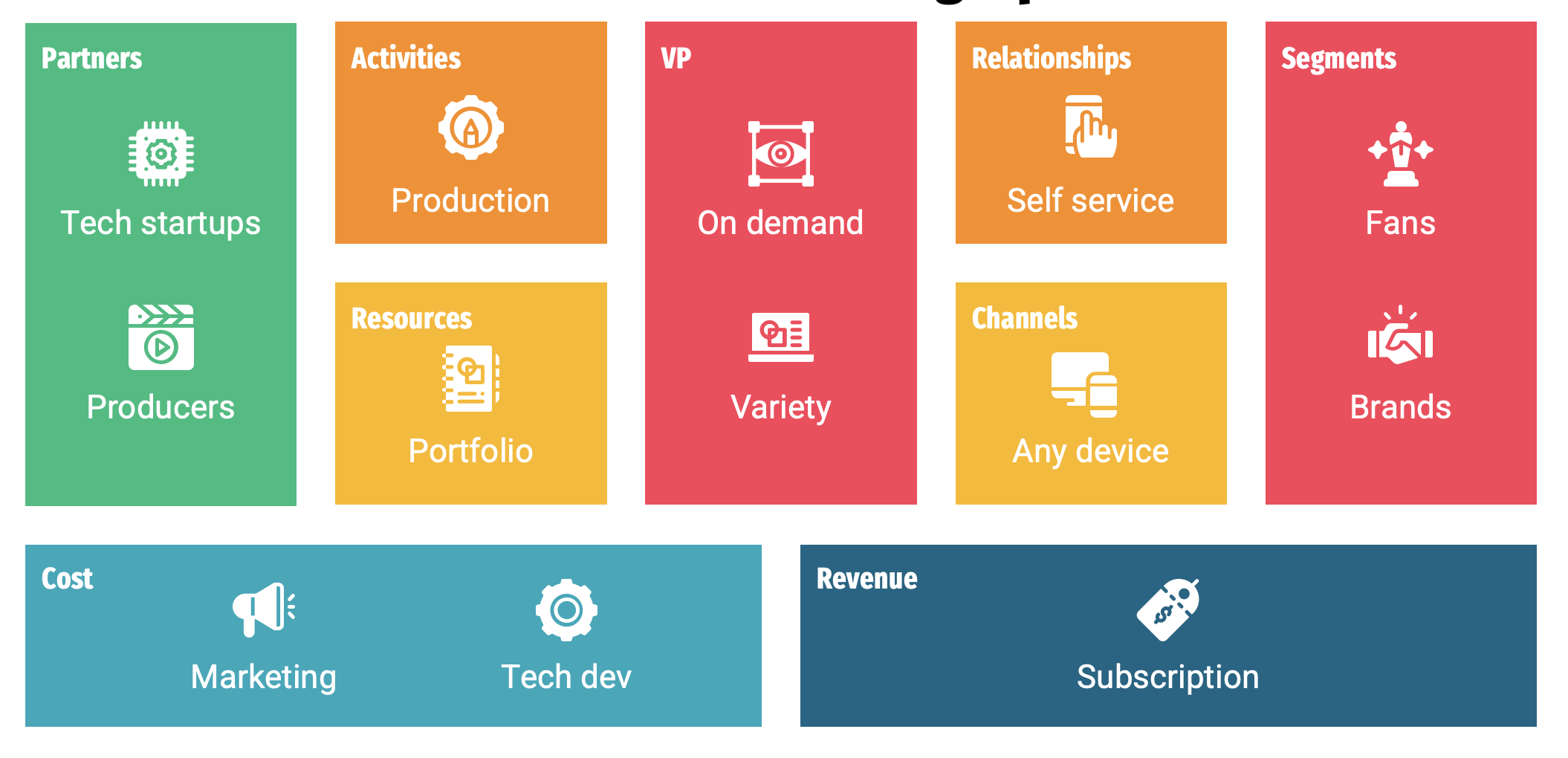
During the assessment process, organizations can also identify potential barriers or challenges that may be hindering the full implementation of intelligent automation. The assessment process helps the roadmap include a clear understanding of the organization’s strengths and weaknesses. A readiness assessment is a crucial step in the automation journey, guiding organizations towards successful implementation of the process automation roadmap.

Chapter 3: Cross-functional CoE
Establishing a center of excellence (CoE) is a crucial step in driving successful intelligent automation initiatives. A CoE brings together expertise from various departments to streamline communication, share best practices, and ensure alignment across the organization. The CoE brings together experts from various departments, including IT, operations, and business units, to collaborate on the development and implementation of IA projects. By creating a centralized hub of IA expertise, companies can streamline communication channels, facilitate knowledge sharing, and ensure consistent alignment of IA initiatives with organizational objectives. This team will be responsible for setting goals, defining roles and responsibilities, and monitoring progress towards achieving key milestones. By having a dedicated group overseeing the IA initiative, companies can ensure that resources are allocated effectively and that the project stays on track. The team can also provide guidance and support to other departments as they navigate the complexities of implementing IA technologies. Additionally, the CoE can serve as a resource for training, troubleshooting, and continuous improvement, helping to drive long-term success and sustainability in the adoption of IA technologies.
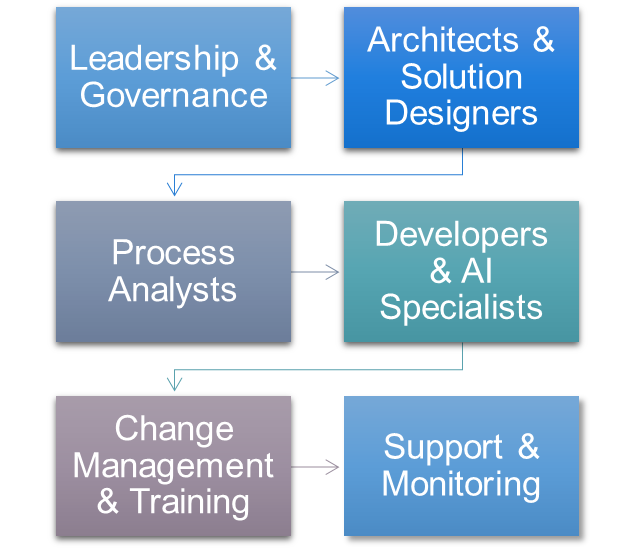
The alignment and structure of the CoE may vary based on how the company operates. The CoE may be centralized or distributed, and it may be organizationally aligned with the technology or finance departments. These are important decisions that affect the roadmap and its implementation. Besides the CoE other stakeholder teams can contribute to the success of IA implementation. An IA operating committee provides the governance and oversight needed to ensure that IA initiatives align with business goals and objectives. Additionally, a group of employees may act as “champions, advocating and popularizing the benefits of the IA program.
Defining the roles and responsibilities of the CoE and supporting stakeholders is an important element of the roadmap. A RACI matrix is a useful tool for clarifying roles and responsibilities within the CoE and stakeholder teams. By clearly defining these roles, teams can avoid confusion and ensure that all necessary actions are taken. This level of organization and clarity is essential for the successful execution of an IA program, as it allows for efficient collaboration and clear communication channels.

Chapter 4: Use Case Discovery
In Chapter 4, we will shift the focus to roadmap activities for identifying and analyzing automation opportunities to drive value and efficiency within the organization. This involves identifying potential areas within the business where automation technologies can be applied to drive value and improve efficiency. By carefully selecting processes with high potential for automation and strong business impact, the IA program can ensure that resources are allocated effectively and results are maximized. This strategic approach will help the IA program focus on initiatives that will deliver the greatest benefit to the organization. Once potential automation opportunities have been identified, it is important to conduct a detailed analysis to understand the current state of the processes and the potential benefits of automation.
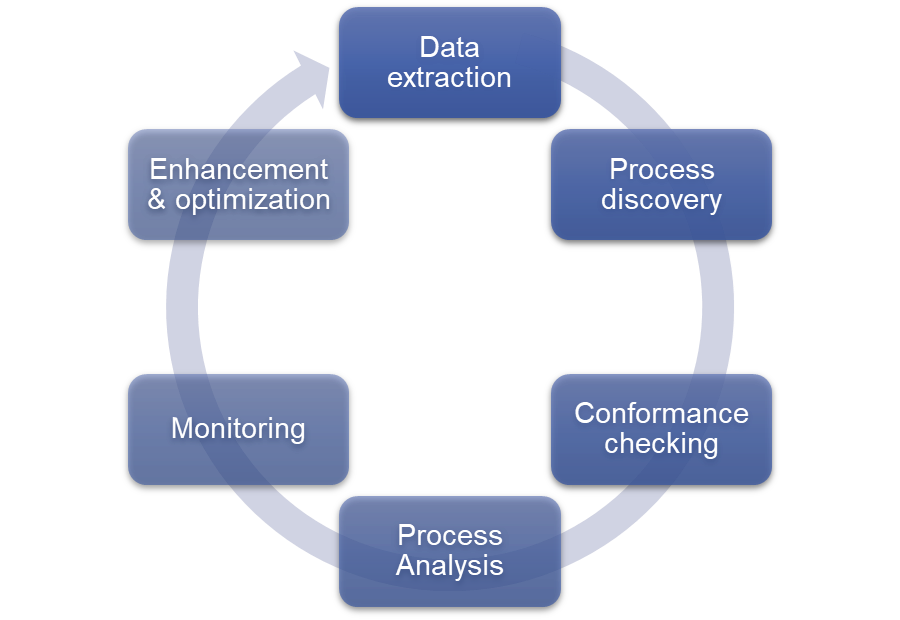
The selection of automation opportunities should align with business objectives. Businesses organize their routine activities into business processes to improve efficiency and achieve specific goals. These could be common business processes such as quote-to-cash and HR onboarding or industry-specific processes such as claims processing in the financial sector or patient record management in the healthcare sector. All such processes have the potential for improvements through intelligent automation.
Tools such as Celonis or Disco can analyze current workflows and procedures within the organization, offering insights into bottlenecks and areas for optimization. By leveraging process mining software, organizations can gain a detailed understanding of their operational processes and identify opportunities for improvement. By analyzing event logs and data from various systems, organizations can gain insights into process efficiency, identify workflow redundancies, and pinpoint opportunities for automation. This real-time analysis allows for proactive decision-making and continuous process improvement. Such a data-driven approach allows for a more accurate understanding of process flow and potential areas for improvement.
Prioritization and planning are essential steps in the process of implementing improvements based on the insights gained from process mining. By identifying the most critical areas for optimization, organizations can focus their resources and efforts on making the most impactful changes. This targeted approach ensures that time and resources are not wasted on less significant improvements, leading to a more efficient and effective overall strategy for enhancing operational performance. In addition to process discovery, the roadmap should also consider the benefits and the value of automating tasks. This will aid further in the prioritization process.
Finally, it is crucial to consult key decision-makers and subject matter experts from across the organization when identifying use cases and analyzing automation requirements. In particular, process owners and analysts with in-depth knowledge of process workflows are likely to have years of accumulated knowledge that can be leveraged to understand the detailed operation of business processes.

Chapter 5: Target Operating Model
An operating model provides the framework for how an organization’s processes, people, and technology work together to achieve its strategic objectives. As processes are automated, the target operating model needs to be redefined to incorporate the changes to people, processes, and technology, as well as leveraging the new ways of working. In addition, the governance and upkeep of automation solutions themselves need well-defined procedures to ensure their efficient operation. Thus, the operating model definition is another crucial component of the IA roadmap that will be discussed in this chapter.
A successful operational model must have both governance and control. Automated processes must be included in the governance framework. Organizations can guarantee uniformity and standardization in the execution of IA projects and offer standards for assessing their effectiveness by adopting explicit policies and procedures. The organization must ensure that IA initiatives are in line with business aims and are efficiently managed to generate value by putting in place a clear governance framework.
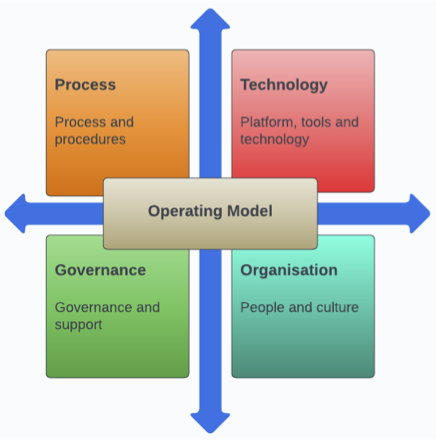
Roles and responsibilities should be clearly defined within the operating model to ensure accountability and efficiency. By assigning specific roles and responsibilities to individuals or teams, organizations can streamline processes and avoid confusion or duplication of efforts. Clear roles and responsibilities help team members understand their tasks and expectations, leading to improved collaboration and communication within the organization.
The automation project lifecycle is a key element of the operating model. This lifecycle involves identifying areas for automation, designing and implementing solutions, testing and refining processes, and ultimately scaling automation efforts throughout the organization. By following a structured process, organizations can ensure that their IA projects are successful and sustainable in the long term. This approach also allows for continuous improvement and optimization of automated processes, leading to increased efficiency and productivity across the board.

Chapter 6: Organizational Change Management (OCM)
This chapter explores the organizational change element of the roadmap and how organizations can effectively manage and navigate through the transformational change associated with the automation of business processes. It is essential for organizations to have a structured approach to managing change in order to minimize disruptions and maximize positive outcomes.
A key part of OCM involves creating a clear communication plan to keep employees informed and engaged throughout the process, as well as providing training and support to help them adapt to new technologies and ways of working. By addressing any resistance early on and involving employees in the decision-making process, organizations can increase buy-in and ultimately achieve successful implementation of intelligent automation. Additionally, creating a supportive and collaborative work environment can foster a culture of continuous learning and innovation. By encouraging open communication and feedback, employees will feel more empowered and engaged in the implementation process. Investing in ongoing support and resources for employees as they navigate the changes brought on by intelligent automation will also be crucial for long-term success. With a comprehensive change management plan in place, organizations can navigate the challenges of integrating IA seamlessly into their operations and drive sustainable growth.
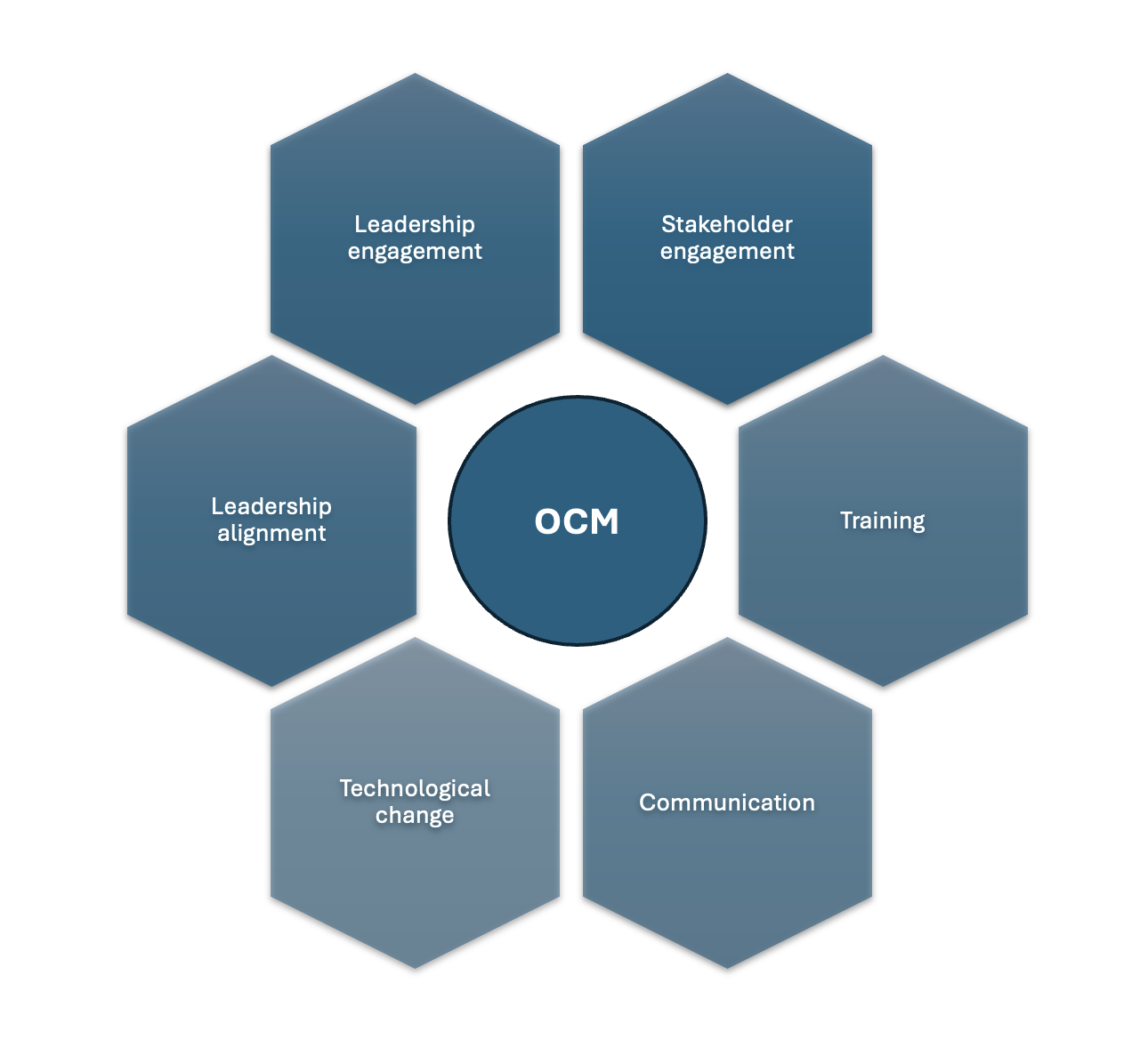
Leadership plays a critical role in driving change within an organization. By championing ongoing training and development initiatives, leaders can set the tone for a culture of continuous learning and improvement. They can also provide the necessary resources and support to ensure that employees have the tools they need to succeed in a rapidly changing workplace. By fostering a culture of adaptability and innovation, leaders can help employees embrace change rather than resist it. This shift in mindset can lead to increased creativity, improved problem-solving skills, and a greater capacity for innovation within the organization.

Chapter 7: Intelligent Automation Technology
In this chapter, we will explore the various forms of intelligent automation technology that leaders can leverage to drive innovation and efficiency within their organizations. From Robotic Process Automation (RPA) to Machine Learning (ML) and Artificial Intelligence (AI), these technologies have the potential to revolutionize the way businesses operate. By understanding the capabilities and benefits of each technology, leaders can make informed decisions on how to best implement them in their own organizations. Additionally, we will discuss the challenges and considerations that come with adopting these technologies and provide strategies for overcoming them to ensure successful implementation.
Selecting the right IA platforms, tools, and technologies is an important part of the IA roadmap. In addition to evaluating vendors and solutions for IA technologies, attention must be paid to integration capabilities with existing systems. A technology selection process should be used to evaluate the capabilities of technology products and services against the functional and non-functional requirements of the business. The technical criteria can be combined with commercial criteria and weighted according to the organization’s priorities. This ensures that the chosen IA technologies not only meet the technical requirements but also fit within the business constraints of the organization.
Understanding the functional capabilities of various technologies is crucial in order to make informed decisions about which ones to implement. Continuously evaluating the capabilities of existing technologies and exploring new options will also enable businesses to stay ahead of the curve and remain competitive in their industry. Non-functional considerations, such as security, scalability, and user experience, are also crucial factors to take into account when implementing new technology solutions. Ensuring that systems are secure and can handle the increased workload as the business grows is essential for long-term success.
Enterprise architecture plays a vital role in ensuring that technology solutions support the organization’s strategic goals. By providing a structured approach to designing and implementing technology systems, enterprise architects can help leaders make informed decisions that will drive automation projects. The roadmap will include creation of a reference technical architecture that provides a blueprint for designing automation solutions. It outlines the necessary components, interfaces, and data flows required to support the organization’s operations.
Data architecture also plays an important role when determining enterprise data requirements for IA solutions. By defining how data is collected, stored, and utilized, data architecture ensures that information flows seamlessly and efficiently throughout the organization. This not only enhances decision-making processes but also enables organizations to leverage their data assets for competitive advantage.

Chapter 8: Lean Agile Development
In this chapter, we will explore how the principles and practices of lean and agile methodologies are used in the development and delivery of solutions in the roadmap. The methodology is based on the principles of lean manufacturing and agile software development, combining the best of both worlds to deliver high-quality solutions quickly and efficiently. By focusing on delivering value to customers through iterative development cycles and constant feedback, lean agile development helps teams adapt to changing requirements and deliver solutions that meet the needs of users
The goal of the process is to quickly develop, validate, and iterate over solutions without substantial upfront commitment of resources and investment. It allows benefit hypotheses to be validated with users to shape the contours of the eventual automation solution. Having a clear and structured process enables prompt adjustments, leading to a smooth and successful development cycle. The process serves as an effective approach to deliver the roadmap and for continuous improvement in the future.
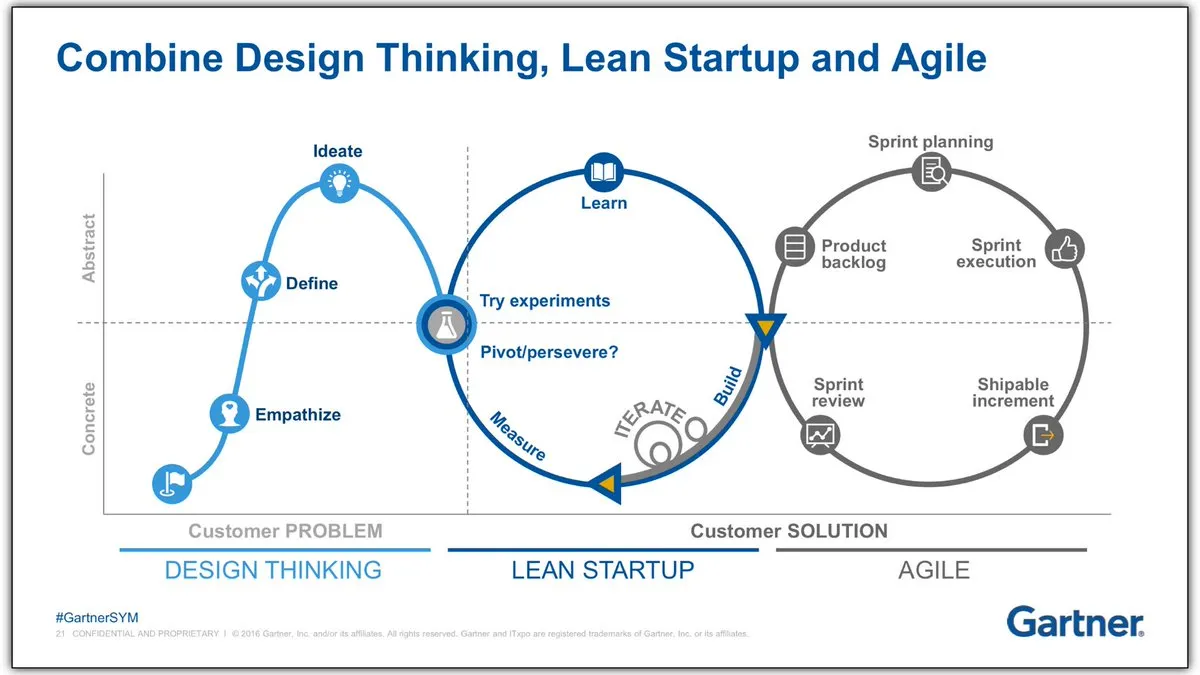
In this approach, value-driven development ensures that the project stays aligned with the overall goals and objectives, maximizing the value delivered to stakeholders. By consistently prioritizing features and functionalities based on their importance and impact, the organization can focus on delivering the most valuable components first. This not only streamlines the development process but also ensures that resources are utilized efficiently, leading to a more cost-effective and successful project outcome. With value stream mapping, teams can identify bottlenecks and areas for improvement.
By actively involving users and stakeholders in the development process, teams can ensure that the solutions they are creating truly meet the needs and expectations of the end users. This approach allows for adjustments to be made in real-time based on direct feedback, leading to a more customer-centric final product. By prioritizing customer development alongside value-driven development, organizations can be confident that their IA solutions will not only be technically sound but also highly valuable and impactful for their target audience.
Agile delivery plays a crucial role in this process, allowing teams to quickly iterate and adapt to feedback, ensuring that the final product is not only customer-centric but also delivered in a timely manner. Depending on the size and scale of the automation project as well as the maturity of the Agile capability within the organization, principles, and features of the Scaled Agile Framework (SAFe) may also be used in the project delivery process.

Chapter 9: Measuring Value
Measuring the value of IA solutions is essential for determining their effectiveness and impact on business goals. This chapter will explore the importance of various metrics and methods for evaluating the success of IA solutions, including key performance indicators (KPIs), return on investment (ROI) analysis, and customer satisfaction surveys. By tracking and analyzing these metrics, organizations can make informed decisions about the future direction of their IA initiatives and ensure that they are delivering tangible value to their stakeholders. Additionally, measuring value can help teams identify areas for improvement and optimization, leading to even greater success in the long run.
Monitoring KPIs allows companies to make data-driven decisions and optimize the impact of their IA projects. KPIs provide valuable insights into the effectiveness of IA solutions and allow companies to measure their progress towards achieving their goals. By measuring KPIs related to process efficiency and cost savings, organizations can identify areas where improvements can be made to streamline operations and reduce expenses.
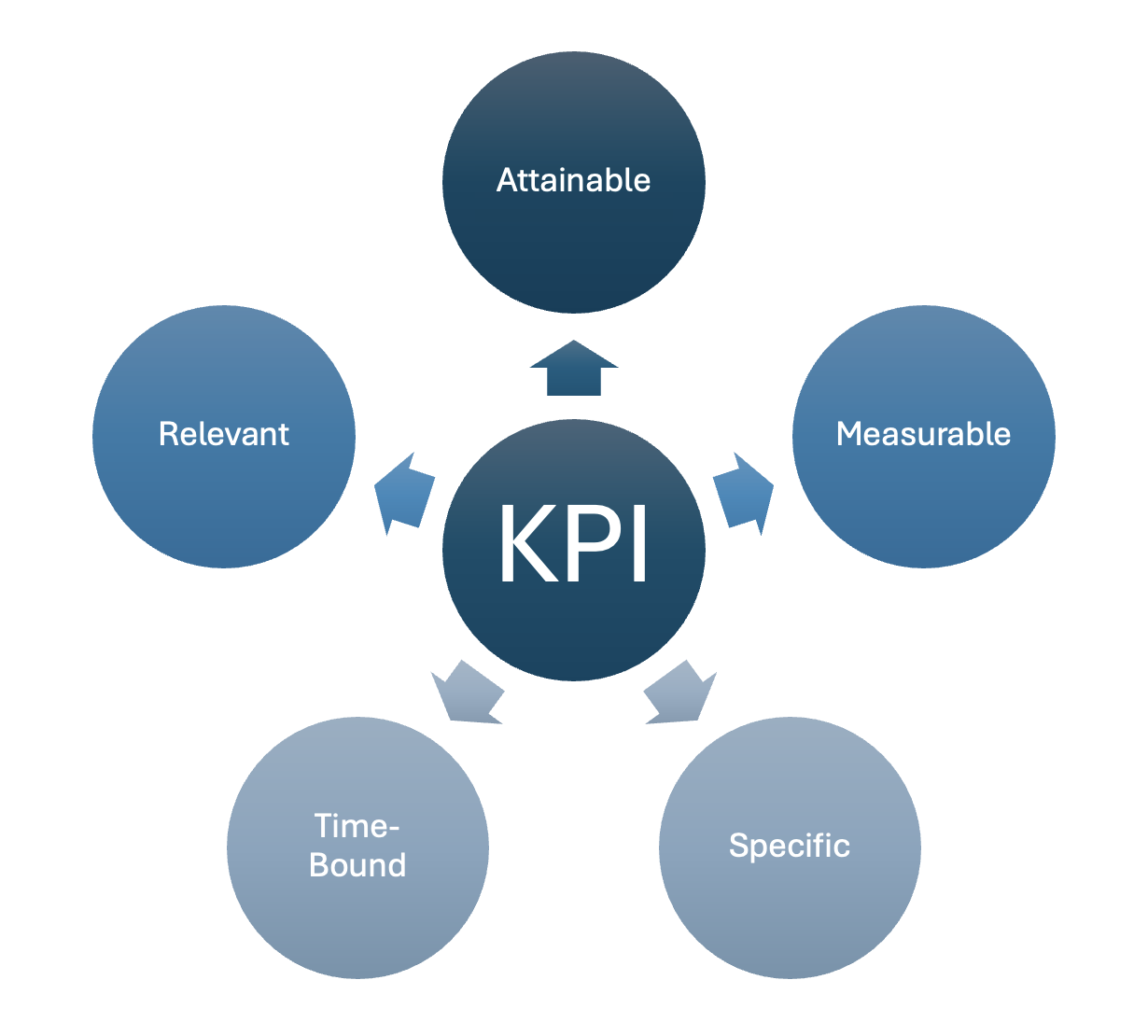
By setting KPIs related to accuracy and error reduction, companies can ensure that their automated processes are not only efficient but also reliable. This can lead to improved customer satisfaction as well as reduced rework and potential financial losses.
A continuous measurement framework can help companies track the automation KPIs and make adjustments as needed. This framework allows organizations to constantly monitor their processes and make informed decisions based on real-time data. It also provides the necessary performance data for executive dashboards and reporting of automation capabilities.

Chapter 10: Roadmap Delivery
In Chapter 10, we will delve into how the roadmap is to be realized in practice. We will explore the various stages in the timeline of an automation project. The initial stages of the roadmap will focus on the discovery of the automation solution scope. And planning In subsequent stages, clear milestones will be set for pilot development and for scaling up of IA solutions. Throughout the plan, quick wins will be prioritized to build momentum.
Having a detailed implementation timeline broken down into stages not only streamlines the deployment of IA but also helps in identifying potential roadblocks or areas that need additional support. By staying organized and focused on the timeline, companies can ensure a smooth and successful integration of IA technology into their operations. A large transformation initiative such as this requires strong program management. An agile approach to program management such as that in the Scaled Agile Framework (SAFe) can help manage the program at enterprise and portfolio levels. The Agile delivery approach will be used for development and delivery as epics and features are created.
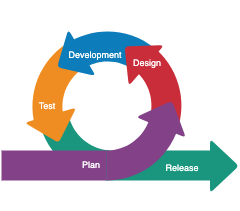
Piloting solutions before full-blown deployment is a key strategy that is used to test the feasibility and effectiveness of IA technology in a controlled environment. By starting with a small-scale pilot project, companies can identify any potential challenges or obstacles early on and make necessary adjustments to ensure a successful rollout. This approach also allows for feedback from users and stakeholders, helping to fine-tune the technology to better meet the specific needs of the organization.
Once the pilot project has been completed and any issues have been addressed, companies can then begin to scale out the IA technology across different departments or locations within the organization. This gradual expansion allows for a more seamless integration of the technology and gives employees time to adapt to the changes. By taking a measured approach to scaling out IA technology, companies can minimize disruption to daily operations and maximize the benefits of automation and efficiency.

Chapter 11: Continuous Improvement
Continuous improvement is key to the long-term success of IA technology within an organization. Once the initial implementation phase is complete, it is important to continuously assess and improve upon the technology to ensure it is meeting the needs of the business. This can involve gathering feedback from employees, analyzing performance metrics, and making necessary adjustments to the IA system. The roadmap must include the establishment of processes that enable long-term sustainability and growth of the IA technology
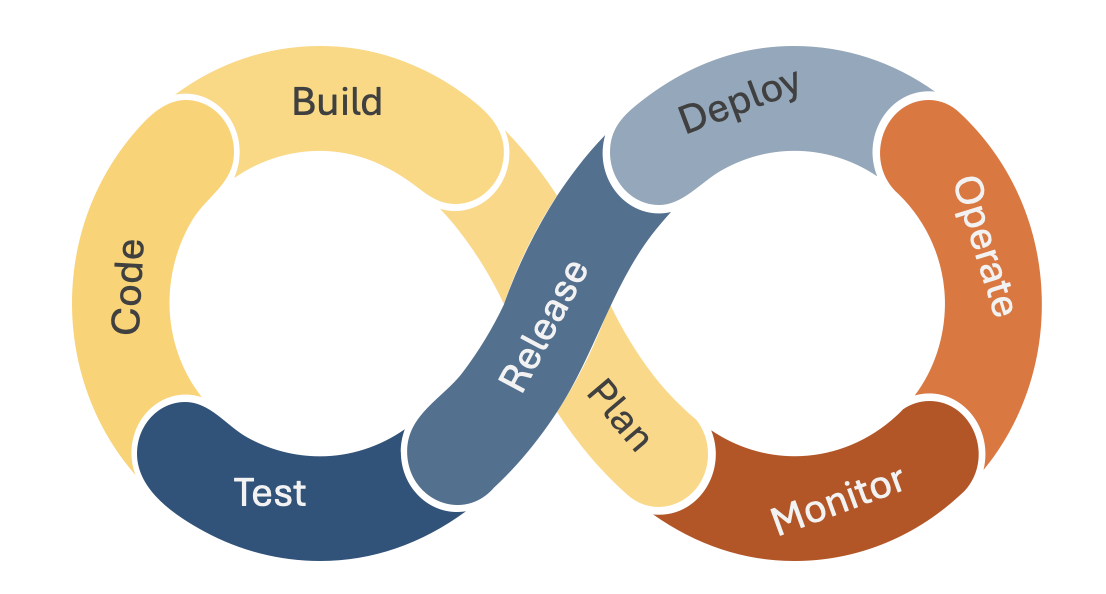
Automation technologies are continuously evolving, so companies must explore new technical capabilities and stay at the forefront of innovation in the industry. Collaboration with external partners and experts can also bring fresh perspectives and insights to further enhance IA solutions. Monitoring of existing processes must be continued with process mining and other analytical methods to identify inefficiencies and new opportunities for automation. This ongoing monitoring and improvement cycle will help businesses optimize operations and streamline workflows.
Fostering a continuous improvement culture within the organization will ensure that employees are constantly seeking ways to enhance efficiency and effectiveness in their work. Encouraging innovation and adaptability helps businesses adapt to changing business requirements.
Implementing a continuous improvement framework can help formalize the process of identifying and implementing changes within the organization. This framework should include regular performance evaluations, feedback mechanisms, and structured issue-tracking processes. By establishing a systematic approach to improvement, employees will have clear guidelines and support for their efforts to innovate and enhance the automation capabilities.

Chapter 12: Adoption and Industry Trends
Finally, in this chapter, we will explore how the roadmap can include the ability to expand the adoption of automation solutions and adapt to industry trends to stay ahead of the competition. Adoption is increased through greater awareness and by more active engagement of the stakeholders and the user community. Through strategic partnerships and a willingness to embrace new ideas, companies can leverage industry trends to drive growth and achieve long-term sustainability. Additionally, we will discuss the importance of staying agile and responsive to evolving business demands to remain competitive in today’s dynamic business landscape.
Driving Adoption involves educating employees on the benefits of automation, providing training on new technologies, and creating a culture that embraces change and innovation. By fostering a supportive environment, companies can encourage the widespread adoption of automation tools and processes throughout the organization. In order to drive adoption effectively, it is important for companies to communicate the value of automation, address any concerns or resistance, and provide ongoing support and resources for implementation.
It is also crucial for companies to consider the risks and ethical implications of implementing automation. This includes ensuring data security and privacy, as well as addressing potential job displacement and the impact on employees. By carefully considering these factors and implementing appropriate safeguards, companies can minimize potential negative consequences and ensure that automation is implemented in a responsible and sustainable manner.
By embedding IA into the organizational culture, companies can ensure that they are constantly adapting to new trends and technologies. A successful automation strategy should include ongoing governance, updating IA technologies, and continually re-assessing processes for further automation opportunities.
AI and machine learning will continue to drive industry trends in process automation, with advancements such as predictive analytics for operational efficiency and natural language processing for enhanced customer interactions leading the way in transforming business operations. Generative AI and Artificial General Intelligence (AGI) will allow for the creation of more advanced and adaptable systems. These technologies have the potential to revolutionize the way businesses operate, enabling them to make more informed decisions and adapt to changing circumstances in real-time. As companies continue to embrace these advancements in automation, they will be able to create new avenues for improving business processes.
Curriculum
Intelligent Automation – WDP1 – Roadmap for Success
- Strategy and Vision
- Readiness Assessment
- Cross-functional CoE
- Use Case Discovery
- Target Operating Model
- Organizational Change Management (OCM)
- Intelligent Automation Technology
- Lean Agile Development
- Measuring Value
- Roadmap Delivery
- Continuous Improvement
- Adoption and Industry Trends
Distance Learning
Introduction
Welcome to Appleton Greene and thank you for enrolling on the Intelligent Automation corporate training program. You will be learning through our unique facilitation via distance-learning method, which will enable you to practically implement everything that you learn academically. The methods and materials used in your program have been designed and developed to ensure that you derive the maximum benefits and enjoyment possible. We hope that you find the program challenging and fun to do. However, if you have never been a distance-learner before, you may be experiencing some trepidation at the task before you. So we will get you started by giving you some basic information and guidance on how you can make the best use of the modules, how you should manage the materials and what you should be doing as you work through them. This guide is designed to point you in the right direction and help you to become an effective distance-learner. Take a few hours or so to study this guide and your guide to tutorial support for students, while making notes, before you start to study in earnest.
Study environment
You will need to locate a quiet and private place to study, preferably a room where you can easily be isolated from external disturbances or distractions. Make sure the room is well-lit and incorporates a relaxed, pleasant feel. If you can spoil yourself within your study environment, you will have much more of a chance to ensure that you are always in the right frame of mind when you do devote time to study. For example, a nice fire, the ability to play soft soothing background music, soft but effective lighting, perhaps a nice view if possible and a good size desk with a comfortable chair. Make sure that your family know when you are studying and understand your study rules. Your study environment is very important. The ideal situation, if at all possible, is to have a separate study, which can be devoted to you. If this is not possible then you will need to pay a lot more attention to developing and managing your study schedule, because it will affect other people as well as yourself. The better your study environment, the more productive you will be.
Study tools & rules
Try and make sure that your study tools are sufficient and in good working order. You will need to have access to a computer, scanner and printer, with access to the internet. You will need a very comfortable chair, which supports your lower back, and you will need a good filing system. It can be very frustrating if you are spending valuable study time trying to fix study tools that are unreliable, or unsuitable for the task. Make sure that your study tools are up to date. You will also need to consider some study rules. Some of these rules will apply to you and will be intended to help you to be more disciplined about when and how you study. This distance-learning guide will help you and after you have read it you can put some thought into what your study rules should be. You will also need to negotiate some study rules for your family, friends or anyone who lives with you. They too will need to be disciplined in order to ensure that they can support you while you study. It is important to ensure that your family and friends are an integral part of your study team. Having their support and encouragement can prove to be a crucial contribution to your successful completion of the program. Involve them in as much as you can.
Successful distance-learning
Distance-learners are freed from the necessity of attending regular classes or workshops, since they can study in their own way, at their own pace and for their own purposes. But unlike traditional internal training courses, it is the student’s responsibility, with a distance-learning program, to ensure that they manage their own study contribution. This requires strong self-discipline and self-motivation skills and there must be a clear will to succeed. Those students who are used to managing themselves, are good at managing others and who enjoy working in isolation, are more likely to be good distance-learners. It is also important to be aware of the main reasons why you are studying and of the main objectives that you are hoping to achieve as a result. You will need to remind yourself of these objectives at times when you need to motivate yourself. Never lose sight of your long-term goals and your short-term objectives. There is nobody available here to pamper you, or to look after you, or to spoon-feed you with information, so you will need to find ways to encourage and appreciate yourself while you are studying. Make sure that you chart your study progress, so that you can be sure of your achievements and re-evaluate your goals and objectives regularly.
Self-assessment
Appleton Greene training programs are in all cases post-graduate programs. Consequently, you should already have obtained a business-related degree and be an experienced learner. You should therefore already be aware of your study strengths and weaknesses. For example, which time of the day are you at your most productive? Are you a lark or an owl? What study methods do you respond to the most? Are you a consistent learner? How do you discipline yourself? How do you ensure that you enjoy yourself while studying? It is important to understand yourself as a learner and so some self-assessment early on will be necessary if you are to apply yourself correctly. Perform a SWOT analysis on yourself as a student. List your internal strengths and weaknesses as a student and your external opportunities and threats. This will help you later on when you are creating a study plan. You can then incorporate features within your study plan that can ensure that you are playing to your strengths, while compensating for your weaknesses. You can also ensure that you make the most of your opportunities, while avoiding the potential threats to your success.
Accepting responsibility as a student
Training programs invariably require a significant investment, both in terms of what they cost and in the time that you need to contribute to study and the responsibility for successful completion of training programs rests entirely with the student. This is never more apparent than when a student is learning via distance-learning. Accepting responsibility as a student is an important step towards ensuring that you can successfully complete your training program. It is easy to instantly blame other people or factors when things go wrong. But the fact of the matter is that if a failure is your failure, then you have the power to do something about it, it is entirely in your own hands. If it is always someone else’s failure, then you are powerless to do anything about it. All students study in entirely different ways, this is because we are all individuals and what is right for one student, is not necessarily right for another. In order to succeed, you will have to accept personal responsibility for finding a way to plan, implement and manage a personal study plan that works for you. If you do not succeed, you only have yourself to blame.
Planning
By far the most critical contribution to stress, is the feeling of not being in control. In the absence of planning we tend to be reactive and can stumble from pillar to post in the hope that things will turn out fine in the end. Invariably they don’t! In order to be in control, we need to have firm ideas about how and when we want to do things. We also need to consider as many possible eventualities as we can, so that we are prepared for them when they happen. Prescriptive Change, is far easier to manage and control, than Emergent Change. The same is true with distance-learning. It is much easier and much more enjoyable, if you feel that you are in control and that things are going to plan. Even when things do go wrong, you are prepared for them and can act accordingly without any unnecessary stress. It is important therefore that you do take time to plan your studies properly.
Management
Once you have developed a clear study plan, it is of equal importance to ensure that you manage the implementation of it. Most of us usually enjoy planning, but it is usually during implementation when things go wrong. Targets are not met and we do not understand why. Sometimes we do not even know if targets are being met. It is not enough for us to conclude that the study plan just failed. If it is failing, you will need to understand what you can do about it. Similarly if your study plan is succeeding, it is still important to understand why, so that you can improve upon your success. You therefore need to have guidelines for self-assessment so that you can be consistent with performance improvement throughout the program. If you manage things correctly, then your performance should constantly improve throughout the program.
Study objectives & tasks
The first place to start is developing your program objectives. These should feature your reasons for undertaking the training program in order of priority. Keep them succinct and to the point in order to avoid confusion. Do not just write the first things that come into your head because they are likely to be too similar to each other. Make a list of possible departmental headings, such as: Customer Service; E-business; Finance; Globalization; Human Resources; Technology; Legal; Management; Marketing and Production. Then brainstorm for ideas by listing as many things that you want to achieve under each heading and later re-arrange these things in order of priority. Finally, select the top item from each department heading and choose these as your program objectives. Try and restrict yourself to five because it will enable you to focus clearly. It is likely that the other things that you listed will be achieved if each of the top objectives are achieved. If this does not prove to be the case, then simply work through the process again.
Study forecast
As a guide, the Appleton Greene Intelligent Automation corporate training program should take 12-18 months to complete, depending upon your availability and current commitments. The reason why there is such a variance in time estimates is because every student is an individual, with differing productivity levels and different commitments. These differentiations are then exaggerated by the fact that this is a distance-learning program, which incorporates the practical integration of academic theory as an as a part of the training program. Consequently all of the project studies are real, which means that important decisions and compromises need to be made. You will want to get things right and will need to be patient with your expectations in order to ensure that they are. We would always recommend that you are prudent with your own task and time forecasts, but you still need to develop them and have a clear indication of what are realistic expectations in your case. With reference to your time planning: consider the time that you can realistically dedicate towards study with the program every week; calculate how long it should take you to complete the program, using the guidelines featured here; then break the program down into logical modules and allocate a suitable proportion of time to each of them, these will be your milestones; you can create a time plan by using a spreadsheet on your computer, or a personal organizer such as MS Outlook, you could also use a financial forecasting software; break your time forecasts down into manageable chunks of time, the more specific you can be, the more productive and accurate your time management will be; finally, use formulas where possible to do your time calculations for you, because this will help later on when your forecasts need to change in line with actual performance. With reference to your task planning: refer to your list of tasks that need to be undertaken in order to achieve your program objectives; with reference to your time plan, calculate when each task should be implemented; remember that you are not estimating when your objectives will be achieved, but when you will need to focus upon implementing the corresponding tasks; you also need to ensure that each task is implemented in conjunction with the associated training modules which are relevant; then break each single task down into a list of specific to do’s, say approximately ten to do’s for each task and enter these into your study plan; once again you could use MS Outlook to incorporate both your time and task planning and this could constitute your study plan; you could also use a project management software like MS Project. You should now have a clear and realistic forecast detailing when you can expect to be able to do something about undertaking the tasks to achieve your program objectives.
Performance management
It is one thing to develop your study forecast, it is quite another to monitor your progress. Ultimately it is less important whether you achieve your original study forecast and more important that you update it so that it constantly remains realistic in line with your performance. As you begin to work through the program, you will begin to have more of an idea about your own personal performance and productivity levels as a distance-learner. Once you have completed your first study module, you should re-evaluate your study forecast for both time and tasks, so that they reflect your actual performance level achieved. In order to achieve this you must first time yourself while training by using an alarm clock. Set the alarm for hourly intervals and make a note of how far you have come within that time. You can then make a note of your actual performance on your study plan and then compare your performance against your forecast. Then consider the reasons that have contributed towards your performance level, whether they are positive or negative and make a considered adjustment to your future forecasts as a result. Given time, you should start achieving your forecasts regularly.
With reference to time management: time yourself while you are studying and make a note of the actual time taken in your study plan; consider your successes with time-efficiency and the reasons for the success in each case and take this into consideration when reviewing future time planning; consider your failures with time-efficiency and the reasons for the failures in each case and take this into consideration when reviewing future time planning; re-evaluate your study forecast in relation to time planning for the remainder of your training program to ensure that you continue to be realistic about your time expectations. You need to be consistent with your time management, otherwise you will never complete your studies. This will either be because you are not contributing enough time to your studies, or you will become less efficient with the time that you do allocate to your studies. Remember, if you are not in control of your studies, they can just become yet another cause of stress for you.
With reference to your task management: time yourself while you are studying and make a note of the actual tasks that you have undertaken in your study plan; consider your successes with task-efficiency and the reasons for the success in each case; take this into consideration when reviewing future task planning; consider your failures with task-efficiency and the reasons for the failures in each case and take this into consideration when reviewing future task planning; re-evaluate your study forecast in relation to task planning for the remainder of your training program to ensure that you continue to be realistic about your task expectations. You need to be consistent with your task management, otherwise you will never know whether you are achieving your program objectives or not.
Keeping in touch
You will have access to qualified and experienced professors and tutors who are responsible for providing tutorial support for your particular training program. So don’t be shy about letting them know how you are getting on. We keep electronic records of all tutorial support emails so that professors and tutors can review previous correspondence before considering an individual response. It also means that there is a record of all communications between you and your professors and tutors and this helps to avoid any unnecessary duplication, misunderstanding, or misinterpretation. If you have a problem relating to the program, share it with them via email. It is likely that they have come across the same problem before and are usually able to make helpful suggestions and steer you in the right direction. To learn more about when and how to use tutorial support, please refer to the Tutorial Support section of this student information guide. This will help you to ensure that you are making the most of tutorial support that is available to you and will ultimately contribute towards your success and enjoyment with your training program.
Work colleagues and family
You should certainly discuss your program study progress with your colleagues, friends and your family. Appleton Greene training programs are very practical. They require you to seek information from other people, to plan, develop and implement processes with other people and to achieve feedback from other people in relation to viability and productivity. You will therefore have plenty of opportunities to test your ideas and enlist the views of others. People tend to be sympathetic towards distance-learners, so don’t bottle it all up in yourself. Get out there and share it! It is also likely that your family and colleagues are going to benefit from your labors with the program, so they are likely to be much more interested in being involved than you might think. Be bold about delegating work to those who might benefit themselves. This is a great way to achieve understanding and commitment from people who you may later rely upon for process implementation. Share your experiences with your friends and family.
Making it relevant
The key to successful learning is to make it relevant to your own individual circumstances. At all times you should be trying to make bridges between the content of the program and your own situation. Whether you achieve this through quiet reflection or through interactive discussion with your colleagues, client partners or your family, remember that it is the most important and rewarding aspect of translating your studies into real self-improvement. You should be clear about how you want the program to benefit you. This involves setting clear study objectives in relation to the content of the course in terms of understanding, concepts, completing research or reviewing activities and relating the content of the modules to your own situation. Your objectives may understandably change as you work through the program, in which case you should enter the revised objectives on your study plan so that you have a permanent reminder of what you are trying to achieve, when and why.
Distance-learning check-list
Prepare your study environment, your study tools and rules.
Undertake detailed self-assessment in terms of your ability as a learner.
Create a format for your study plan.
Consider your study objectives and tasks.
Create a study forecast.
Assess your study performance.
Re-evaluate your study forecast.
Be consistent when managing your study plan.
Use your Appleton Greene Certified Learning Provider (CLP) for tutorial support.
Make sure you keep in touch with those around you.

Tutorial Support
Programs
Appleton Greene uses standard and bespoke corporate training programs as vessels to transfer business process improvement knowledge into the heart of our clients’ organizations. Each individual program focuses upon the implementation of a specific business process, which enables clients to easily quantify their return on investment. There are hundreds of established Appleton Greene corporate training products now available to clients within customer services, e-business, finance, globalization, human resources, information technology, legal, management, marketing and production. It does not matter whether a client’s employees are located within one office, or an unlimited number of international offices, we can still bring them together to learn and implement specific business processes collectively. Our approach to global localization enables us to provide clients with a truly international service with that all important personal touch. Appleton Greene corporate training programs can be provided virtually or locally and they are all unique in that they individually focus upon a specific business function. They are implemented over a sustainable period of time and professional support is consistently provided by qualified learning providers and specialist consultants.
Support available
You will have a designated Certified Learning Provider (CLP) and an Accredited Consultant and we encourage you to communicate with them as much as possible. In all cases tutorial support is provided online because we can then keep a record of all communications to ensure that tutorial support remains consistent. You would also be forwarding your work to the tutorial support unit for evaluation and assessment. You will receive individual feedback on all of the work that you undertake on a one-to-one basis, together with specific recommendations for anything that may need to be changed in order to achieve a pass with merit or a pass with distinction and you then have as many opportunities as you may need to re-submit project studies until they meet with the required standard. Consequently the only reason that you should really fail (CLP) is if you do not do the work. It makes no difference to us whether a student takes 12 months or 18 months to complete the program, what matters is that in all cases the same quality standard will have been achieved.
Support Process
Please forward all of your future emails to the designated (CLP) Tutorial Support Unit email address that has been provided and please do not duplicate or copy your emails to other AGC email accounts as this will just cause unnecessary administration. Please note that emails are always answered as quickly as possible but you will need to allow a period of up to 20 business days for responses to general tutorial support emails during busy periods, because emails are answered strictly within the order in which they are received. You will also need to allow a period of up to 30 business days for the evaluation and assessment of project studies. This does not include weekends or public holidays. Please therefore kindly allow for this within your time planning. All communications are managed online via email because it enables tutorial service support managers to review other communications which have been received before responding and it ensures that there is a copy of all communications retained on file for future reference. All communications will be stored within your personal (CLP) study file here at Appleton Greene throughout your designated study period. If you need any assistance or clarification at any time, please do not hesitate to contact us by forwarding an email and remember that we are here to help. If you have any questions, please list and number your questions succinctly and you can then be sure of receiving specific answers to each and every query.
Time Management
It takes approximately 1 Year to complete the Intelligent Automation corporate training program, incorporating 12 x 6-hour monthly workshops. Each student will also need to contribute approximately 4 hours per week over 1 Year of their personal time. Students can study from home or work at their own pace and are responsible for managing their own study plan. There are no formal examinations and students are evaluated and assessed based upon their project study submissions, together with the quality of their internal analysis and supporting documents. They can contribute more time towards study when they have the time to do so and can contribute less time when they are busy. All students tend to be in full time employment while studying and the Intelligent Automation program is purposely designed to accommodate this, so there is plenty of flexibility in terms of time management. It makes no difference to us at Appleton Greene, whether individuals take 12-18 months to complete this program. What matters is that in all cases the same standard of quality will have been achieved with the standard and bespoke programs that have been developed.
Distance Learning Guide
The distance learning guide should be your first port of call when starting your training program. It will help you when you are planning how and when to study, how to create the right environment and how to establish the right frame of mind. If you can lay the foundations properly during the planning stage, then it will contribute to your enjoyment and productivity while training later. The guide helps to change your lifestyle in order to accommodate time for study and to cultivate good study habits. It helps you to chart your progress so that you can measure your performance and achieve your goals. It explains the tools that you will need for study and how to make them work. It also explains how to translate academic theory into practical reality. Spend some time now working through your distance learning guide and make sure that you have firm foundations in place so that you can make the most of your distance learning program. There is no requirement for you to attend training workshops or classes at Appleton Greene offices. The entire program is undertaken online, program course manuals and project studies are administered via the Appleton Greene web site and via email, so you are able to study at your own pace and in the comfort of your own home or office as long as you have a computer and access to the internet.
How To Study
The how to study guide provides students with a clear understanding of the Appleton Greene facilitation via distance learning training methods and enables students to obtain a clear overview of the training program content. It enables students to understand the step-by-step training methods used by Appleton Greene and how course manuals are integrated with project studies. It explains the research and development that is required and the need to provide evidence and references to support your statements. It also enables students to understand precisely what will be required of them in order to achieve a pass with merit and a pass with distinction for individual project studies and provides useful guidance on how to be innovative and creative when developing your Unique Program Proposition (UPP).
Tutorial Support
Tutorial support for the Appleton Greene Intelligent Automation corporate training program is provided online either through the Appleton Greene Client Support Portal (CSP), or via email. All tutorial support requests are facilitated by a designated Program Administration Manager (PAM). They are responsible for deciding which professor or tutor is the most appropriate option relating to the support required and then the tutorial support request is forwarded onto them. Once the professor or tutor has completed the tutorial support request and answered any questions that have been asked, this communication is then returned to the student via email by the designated Program Administration Manager (PAM). This enables all tutorial support, between students, professors and tutors, to be facilitated by the designated Program Administration Manager (PAM) efficiently and securely through the email account. You will therefore need to allow a period of up to 20 business days for responses to general support queries and up to 30 business days for the evaluation and assessment of project studies, because all tutorial support requests are answered strictly within the order in which they are received. This does not include weekends or public holidays. Consequently you need to put some thought into the management of your tutorial support procedure in order to ensure that your study plan is feasible and to obtain the maximum possible benefit from tutorial support during your period of study. Please retain copies of your tutorial support emails for future reference. Please ensure that ALL of your tutorial support emails are set out using the format as suggested within your guide to tutorial support. Your tutorial support emails need to be referenced clearly to the specific part of the course manual or project study which you are working on at any given time. You also need to list and number any questions that you would like to ask, up to a maximum of five questions within each tutorial support email. Remember the more specific you can be with your questions the more specific your answers will be too and this will help you to avoid any unnecessary misunderstanding, misinterpretation, or duplication. The guide to tutorial support is intended to help you to understand how and when to use support in order to ensure that you get the most out of your training program. Appleton Greene training programs are designed to enable you to do things for yourself. They provide you with a structure or a framework and we use tutorial support to facilitate students while they practically implement what they learn. In other words, we are enabling students to do things for themselves. The benefits of distance learning via facilitation are considerable and are much more sustainable in the long-term than traditional short-term knowledge sharing programs. Consequently you should learn how and when to use tutorial support so that you can maximize the benefits from your learning experience with Appleton Greene. This guide describes the purpose of each training function and how to use them and how to use tutorial support in relation to each aspect of the training program. It also provides useful tips and guidance with regard to best practice.
Tutorial Support Tips
Students are often unsure about how and when to use tutorial support with Appleton Greene. This Tip List will help you to understand more about how to achieve the most from using tutorial support. Refer to it regularly to ensure that you are continuing to use the service properly. Tutorial support is critical to the success of your training experience, but it is important to understand when and how to use it in order to maximize the benefit that you receive. It is no coincidence that those students who succeed are those that learn how to be positive, proactive and productive when using tutorial support.
Be positive and friendly with your tutorial support emails
Remember that if you forward an email to the tutorial support unit, you are dealing with real people. “Do unto others as you would expect others to do unto you”. If you are positive, complimentary and generally friendly in your emails, you will generate a similar response in return. This will be more enjoyable, productive and rewarding for you in the long-term.
Think about the impression that you want to create
Every time that you communicate, you create an impression, which can be either positive or negative, so put some thought into the impression that you want to create. Remember that copies of all tutorial support emails are stored electronically and tutors will always refer to prior correspondence before responding to any current emails. Over a period of time, a general opinion will be arrived at in relation to your character, attitude and ability. Try to manage your own frustrations, mood swings and temperament professionally, without involving the tutorial support team. Demonstrating frustration or a lack of patience is a weakness and will be interpreted as such. The good thing about communicating in writing, is that you will have the time to consider your content carefully, you can review it and proof-read it before sending your email to Appleton Greene and this should help you to communicate more professionally, consistently and to avoid any unnecessary knee-jerk reactions to individual situations as and when they may arise. Please also remember that the CLP Tutorial Support Unit will not just be responsible for evaluating and assessing the quality of your work, they will also be responsible for providing recommendations to other learning providers and to client contacts within the Appleton Greene global client network, so do be in control of your own emotions and try to create a good impression.
Remember that quality is preferred to quantity
Please remember that when you send an email to the tutorial support team, you are not using Twitter or Text Messaging. Try not to forward an email every time that you have a thought. This will not prove to be productive either for you or for the tutorial support team. Take time to prepare your communications properly, as if you were writing a professional letter to a business colleague and make a list of queries that you are likely to have and then incorporate them within one email, say once every month, so that the tutorial support team can understand more about context, application and your methodology for study. Get yourself into a consistent routine with your tutorial support requests and use the tutorial support template provided with ALL of your emails. The (CLP) Tutorial Support Unit will not spoon-feed you with information. They need to be able to evaluate and assess your tutorial support requests carefully and professionally.
Be specific about your questions in order to receive specific answers
Try not to write essays by thinking as you are writing tutorial support emails. The tutorial support unit can be unclear about what in fact you are asking, or what you are looking to achieve. Be specific about asking questions that you want answers to. Number your questions. You will then receive specific answers to each and every question. This is the main purpose of tutorial support via email.
Keep a record of your tutorial support emails
It is important that you keep a record of all tutorial support emails that are forwarded to you. You can then refer to them when necessary and it avoids any unnecessary duplication, misunderstanding, or misinterpretation.
Individual training workshops or telephone support
Please be advised that Appleton Greene does not provide separate or individual tutorial support meetings, workshops, or provide telephone support for individual students. Appleton Greene is an equal opportunities learning and service provider and we are therefore understandably bound to treat all students equally. We cannot therefore broker special financial or study arrangements with individual students regardless of the circumstances. All tutorial support is provided online and this enables Appleton Greene to keep a record of all communications between students, professors and tutors on file for future reference, in accordance with our quality management procedure and your terms and conditions of enrolment. All tutorial support is provided online via email because it enables us to have time to consider support content carefully, it ensures that you receive a considered and detailed response to your queries. You can number questions that you would like to ask, which relate to things that you do not understand or where clarification may be required. You can then be sure of receiving specific answers to each individual query. You will also then have a record of these communications and of all tutorial support, which has been provided to you. This makes tutorial support administration more productive by avoiding any unnecessary duplication, misunderstanding, or misinterpretation.
Tutorial Support Email Format
You should use this tutorial support format if you need to request clarification or assistance while studying with your training program. Please note that ALL of your tutorial support request emails should use the same format. You should therefore set up a standard email template, which you can then use as and when you need to. Emails that are forwarded to Appleton Greene, which do not use the following format, may be rejected and returned to you by the (CLP) Program Administration Manager. A detailed response will then be forwarded to you via email usually within 20 business days of receipt for general support queries and 30 business days for the evaluation and assessment of project studies. This does not include weekends or public holidays. Your tutorial support request, together with the corresponding TSU reply, will then be saved and stored within your electronic TSU file at Appleton Greene for future reference.
Subject line of your email
Please insert: Appleton Greene (CLP) Tutorial Support Request: (Your Full Name) (Date), within the subject line of your email.
Main body of your email
Please insert:
1. Appleton Greene Certified Learning Provider (CLP) Tutorial Support Request
2. Your Full Name
3. Date of TS request
4. Preferred email address
5. Backup email address
6. Course manual page name or number (reference)
7. Project study page name or number (reference)
Subject of enquiry
Please insert a maximum of 50 words (please be succinct)
Briefly outline the subject matter of your inquiry, or what your questions relate to.
Question 1
Maximum of 50 words (please be succinct)
Maximum of 50 words (please be succinct)
Question 3
Maximum of 50 words (please be succinct)
Question 4
Maximum of 50 words (please be succinct)
Question 5
Maximum of 50 words (please be succinct)
Please note that a maximum of 5 questions is permitted with each individual tutorial support request email.
Procedure
* List the questions that you want to ask first, then re-arrange them in order of priority. Make sure that you reference them, where necessary, to the course manuals or project studies.
* Make sure that you are specific about your questions and number them. Try to plan the content within your emails to make sure that it is relevant.
* Make sure that your tutorial support emails are set out correctly, using the Tutorial Support Email Format provided here.
* Save a copy of your email and incorporate the date sent after the subject title. Keep your tutorial support emails within the same file and in date order for easy reference.
* Allow up to 20 business days for a response to general tutorial support emails and up to 30 business days for the evaluation and assessment of project studies, because detailed individual responses will be made in all cases and tutorial support emails are answered strictly within the order in which they are received.
* Emails can and do get lost. So if you have not received a reply within the appropriate time, forward another copy or a reminder to the tutorial support unit to be sure that it has been received but do not forward reminders unless the appropriate time has elapsed.
* When you receive a reply, save it immediately featuring the date of receipt after the subject heading for easy reference. In most cases the tutorial support unit replies to your questions individually, so you will have a record of the questions that you asked as well as the answers offered. With project studies however, separate emails are usually forwarded by the tutorial support unit, so do keep a record of your own original emails as well.
* Remember to be positive and friendly in your emails. You are dealing with real people who will respond to the same things that you respond to.
* Try not to repeat questions that have already been asked in previous emails. If this happens the tutorial support unit will probably just refer you to the appropriate answers that have already been provided within previous emails.
* If you lose your tutorial support email records you can write to Appleton Greene to receive a copy of your tutorial support file, but a separate administration charge may be levied for this service.

How To Study
Your Certified Learning Provider (CLP) and Accredited Consultant can help you to plan a task list for getting started so that you can be clear about your direction and your priorities in relation to your training program. It is also a good way to introduce yourself to the tutorial support team.
Planning your study environment
Your study conditions are of great importance and will have a direct effect on how much you enjoy your training program. Consider how much space you will have, whether it is comfortable and private and whether you are likely to be disturbed. The study tools and facilities at your disposal are also important to the success of your distance-learning experience. Your tutorial support unit can help with useful tips and guidance, regardless of your starting position. It is important to get this right before you start working on your training program.
Planning your program objectives
It is important that you have a clear list of study objectives, in order of priority, before you start working on your training program. Your tutorial support unit can offer assistance here to ensure that your study objectives have been afforded due consideration and priority.
Planning how and when to study
Distance-learners are freed from the necessity of attending regular classes, since they can study in their own way, at their own pace and for their own purposes. This approach is designed to let you study efficiently away from the traditional classroom environment. It is important however, that you plan how and when to study, so that you are making the most of your natural attributes, strengths and opportunities. Your tutorial support unit can offer assistance and useful tips to ensure that you are playing to your strengths.
Planning your study tasks
You should have a clear understanding of the study tasks that you should be undertaking and the priority associated with each task. These tasks should also be integrated with your program objectives. The distance learning guide and the guide to tutorial support for students should help you here, but if you need any clarification or assistance, please contact your tutorial support unit.
Planning your time
You will need to allocate specific times during your calendar when you intend to study if you are to have a realistic chance of completing your program on time. You are responsible for planning and managing your own study time, so it is important that you are successful with this. Your tutorial support unit can help you with this if your time plan is not working.
Keeping in touch
Consistency is the key here. If you communicate too frequently in short bursts, or too infrequently with no pattern, then your management ability with your studies will be questioned, both by you and by your tutorial support unit. It is obvious when a student is in control and when one is not and this will depend how able you are at sticking with your study plan. Inconsistency invariably leads to in-completion.
Charting your progress
Your tutorial support team can help you to chart your own study progress. Refer to your distance learning guide for further details.
Making it work
To succeed, all that you will need to do is apply yourself to undertaking your training program and interpreting it correctly. Success or failure lies in your hands and your hands alone, so be sure that you have a strategy for making it work. Your Certified Learning Provider (CLP) and Accredited Consultant can guide you through the process of program planning, development and implementation.
Reading methods
Interpretation is often unique to the individual but it can be improved and even quantified by implementing consistent interpretation methods. Interpretation can be affected by outside interference such as family members, TV, or the Internet, or simply by other thoughts which are demanding priority in our minds. One thing that can improve our productivity is using recognized reading methods. This helps us to focus and to be more structured when reading information for reasons of importance, rather than relaxation.
Speed reading
When reading through course manuals for the first time, subconsciously set your reading speed to be just fast enough that you cannot dwell on individual words or tables. With practice, you should be able to read an A4 sheet of paper in one minute. You will not achieve much in the way of a detailed understanding, but your brain will retain a useful overview. This overview will be important later on and will enable you to keep individual issues in perspective with a more generic picture because speed reading appeals to the memory part of the brain. Do not worry about what you do or do not remember at this stage.
Content reading
Once you have speed read everything, you can then start work in earnest. You now need to read a particular section of your course manual thoroughly, by making detailed notes while you read. This process is called Content Reading and it will help to consolidate your understanding and interpretation of the information that has been provided.
Making structured notes on the course manuals
When you are content reading, you should be making detailed notes, which are both structured and informative. Make these notes in a MS Word document on your computer, because you can then amend and update these as and when you deem it to be necessary. List your notes under three headings: 1. Interpretation – 2. Questions – 3. Tasks. The purpose of the 1st section is to clarify your interpretation by writing it down. The purpose of the 2nd section is to list any questions that the issue raises for you. The purpose of the 3rd section is to list any tasks that you should undertake as a result. Anyone who has graduated with a business-related degree should already be familiar with this process.
Organizing structured notes separately
You should then transfer your notes to a separate study notebook, preferably one that enables easy referencing, such as a MS Word Document, a MS Excel Spreadsheet, a MS Access Database, or a personal organizer on your cell phone. Transferring your notes allows you to have the opportunity of cross-checking and verifying them, which assists considerably with understanding and interpretation. You will also find that the better you are at doing this, the more chance you will have of ensuring that you achieve your study objectives.
Question your understanding
Do challenge your understanding. Explain things to yourself in your own words by writing things down.
Clarifying your understanding
If you are at all unsure, forward an email to your tutorial support unit and they will help to clarify your understanding.
Question your interpretation
Do challenge your interpretation. Qualify your interpretation by writing it down.
Clarifying your interpretation
If you are at all unsure, forward an email to your tutorial support unit and they will help to clarify your interpretation.
Qualification Requirements
The student will need to successfully complete the project study and all of the exercises relating to the Intelligent Automation corporate training program, achieving a pass with merit or distinction in each case, in order to qualify as an Accredited Intelligent Automation Specialist (AIAS). All monthly workshops need to be tried and tested within your company. These project studies can be completed in your own time and at your own pace and in the comfort of your own home or office. There are no formal examinations, assessment is based upon the successful completion of the project studies. They are called project studies because, unlike case studies, these projects are not theoretical, they incorporate real program processes that need to be properly researched and developed. The project studies assist us in measuring your understanding and interpretation of the training program and enable us to assess qualification merits. All of the project studies are based entirely upon the content within the training program and they enable you to integrate what you have learnt into your corporate training practice.
Intelligent Automation – Grading Contribution
Project Study – Grading Contribution
Customer Service – 10%
E-business – 05%
Finance – 10%
Globalization – 10%
Human Resources – 10%
Information Technology – 10%
Legal – 05%
Management – 10%
Marketing – 10%
Production – 10%
Education – 05%
Logistics – 05%
TOTAL GRADING – 100%
Qualification grades
A mark of 90% = Pass with Distinction.
A mark of 75% = Pass with Merit.
A mark of less than 75% = Fail.
If you fail to achieve a mark of 75% with a project study, you will receive detailed feedback from the Certified Learning Provider (CLP) and/or Accredited Consultant, together with a list of tasks which you will need to complete, in order to ensure that your project study meets with the minimum quality standard that is required by Appleton Greene. You can then re-submit your project study for further evaluation and assessment. Indeed you can re-submit as many drafts of your project studies as you need to, until such a time as they eventually meet with the required standard by Appleton Greene, so you need not worry about this, it is all part of the learning process.
When marking project studies, Appleton Greene is looking for sufficient evidence of the following:
Pass with merit
A satisfactory level of program understanding
A satisfactory level of program interpretation
A satisfactory level of project study content presentation
A satisfactory level of Unique Program Proposition (UPP) quality
A satisfactory level of the practical integration of academic theory
Pass with distinction
An exceptional level of program understanding
An exceptional level of program interpretation
An exceptional level of project study content presentation
An exceptional level of Unique Program Proposition (UPP) quality
An exceptional level of the practical integration of academic theory
Preliminary Analysis
Books
Lean Enterprise: How High Performance Organizations Innovate at Scale
Hardcover – 3 Jan. 2015
by Jez Humble (Author), Joanne Molesky (Author), Barry O’Reilly MD Mrcog Franzcog (Author)
This book presents Lean and Agile principles and patterns to help you move fast at scale—and demonstrates why and how to apply these methodologies throughout your organization, rather than with just one department or team.
Through case studies, you’ll learn how successful enterprises have rethought everything from governance and financial management to systems architecture and organizational culture in the pursuit of radically improved performance. Adopting Lean will take time and commitment, but it’s vital for harnessing the cultural and technical forces that are accelerating the rate of innovation.
• Discover how Lean focuses on people and teamwork at every level, in contrast to traditional management practices
• Approach problem-solving experimentally, by exploring solutions, testing assumptions, and getting feedback from real users
• Lead and manage large-scale programs in a way that empowers employees, increases the speed and quality of delivery, and lowers costs
• Learn how to implement ideas from the DevOps and Lean Startup movements even in complex, regulated environments
Intelligent Automation: Bridging the Gap between Business and Academia Paperback – 13 Nov. 2023
by Marie Myers (Editor), Carol Brace (Editor), Lila Carden (Editor)
This book addresses the critical questions about the rise, usage, and future of Intelligent Automation practices. It is structured by general personas considered as its primary target audience, ranging from:
• Early-stage practitioners seeking to learn effective management of IA programs
• Established IA practitioners seeking to drive maturity and scale
• Business leaders seeking to understand how to drive business value using IA
• Practitioners or academicians seeking to collaborate
This book is strongly recommended for practitioners seeking to plan, implement, and scale IA practices in their organization and for researchers and students who intend to study strategy, implementation, and management of IA practice to accelerate the digital transformation agenda.
INTELLIGENT AUTOMATION: Learn how to harness Artificial Intelligence to boost business & make our world more human Hardcover – 11 Oct. 2020
by Pascal Bornet (Author), Ian Barkin (Author), Jochen Wirtz (Author)
This is a reference book on Intelligent Automation (IA). This book is for anyone interested in IA – whether you are an experienced practitioner, new to the topic, or simply interested in what the future holds for enterprises, work, life, and society as a whole. Key content of the book: (1) What is Intelligent Automation (IA)? Why has the use of IA been expanding so rapidly? What are the benefits it unleashes for employees, companies, customers, and society? (2) How have leading organizations been able to harness the full potential of IA, at scale, and generate massive efficiency gains in the range of 20 to 60%? (3) How can IA save 10+ million lives per year, triple our global budget for education, eliminate hunger, help protect our planet, or increase the resilience of society to pandemics and crises?
What you will get from this book: (1) Get the lessons learned from 100+ IA transformation successes (and failures). (2) Benefit from the largest publicly available library of 500+ IA use cases by industry and by business function. (3) Gain access to insights garnered from 200+ IA industry experts. Read more about this book: www.intelligentautomationbook.com
Online Articles
Analyst organizations are regularly publishing blog articles on Intelligent Automation. Here are a few recommended for workshop participants.
McKinsey & Co
– A future that works: Automation, employment, and productivity. https://www.mckinsey.com/featured-insights/digital-disruption/harnessing-automation-for-a-future-that-works/
– Beyond the hype: Capturing the potential of AI and gen AI in tech, media, and telecom. https://www.mckinsey.com/industries/technology-media-and-telecommunications/our-insights/beyond-the-hype-capturing-the-potential-of-ai-and-gen-ai-in-tmt
– Driving impact at scale from automation and AI. https://www.mckinsey.com
– Introducing the next-generation operating model. https://www.mckinsey.com
– Intelligent process automation: The engine at the core of the next-generation operating model. https://www.mckinsey.com/capabilities/mckinsey-digital/our-insights/intelligent-process-automation-the-engine-at-the-core-of-the-next-generation-operating-model#/
– The economic potential of generative AI. https://www.mckinsey.com/capabilities/mckinsey-digital/our-insights/the-economic-potential-of-generative-ai-the-next-productivity-frontier#introduction
Deloitte
– Automation with intelligence. https://www2.deloitte.com/content/dam/Deloitte/tw/Documents/strategy/tw-Automation-with-intelligence.pdf
– Developing an effective governance operating model A guide for financial services boards and management teams. https://www2.deloitte.com/content/dam/Deloitte/global/Documents/Financial-Services/dttl-fsi-US-FSI-Developinganeffectivegovernance-031913.pdf
– Shared Services Handbook. https://www2.deloitte.com/content/dam/Deloitte/dk/Documents/finance/SSC-Handbook-%20Hit-the-Road.pdf
Gartner
– Quick Answer: Beyond RPA, BPA and Low Code — The Future Is BOAT. https://www.gartner.com/en/documents/5577427
Cap Gemini
– Organisational change management – the missing link in intelligent automation. https://www.capgemini.com/gb-en/insights/research-library/organisational-change-management-the-missing-link-in-intelligent-automation/
Course Manuals 1-12
Course Manual 1: Strategy and Vision
Business Process Automation
Automation has been the driving force behind the expansion of economies and civilizations throughout history, dating back to the industrial revolution. It has revolutionized the way companies run, boosting production and efficiency. With the ability to streamline operations and lower the risk of human mistakes, process automation has emerged as a critical component of contemporary company operations. Businesses can actively promote innovation and growth by giving staff more time to concentrate on critical tasks through the implementation of automated solutions.
What is Intelligent Automation (IA)?
IA is a technology-driven approach that automates and improves business processes. It combines various technologies, including robotic process automation (RPA), artificial intelligence (AI), and natural language processing (NLP), to create systems that can learn and adapt. This combination enables organizations to automate complex, end-to-end processes, making decisions and learning from data along the way. Unlike traditional automation, IA can adapt to new situations, manage different types of data, and improve its performance over time.
Where is IA being used?
Intelligent automation is commonly used in sectors like banking, healthcare, manufacturing, public services, and law to enhance operations, boost efficiency, and drive innovation.
In banking and finance, AI-driven automated systems can analyze vast amounts of transaction data to detect unusual patterns, preventing fraud in real-time, and loan processing can be automated to reduce manual paperwork and speed up decisions.
In healthcare, IA assists healthcare providers in managing patient records efficiently. For instance, it ensures that data is accurate, up-to-date, and easily accessible across different systems. AI algorithms can analyze medical images and data to assist doctors in diagnosing diseases like cancer or detecting abnormalities.
In manufacturing, IA is used to optimize supply chains, automate inventory management, and improve demand forecasting. Machine learning algorithms can analyze production data and detect defects in real-time, ensuring higher product quality.
In the public sector, governments utilize IA for automating various public services, including processing permits, benefit applications, and tax returns, streamlining administrative processes. It also helps public sector organizations adhere to regulations by automating reporting, audits, and monitoring processes.
In the legal sector, IA can analyze legal contracts, flag inconsistencies, and ensure compliance with legal standards.

Case Study: Anthem Optimizes Claims Processing
[Source: https://aws.amazon.com/solutions/case-studies/anthem/]
Anthem, a health insurance company, has automated its claims process by using Amazon machine learning service, Textract. The service extracts sensitive information from scanned documents, saving Anthem an average of 20 minutes per claim. The service is chosen for its image-processing capabilities, ability to detect tables and forms, and adherence to security and compliance standards. The Anthem provider portal sends medical provider documents to an Amazon Textract-powered digital processing function, which uses optical character recognition and machine learning to index and classify each document.
Opportunity and Challenges
Perfect Storm of Opportunity
The convergence of cutting-edge technologies like artificial intelligence, machine learning, robotic process automation, and natural language processing has created a perfect storm of opportunity for organizations to harness the power of intelligent automation. Key contributory factors include:
Recent advances in AI technology: Deep learning and generative AI have opened up new opportunities for the automation of difficult cognitive tasks that were previously only possible by humans.
Commodity Cloud Services: The extensive scalability and affordability of cloud services facilitate the rapid development of IA services without significant financial outlay. Businesses can leverage AI tools and capabilities in the cloud without the need for significant investments in development or maintaining additional hardware.
Data availability: The continued pace of digital transformation has resulted in exponential growth in the amount of data being created on a daily basis. And data is what fuels the AI models and algorithms that will power automation of the future. In 2000, the data available on the internet was estimated to be around 50 exabytes. This grew to 300 exabytes in 2007, 4.4 zettabytes in 2013, and 44 zettabytes in 2020.
Economic potential: Currently, the Intelligent Process Automation market size is around $13 billion, expected to grow to over $50 billion by 2030. The impact is going to be felt across industries and across geographies.

Case Study
The McKinsey Global Institute has conducted a comprehensive study on the potential impact of automation, as documented in a report titled: “What’s now and next in analytics, AI, and automation”
The report contains a number of insights into how technical automation can potentially affect the economy and workforce across the world.
One such insight is that certain activities have higher potential for technical automation than others. The figure below shows the % of time spent on activities that can be automated in various occupations in the US.
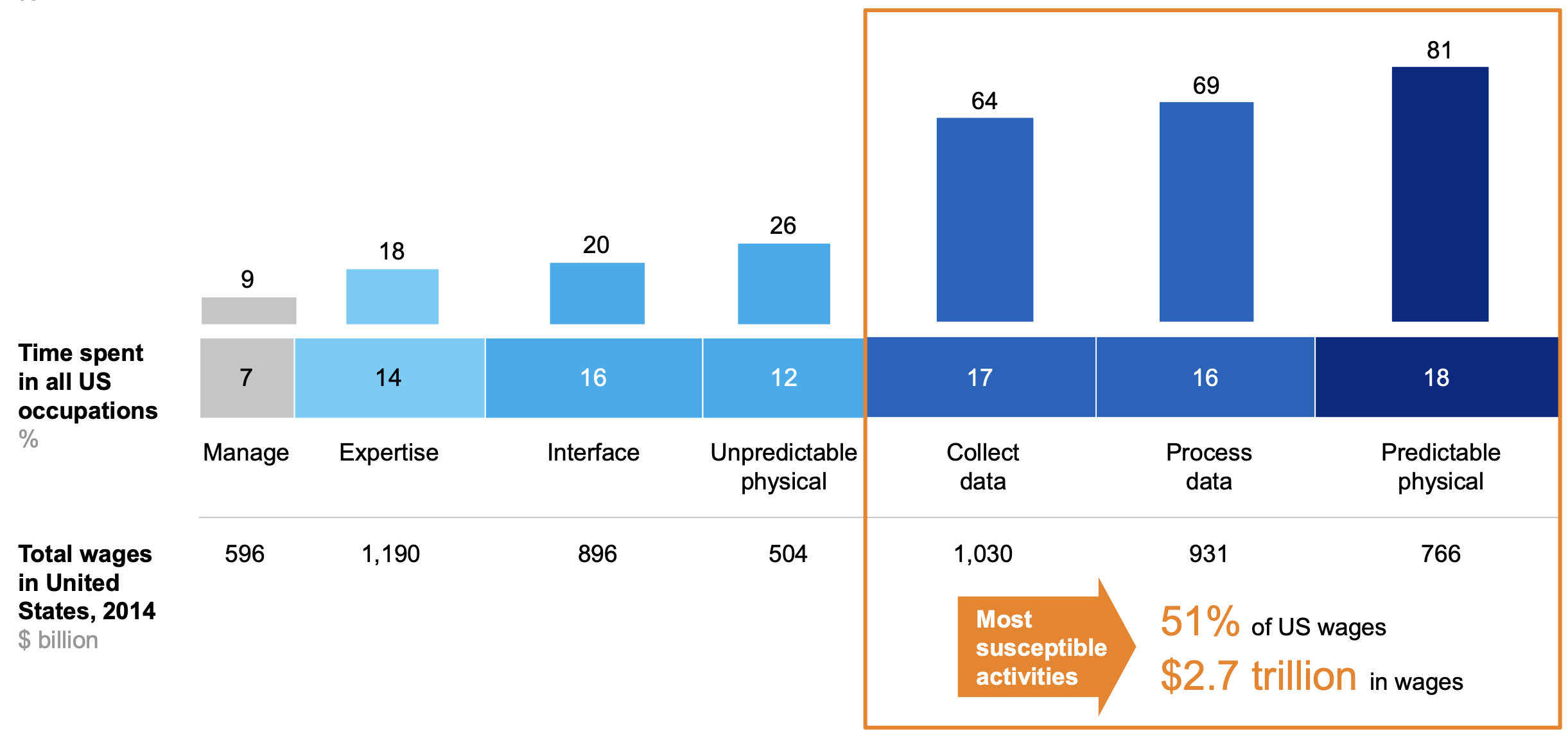
Another insight indicates that the adoption of technical automation is likely to take considerably longer, compared with the availability of potential solutions. As shown below, although the current capabilities of technical automation can automate 50% of activities, adoption rates show that this could take another 20–30 years to achieve.
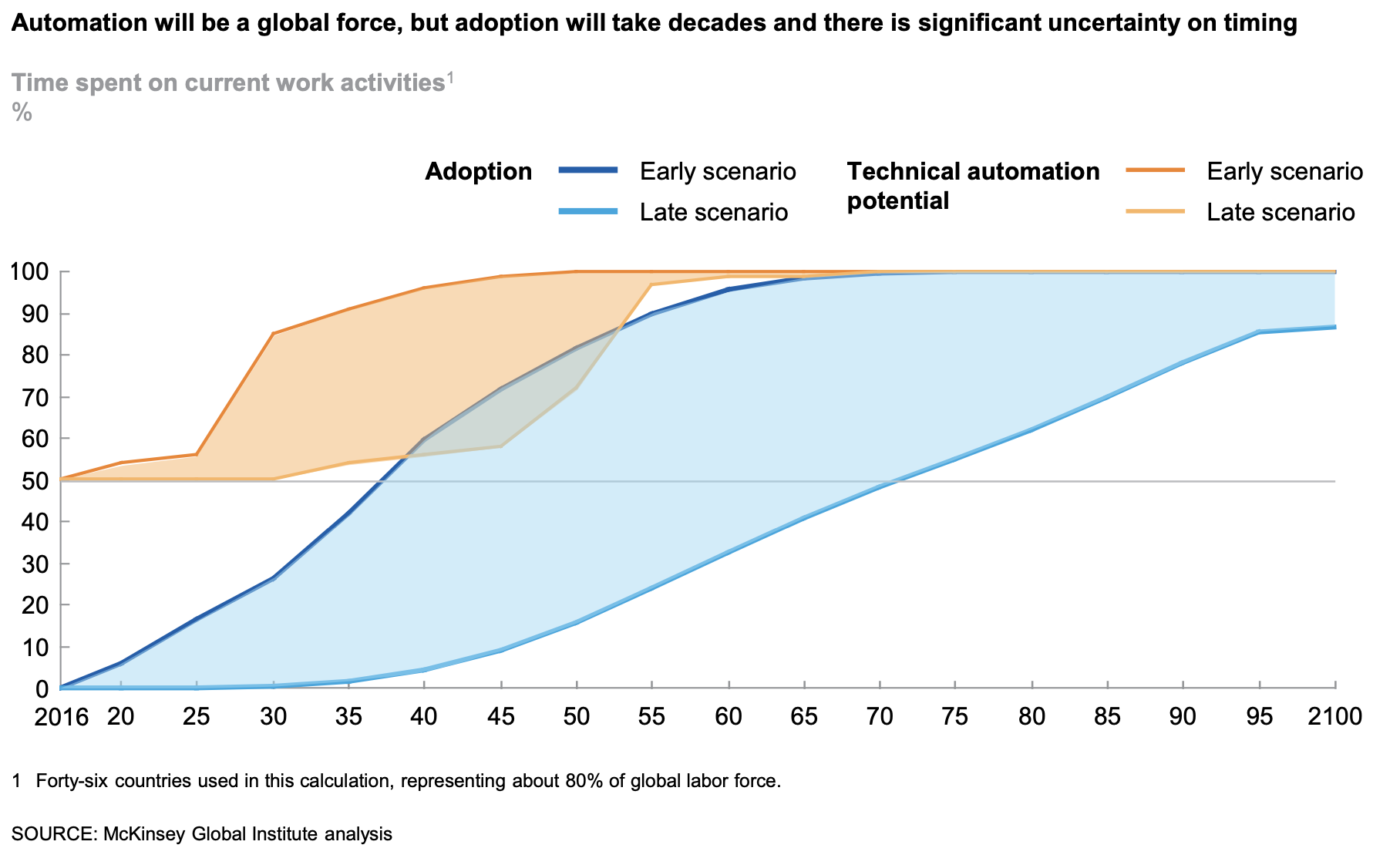
Challenges and Lessons Learned from IA 1.0
Initial attempts at implementing intelligent automation have primarily centered on robotic process automation, highlighting the challenges that arise despite the significant opportunities. In the past, many organizations have failed to implement IA effectively due to a lack of clear goals, inadequate training, and resistance from employees. For example, a large manufacturing company invested heavily in intelligent automation technology without properly training their employees, leading to confusion and frustration among staff members and ultimately resulting in lower productivity gains than anticipated. According to an EY report, 30–50% of initial RPA projects have failed, with lack of strategic alignment and organizational readiness as well as budget overruns being the primary causes.
Implementing intelligent automation requires a strategic approach, significant investment, and a shift in organizational culture. This includes setting clear goals for the technology, providing comprehensive training for employees, and addressing any resistance to change through effective communication and support. By taking these steps, organizations can increase the likelihood of successful IA implementation and maximize the benefits that automation can bring to their business operations.
Vision and Objectives
Startup mindset
When an organization embarks on a transformational path that requires them to embrace innovation and involves a high level of uncertainty and change, adopting a mindset similar to that of a startup enables the organization to chart a more dynamic and adaptable course. In the context of the deployment of IA, this serves to set the stage for the utilization of lean and agile methodologies.
A startup mindset means being open to experimentation, taking calculated risks, and continuously learning and adapting based on feedback and results. It involves being nimble, flexible, and willing to pivot quickly in response to changing circumstances. By embodying a startup mindset, organizations can foster a culture of innovation, creativity, and resilience that is essential for successful IA implementation and overall business growth. Startup thinking has the following traits:
• Taking ownership
• Adapting to change and not being afraid to fail
• Thinking outside the box and always asking questions
• Delegation rather than top-down thinking
• Keeping teams small
Vision
The vision for Intelligent Automation (IA) includes establishing clear and adaptable goals and objectives that align with the organization’s overarching strategy. It requires a focus on experimentation and continuous improvement, as well as a willingness to take calculated risks in order to drive innovation and growth. By adopting a startup mindset, organizations can better position themselves to thrive in a rapidly evolving digital landscape and capitalize on the opportunities presented by IA technologies. A strong vision for IA will typically include the following elements:
Business Transformation Goals: The vision should reflect how IA will help transform the organization. Will it enhance operational efficiency? Improve customer satisfaction? Enable innovation in product development? Organizations need to set specific goals that demonstrate how automation will drive business outcomes.
A Culture of Automation: Successful IA implementation is not just about technology—it’s equally about people. A key aspect of the vision should be creating a culture where employees embrace automation as a tool for improving their work rather than fearing it as a replacement. Upskilling employees, fostering a growth mindset, and ensuring transparency around the impact of automation are vital.
Future-proofing the Organization: Intelligent automation should be viewed as a long-term investment in the organization’s future. The vision should include adaptability to evolving technologies and business needs. Organizations must commit to continuous improvement, updating their automation strategies as new opportunities arise.
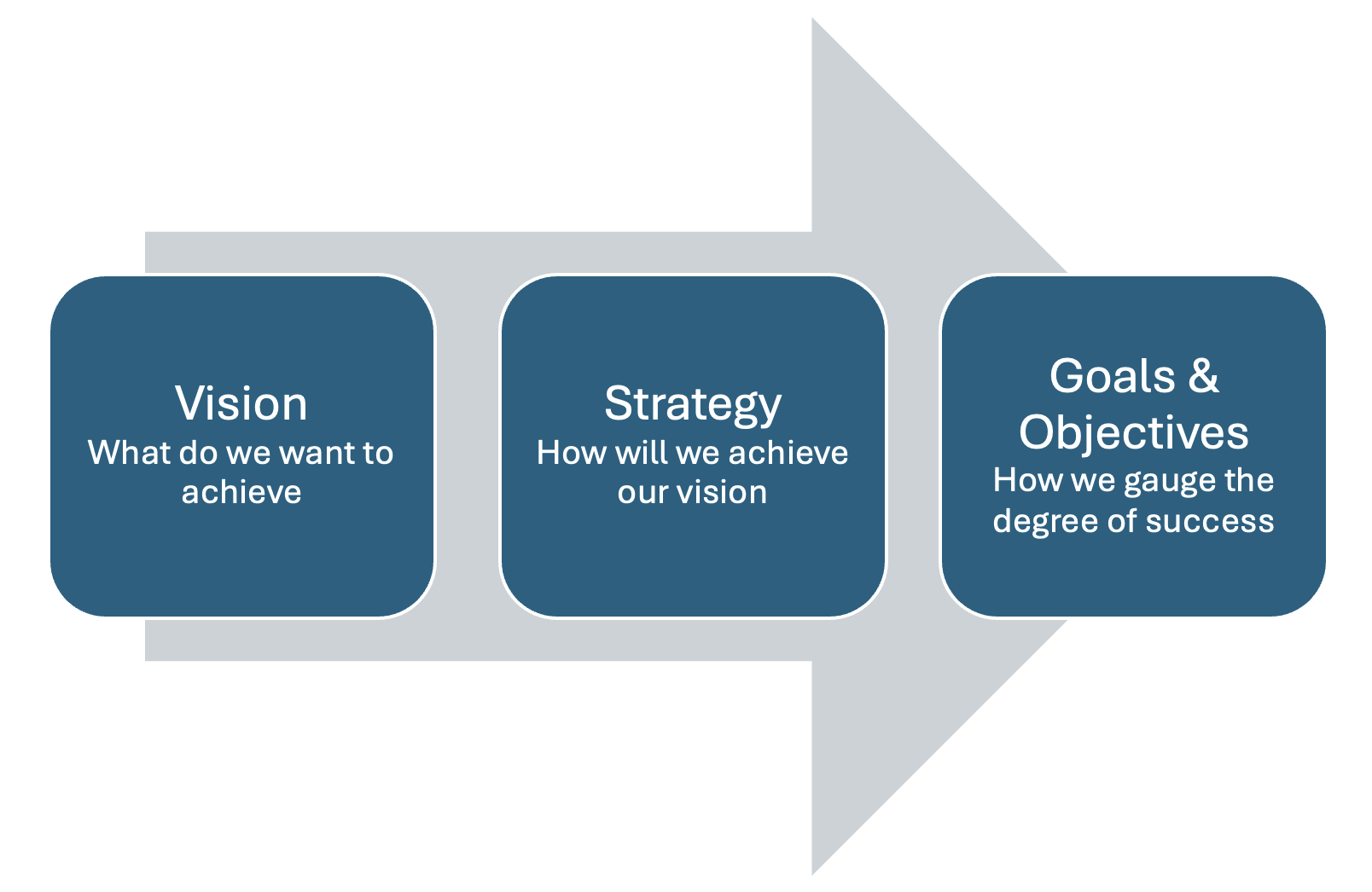
Goals and Objectives
The primary focus of implementing intelligent automation is to drive efficiency, reduce costs, enhance accuracy, and facilitate growth through strategic objectives.
For example, a manufacturing company may invest in intelligent automation to streamline their production process, reduce errors, and ultimately increase productivity. By setting clear goals and objectives such as reducing production time by 20% and increasing output by 15%, the organization can measure the success and impact of automation on their bottom line.
The goals of implementing intelligent automation can be summarized as follows:
Enhancing Operational Efficiency: The primary goal of AI is to increase efficiency by automating time-consuming and repetitive tasks. Automation reduces manual intervention, minimizes human error, and speeds up task completion, enabling employees to dedicate more time to value-added activities.
Reducing operational costs: By automating routine processes, businesses can significantly lower labour costs. IA reduces the need for manual labour in tasks such as data entry, invoice processing, and customer service, ultimately leading to substantial cost savings.
Improving Accuracy and Compliance: Intelligent automation ensures that processes are executed consistently and accurately, reducing the risk of human error. This is especially critical in industries where compliance with regulatory standards is mandatory, such as finance and healthcare. Automated systems ensure that compliance is maintained by following predefined rules and procedures.
Enhancing Customer Experience: Automation can streamline customer interactions by providing faster, more accurate service. Chatbots, AI-driven support systems, and automated workflows enable quicker response times and 24/7 support, leading to higher customer satisfaction and loyalty.
Enabling Scalability: As businesses grow, they need to scale their operations efficiently. IA enables organizations to scale processes without a proportional increase in resources. Automation solutions can handle growing workloads without requiring additional employees, making it easier to meet business demands as they evolve.
Supporting Data-Driven Decision-Making: Intelligent Automation leverages AI and ML to process vast amounts of data, providing insights that can drive smarter decision-making. Whether it’s predicting trends, identifying customer preferences, or optimizing operations, IA helps organizations make more informed, data-driven choices.
The objectives of implementing intelligent automation can be summarized as follows:
Automating High-Volume, Repetitive Tasks: One of the immediate objectives of IA is to automate high-volume, repetitive tasks, such as data processing, invoice management, and order fulfilment. Automating these tasks frees up employees for more strategic work and reduces errors caused by manual intervention.
Streamlining End-to-End Processes: IA goes beyond task automation by enabling end-to-end automation of business processes. The objective is to create a seamless workflow that integrates multiple systems and processes, ensuring smooth operations across departments.
Enhancing Agility and Flexibility: A key objective of IA is to improve an organization’s agility. By automating workflows, businesses can respond faster to changing market conditions, regulatory requirements, and customer demands. This flexibility helps organizations stay competitive in dynamic environments.
Achieving Continuous Improvement: IA is not a one-time implementation; the objective is to continuously improve processes over time. Automation systems can be refined and optimized based on performance data, ensuring that businesses stay ahead of the curve in terms of efficiency and innovation.
Fostering Innovation and Growth: By automating routine tasks, IA creates bandwidth for employees to focus on innovation. This strategic objective is aimed at fostering a culture of creativity and growth, encouraging teams to experiment with new ideas and develop solutions that drive business transformation.
Transformational Strategy
Once the vision is in place, the next step is to translate it into a well-thought-out strategy and a visionary approach that aligns with the broader business goals. Components of an intelligent automation strategy may include identifying key stakeholders, establishing clear objectives, implementing appropriate technology solutions, and continuously monitoring and refining the automation process. A well-defined strategy is essential for mitigating risks and ensuring that automation initiatives align with corporate values and compliance standards, highlighting the critical role of strategic planning in successful implementations.
Components of an Intelligent Automation Strategy
Current State Assessment: Before implementing IA, it’s crucial to understand the organization’s current processes, capabilities, and challenges. A readiness assessment helps identify areas ripe for automation, the level of process standardization, and gaps in technology infrastructure or skills. This assessment forms the foundation for identifying high-impact automation opportunities.
Use Case Prioritization: With a clear understanding of the current landscape, organizations can prioritize use cases for automation. The best use cases are typically those that are highly repetitive, rule-based, and involve large volumes of data. Additionally, organizations should consider processes that directly impact customers, as IA can significantly improve customer service and response times.
CoE and Governance: Intelligent automation requires collaboration between various stakeholders, including IT, operations, and business units. Organizations must establish a cross-functional team with clearly defined roles and responsibilities. Governance structures should also be created to ensure that IA is deployed in a controlled and compliant manner.
Technology selection: Selecting the right automation technologies is critical to the success of the strategy. Whether it’s RPA for automating simple tasks or AI for more complex decision-making, organizations must invest in platforms that align with their business needs and are capable of scaling over time.
Establish Metrics for Success: Establish precise metrics to assess the impact of IA initiatives. These could include cost savings, reductions in process time, error rates, and improvements in customer satisfaction. Monitoring and reporting on these metrics will help organizations track progress and make data-driven adjustments to their strategy.
IA Enablers
IA relies on enabling capabilities and resources that support its implementation and effectiveness. These can include technical support capabilities as well as a supportive policy framework that is essential for IA to thrive. By leveraging these enablers, businesses can effectively implement IA initiatives, driving growth, competitiveness, and success in the constantly evolving market landscape.
Technical enablers of an IA solution include consideration of the following aspects.
Enterprise architecture provides the bridge between business strategy and technical implementation, ensuring that IA initiatives are aligned with overall business goals. A robust IT infrastructure is also crucial in providing the necessary foundation for IA implementation, allowing for seamless integration of automation technologies.
Cloud-based solutions provide the infrastructure needed to handle large amounts of data, AI workloads, and distributed automation systems.
Integration platforms enable connectivity between different systems, databases, and applications (e.g., ERP, CRM), which is essential for end-to-end process automation.
Security and risk management ensure that data and systems are protected from potential threats and vulnerabilities, allowing for safe and secure operations.
Agile and flexible IT infrastructure that can adapt to new technologies is essential. DevOps practices and agile methodologies help in the rapid deployment of IA solutions while ensuring that the infrastructure can scale as needed.
Policy enablers of an IA solution include consideration of the following aspects.
Workforce Upskilling and Change Management ensures that employees are aware of automation initiatives and can leverage IA capabilities. Change management strategies ensure a smooth transformation and address employee concerns.
Stakeholder engagement early on and throughout the implementation process ensures buy-in and support for the IA initiatives, ultimately leading to successful outcomes. Additionally, ongoing communication and feedback loops with stakeholders will help in identifying any potential issues or challenges and addressing them in a timely manner.
Governance and compliance frameworks are essential to manage risks, ensure compliance, and handle data privacy issues in automated processes. Compliance with regulations like GDPR or HIPAA is critical when automating processes involving sensitive data.
Leadership Role in Intelligent Automation
Effective leadership in IA involves championing the vision, allocating resources strategically, addressing cultural change proactively, promoting transparency and communication, and implementing comprehensive training programs. Executives play a pivotal role in championing the IA vision, communicating its significance across the organization, and ensuring the allocation of necessary resources for successful implementation. Without strong leadership buy-in, automation initiatives are likely to falter, either due to a lack of support or resistance from the workforce.
Leaders should also be ready to address the cultural change that comes with automation, emphasizing the importance of managing workforce transitions effectively. Transparency, communication, and training programs can help ease concerns among employees and foster a culture of collaboration between humans and machines.
Usually, a focused proof of concept initiates task-level automation in the adoption of IA technologies. Although these automations are essential, organizations must swiftly transition to high-value end-to-end process automation with necessary sponsorships and adequate funding from senior leadership. IA leaders must work with senior leadership to recognize and institute the strategic value of the IA program aligned with business goals. The strategic value must be set at the organization and the individual business area levels. IA leaders must identify opportunities to augment business processes by integrating AI-enabled capabilities to unlock long-term strategic business value.

Exercise: The Future Vision Time Machine
• What does their organization or project look like?
• What problems have been solved?
• What innovations have been achieved?
• How are customers or stakeholders benefiting?
• What were the critical decisions or changes that led to this success?
• What challenges did they overcome?
• What resources or partnerships did they need?
• What key milestones marked their journey to success?

Course Manual 2: Readiness Assessment
A readiness assessment is the critical first step in an organization’s intelligent automation journey. It assesses the organization’s readiness for intelligent automation solutions by evaluating its current processes, technology infrastructure, and culture. While the potential benefits of IA are significant, the complexity of its deployment requires careful planning and evaluation. A readiness assessment ensures that the organization:
• Identifies gaps in existing processes that may hinder successful automation.
• Evaluates the technology infrastructure to determine whether it can support IA tools and platforms.
• Assesses organizational culture to gauge how employees will respond to the introduction of automation and whether they have the necessary skills.
• Mitigates risks associated with failed or poorly executed automation initiatives. Conducting a readiness assessment allows organizations to make informed decisions, develop a tailored roadmap for implementation, and avoid costly missteps. It also helps to set realistic expectations about the timeline and scope of automation projects.
As-is vs. To-be Process Modeling
Process modelling is an essential step in implementing intelligent automation, helping organizations understand current workflows and design future automated solutions. The two key stages of this process are as-is and to-be modeling. These stages serve as a guide for transforming existing manual processes into more efficient, automated workflows by providing a blueprint for improvement. The as-is model highlights current inefficiencies, while the to-be model lays the groundwork for streamlined, automated workflows. Together, these models guide organizations through the transformation, ensuring that automation efforts are both effective and aligned with business goals.
As-is: Current State
As-is process modeling captures how processes are being performed today, highlighting the steps, stakeholders, tools, and systems involved. The goal is to provide a detailed understanding of the existing workflows, identify inefficiencies, and recognize pain points that automation can address.
Key characteristics of the as-is current state should consider the following points.
Current Workflow Representation: The exact sequence of tasks and activities currently used to complete a process.
Identification of Pain Points: Bottlenecks, manual handoffs, redundancies, and areas prone to error.
Data-Driven Insights: Analysis based on real-world data, often through process mining or interviews with stakeholders, to create an accurate picture.
As-is modelling is important because it provides a baseline for improvement – a clear starting point from which organizations can plan their automation initiatives. It also informs decision-making and helps the business prioritize process automations for maximum impact.
To-be: Target State
To-be process modelling envisions the future state of processes after the implementation of intelligent automation. It outlines the post-automation functioning of the process, specifying the tasks to be automated, the streamlined workflows, and the expected outcomes.
Key characteristics of the to-be target state should consider the following points.
Optimized Workflow: Improved, automated version of the process, with reduced manual intervention and streamlined steps.
Incorporation of Automation Tools: Integration of intelligent automation tools like RPA, AI, or ML to handle repetitive, rule-based tasks.
Future-State Vision: A blueprint for how the process will operate, defining new roles for employees and adjustments to workflows.
To-be modelling is important because it provides a clear picture of the benefits IA will bring, such as reduced errors, improved efficiency, or cost savings. It also helps teams focus on implementing the right automation tools and strategies based on the desired future state.
Key differences between as-is and to-be process modelling are summarized below.
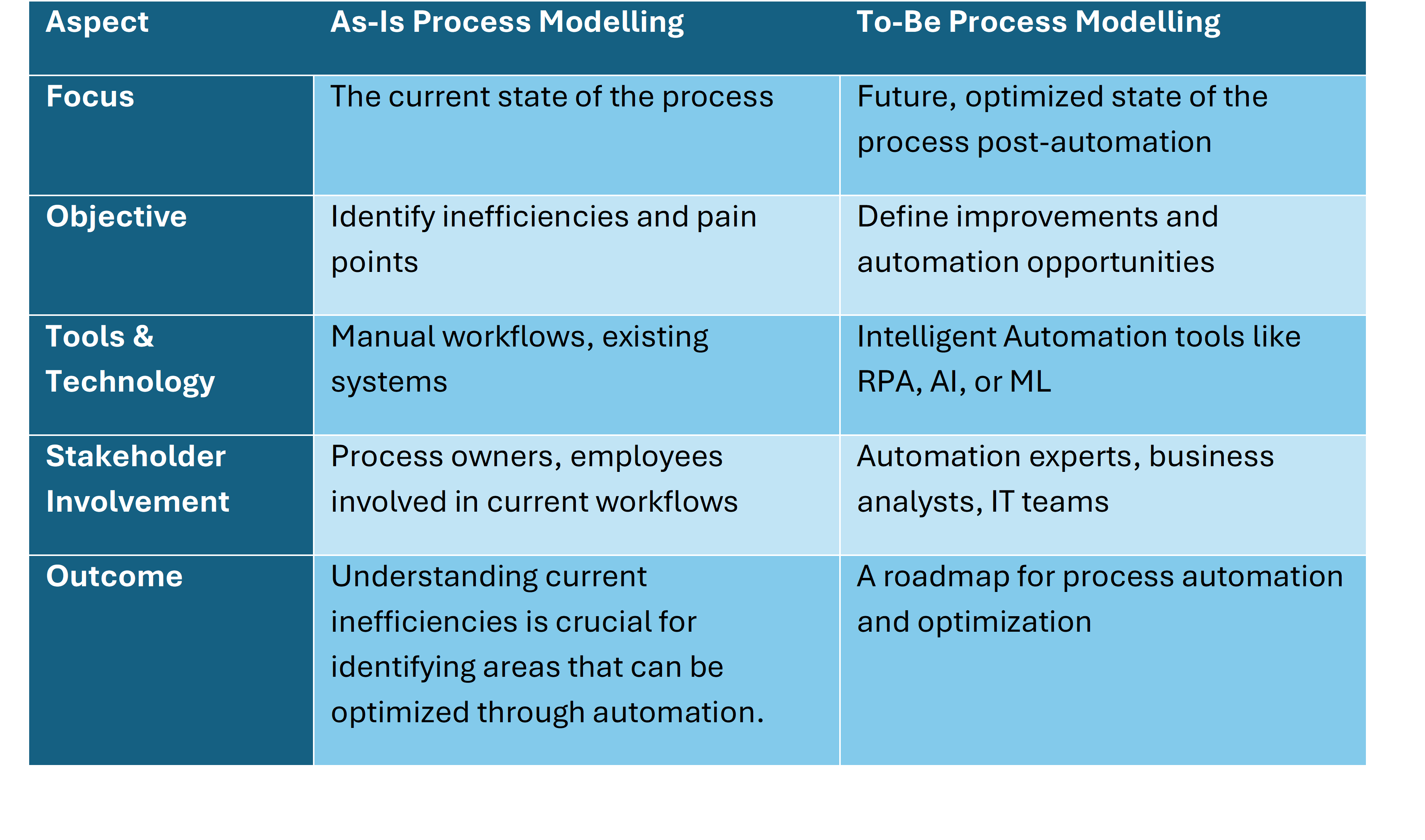
As-is vs To-be process modelling as a foundational technique for understanding and improving business processes provides the following benefits.
Clear Path to Improvement: The as-is model helps uncover inefficiencies, while the to-be model provides a structured vision for process optimization.
Enhanced Alignment: Contrasting the current and future states enables businesses to align their goals effectively, ensuring that IA initiatives are focused on areas with the highest potential impact.
Data-Driven Change: Both models utilize real data and continuous feedback to guide informed decision-making and effective implementation of automation.
IA as a business capability
Intelligent automation is not merely about technology transformation. It is likely to impact all parts of business, and therefore it is important to understand the business context of IA. Organizations can utilize a tool like the Business Model Canvas to map out the IA business capability, facilitating a structured approach to understanding the business context of IA.
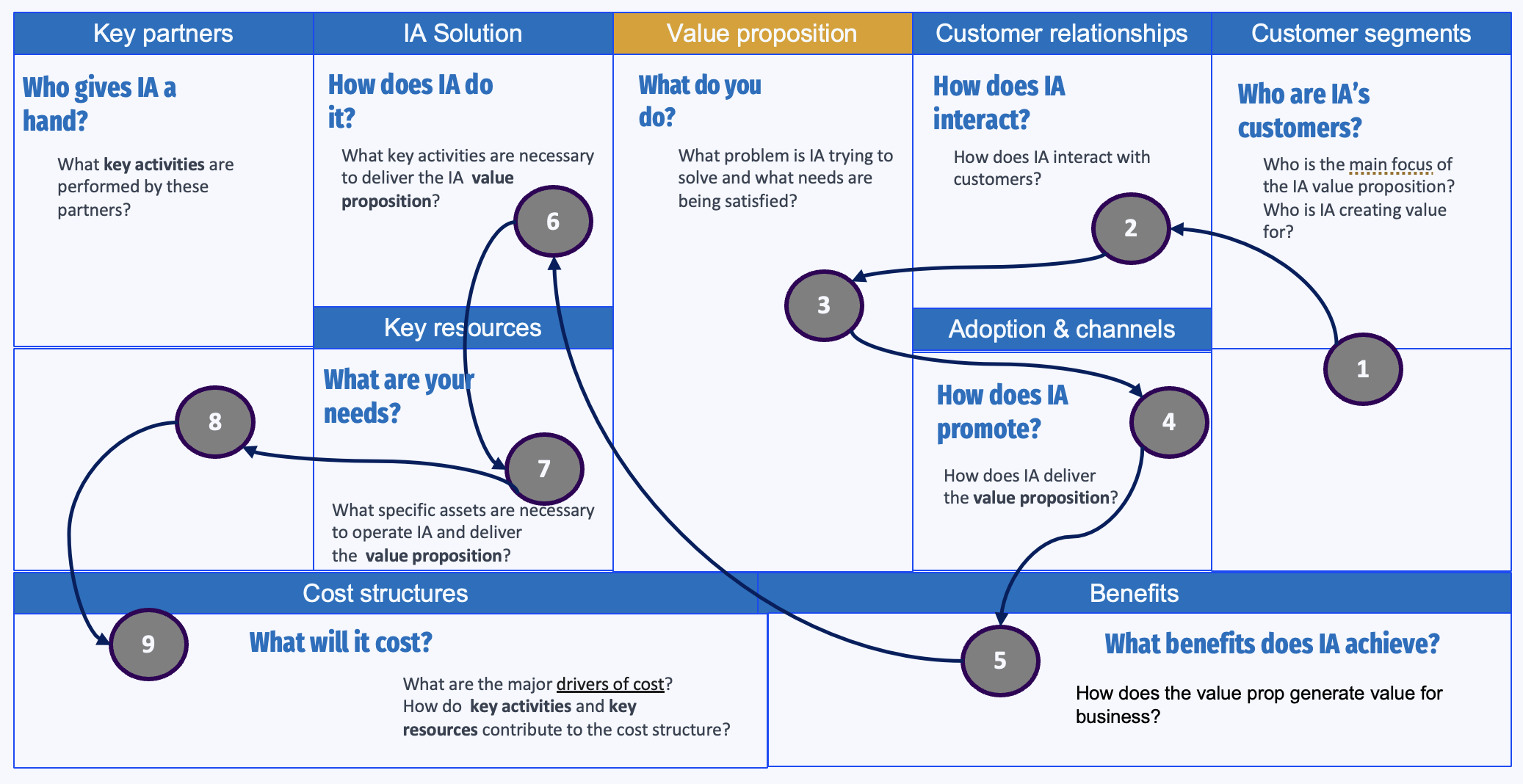
The Business Model Canvas is a visual representation of 9 building blocks of a business function.
Customer segments: identify who the main focus of the IA value proposition is and who the value is being created for. It encompasses all customers of the IA solution. It includes external customers and partners, internal customers, product/process owners, service owners, and the CIO/CTO organization.
Customer relationships: focuson how the IA solution will interact and engage with its various customer segments. This includes identifying the type of relationship the IA solution will have with each segment, whether it be personal, automated, or a combination of both.
Adoption & channels: includes the type of relationship that the business capability will have with each customer segment. This may involve personal interactions, automated processes, or a combination of both. Adoption and channels play a crucial role in ensuring that customers can easily access and benefit from the IA solution. Examples of channels include training and guided tours on digital twin or test bed, chatbots, web forms, and dashboards.
Value proposition: lies in reducing operational costs by automating repetitive processes and mundane tasks to allow employees to focus on higher-value activities.
IA solution: describes the key activities necessary to deliver the IA value proposition. It includes analyzing current business processes to identify areas that can be automated, designing and implementing automation solutions tailored to the specific needs of the organization, continuously monitoring and optimizing automated processes to ensure efficiency and effectiveness, and providing ongoing training and support to employees to ensure successful adoption of automation technologies.
Key resources: describe what is necessary to operate IA and deliver the value proposition. It includes advanced software and technology tools, skilled data analysts and IT professionals, access to high-quality data sources, and continuous investment in research and development. Additionally, strong leadership support, clear communication strategies, and a culture of innovation and collaboration are also essential resources to successfully implement IA within an organization.
Key partners: in implementing IA within an organization often include technology vendors, consulting firms, and academic institutions. These partners play a crucial role in providing expertise, resources, and support in developing and deploying IA solutions. They may assist in designing and implementing AI/ML models, managing datasets, optimizing cloud platforms, and training the workforce on new technologies.
Cost structure: covers understanding the costs associated with developing and offering the business capability. By identifying the major drivers of cost and how key activities and resources contribute to the overall expenses, businesses can effectively allocate their budget and resources.
Revenue streams (Realized benefits: includes the outcomes and business value derived from the business capability.
A Business Model Canvas representation of the as-is versus to-be state can visually demonstrate the transformation and benefits of implementing an IA strategy.

Case Study: Tesla Business Model Canvas
[Source: https://bstrategyhub.com/tesla-business-model-tesla-business-model-canvas/]
A Business Model Canvas for Tesla is shown below:
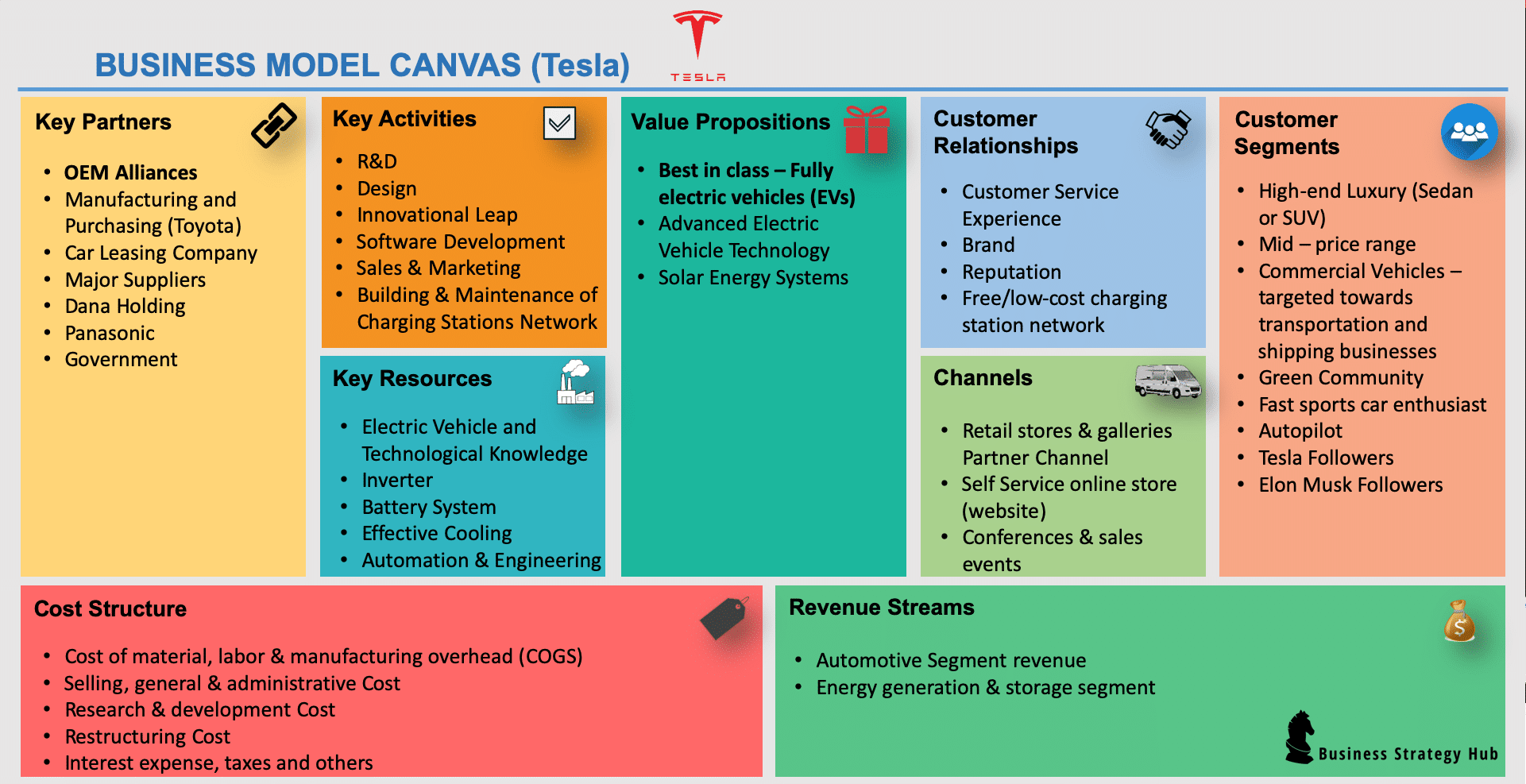
It shows the key aspects of the Tesla business model. Tesla’s value proposition is to offer high-quality, sustainable products, including electric cars and renewable energy products, enhancing people’s lives and the environment through advanced features and long-range driving experiences. Its customer segments include environmentally conscious consumers, early adopters, and affordable Model 3 and Model Y vehicles, catering to environmentally conscious, early adopters, and premium technology enthusiasts. The channels include website, showrooms, and an online sales platform to establish a robust customer relationship and manage the entire customer experience.
Tesla’s key activities involve designing, manufacturing, building charging stations, and expanding its business to create a sustainable energy ecosystem encompassing electric cars, renewable energy, and energy storage. The key resources include its brand, technology, manufacturing facilities, and talent. The brand is associated with innovation, sustainability, and quality. Tesla’s technology enables high-performance electric cars and energy products. The manufacturing facilities ensure efficient production and talent. Its key partnerships include suppliers, battery manufacturers, and other energy industry companies, as well as collaborating with government agencies and stakeholders to promote sustainable energy policies.
Tesla’s revenue stream is primarily generated from electric car sales, but it also offers energy products and services through a direct-to-consumer sales model. Its cost structure is higher due to high investment in research and development, as well as manufacturing and marketing costs. Its key activities involve designing, manufacturing, building charging stations, and expanding its business to create a sustainable energy ecosystem encompassing electric cars, renewable energy, and energy storage.
Maturity Assessment
Most organizations will have previously implemented automation capabilities, and some may have even partially implemented intelligent automation. Maturity assessment assists organizations in evaluating their current level of automation capabilities and pinpointing areas for enhancement. By following the maturity model, businesses can gradually enhance their automation processes to achieve higher levels of efficiency and effectiveness.
The five levels of IA maturity are characterized as follows:
1. Initial or ad hoc: There is no IA plan, and there may be minimal automation capabilities, most of which are located in silos and are mostly restricted to task activities. Standardization and governance are both lacking in this situation. Automating processes and implementing some sophisticated features would be possible, but it would be done in a piecemeal fashion.
2. Developing/Opportunistic: The organization might not have an IA strategy, but it might have already implemented IA solutions in pilot form. Automation has shifted from being based on tasks and rules to being geared to processes. A number of processes have been automated, yet they are still separated into silos. There is a certain level of awareness regarding the possibilities of IA, and pilot initiatives have been carried out.
3. Defined/Standardized: In place is an automation plan that acknowledges the capabilities of IA. The processes are documented and standardized, and there is a greater emphasis placed on the optimization of the processes. Pilot projects have demonstrated that IA has the potential to be useful, and the organization is now beginning to make use of the capabilities that IA offers.
4. Managed/Advanced: IA strategy that is well defined and has the support of the entire organization. There are a wide variety of IA technologies that are being utilized, and there is enterprise-wide adoption of IA. There is a culture of continual improvement, as well as strong governance and change management for the organization.
5. Optimized/Transformative: IA is completely integrated into the organizational DNA and makes use of its cognitive and predictive powers. Process intelligence is being utilized to search for ongoing improvement through the use of monitoring and process mining. a culture focused on innovation that opens up new channels for company transformation and value streams.
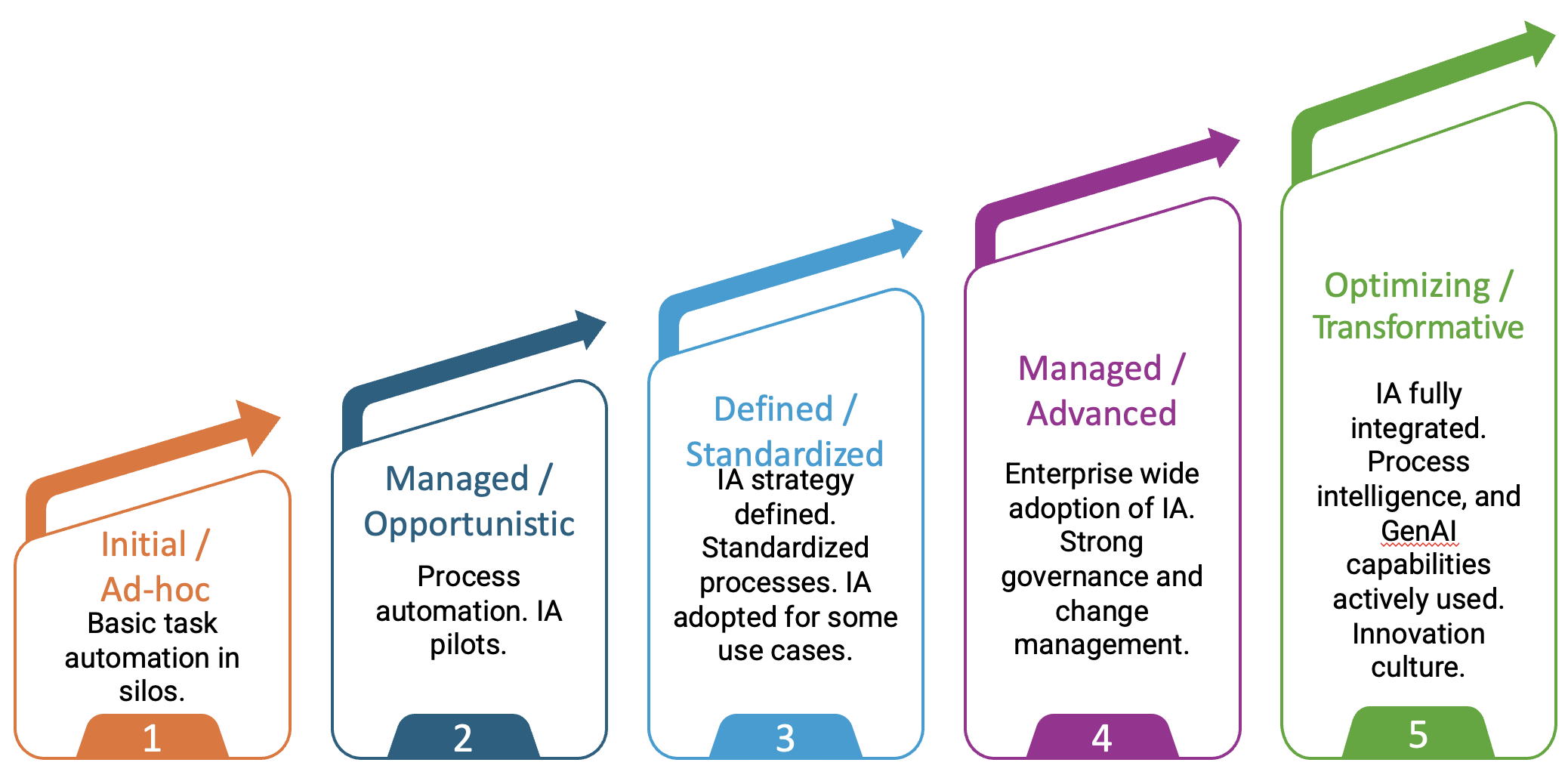
Maturity Scorecard
An organization’s maturity might differ in different domains. Use a maturity scorecard for a more detailed review. It facilitates the assessment of how well-established the different IA facets are throughout the company. Comparing the organization’s current IA maturity to its desired level using a scorecard facilitates a comprehensive evaluation of progress, identifying areas for improvement and guiding strategic decisions. This comparison makes it possible to make focused adjustments in any areas where the organization could be deficient. The primary goal is to achieve a high degree of maturity in every facet of intelligent automation to enhance efficiency, creativity, and company expansion. A business might utilize the maturity scorecard, for instance, to assess how well its automated processes are working now and where they want to be in the future. They can use this research to determine which areas, in order to effectively meet their automation targets, require investments in technology upgrades, process enhancements, or training.
The components of the IA maturity scorecard are as follows.
Strategy: it is the extent to which the organization’s vision and strategy are aligned to take advantage of emerging trends and add value. Regarding employees, assess how well they are trained and engaged in the automation process. In terms of processes, the efficiency and effectiveness of the organization’s current processes and how well they align with automation goals. In terms of technology, the level of technology adoption and integration that supports the organization’s automation initiatives. Finally, in terms of governance, the structure and oversight in place to ensure successful automation implementation and maintenance.
Design: includes the extent to which the organization’s processes and systems are designed to support automation and digital transformation. It also includes the organization’s ability to effectively implement automation solutions and integrate them into existing processes.
Development: organizations can streamline their processes, reduce errors, and enhance productivity. By investing in ongoing development and training for employees, organizations can ensure that they are maximizing the potential benefits of automation. This will lead to increased efficiency, reduced costs, and ultimately, a more satisfied customer base.
Workforce: upskilling and reskilling will be necessary to ensure that employees can adapt to new technologies and automation processes. This investment in employee development will not only benefit the organization by increasing productivity and efficiency but will also boost employee morale and job satisfaction.

Case Study: Blue Prism RPA Maturity Assessment
[Source: https://www.blueprism.com/automation-journey/rpa-maturity-model/]
SS&C Blue Prism is a leading provider of RPA products and services. It has defined a “Robotic Operating Model (ROM2)” that guides organizations through five steps of digital transformation: strategy, workforce, design, development, and operations. It defines the 5 maturity levels as follows:
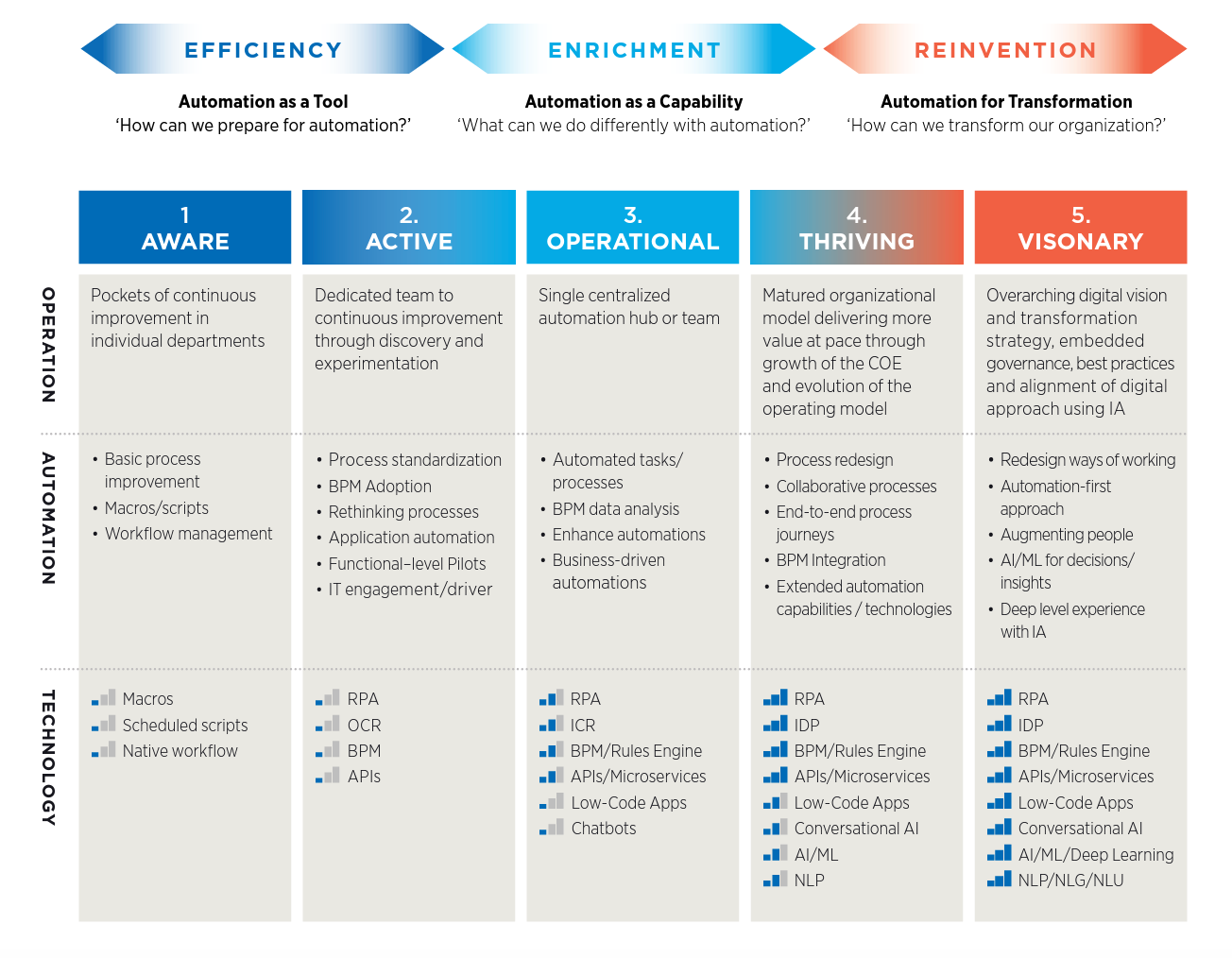
Assessment Process
Key Components of Readiness Assessment
A comprehensive readiness assessment involves evaluating several critical areas across the organization.
Process assessment: The first step in a readiness assessment is to evaluate the organization’s processes to identify those that are suitable for automation. Not all processes are ideal candidates for IA—organizations should focus on processes that are:
• Repetitive and follow a set of predefined rules.
• High-volume tasks that consume significant time and resources.
• Error-prone, where automation can increase accuracy.
• Dependent on structured data that can be easily processed by IA tools. For example, finance and accounting departments often have high-potential processes for automation, such as invoice processing, data entry, and report generation.
Technology infrastructure assessment: The success of an intelligent automation initiative largely depends on the existing technology infrastructure. Organizations must assess whether their current IT systems can support the deployment of IA technologies. Key considerations include:
• Integration capabilities: Can the IA tools integrate seamlessly with existing enterprise systems like ERPs, CRMs, or legacy platforms?
• Scalability: Is the infrastructure robust enough to handle an increasing number of automation processes over time?
• Security and compliance: Can the organization maintain data security, privacy, and regulatory compliance during and after IA implementation?
• Cloud readiness: Many IA tools leverage cloud platforms for scalability and flexibility. Organizations must evaluate whether they have the right cloud infrastructure or are prepared to migrate to one. Organizations with outdated or fragmented IT systems may face challenges when integrating IA tools, so this assessment is essential to identifying necessary upgrades or investments.
Data readiness assessment: Data is the fuel that powers intelligent automation systems, particularly when it comes to the use of AI and Machine Learning. A readiness assessment should evaluate the organization’s data landscape to ensure that it is prepared for automation.
• Data quality: Are the data sets accurate, complete, and consistent? Poor data quality can undermine automation efforts, leading to inaccurate outputs or process failures.
• Data availability: Does the organization have access to the necessary data in real-time or at sufficient intervals to support automation?
• Data structure: Does the data require significant cleaning or transformation, or is it in a structured format that automation tools can process easily?
Workforce skills assessment: While automation can significantly reduce manual tasks, it doesn’t eliminate the need for skilled employees. Instead, it shifts the focus toward higher-value work that requires human judgment, creativity, and problem-solving. A readiness assessment must evaluate:
• Employee skill levels: Do employees possess the necessary digital and analytical skills to work alongside automation tools?
• Training requirements: What upskilling or reskilling programs are necessary to assist employees in adjusting to new roles created by automation?
• Change management: How well is the workforce prepared for the cultural shift that comes with automation? Will there be resistance, and if so, how can it be addressed? Engaging employees early in the IA journey and providing training programs are critical steps in ensuring a smooth transition to automation.
Organizational culture assessment: Successful intelligent automation adoption is not just about technology; it’s also about people and processes. A readiness assessment must evaluate whether the organization’s culture is conducive to embracing automation. Factors to consider include:
• Leadership support: Is there strong executive buy-in for IA initiatives? Without leadership support, automation projects are unlikely to receive the resources and attention they need to succeed.
• Openness to innovation: Are employees and managers willing to embrace new technologies and ways of working, or is there a preference for maintaining the status quo?
• Collaboration between departments: Intelligent automation often requires collaboration across multiple departments, such as IT, operations, and business units. A culture that promotes cross-functional collaboration will facilitate smoother IA implementation. In organizations with a risk-averse or change-resistant culture, it’s important to implement change management strategies that foster acceptance and encourage innovation.
Steps to Conduct a Readiness Assessment
Now that we’ve covered the key components of a readiness assessment, let’s explore how organizations can conduct this evaluation. While the specifics may vary depending on the organization’s size and industry, the following steps provide a general framework.
Stakeholder Engagement: Involve key stakeholders from IT, operations, finance, HR, and business units in the assessment process. Collaboration ensures that all relevant perspectives are considered and helps build consensus around the IA strategy.
Process Mapping: Analyze the organization’s core processes to identify those that are ripe for automation. This step involves documenting workflows, identifying bottlenecks, and quantifying the potential benefits of automating each process.
Technology and Data Audit: Conduct a comprehensive audit of the organization’s IT infrastructure, data management practices, and integration capabilities. This will highlight any gaps that need to be addressed before IA implementation.
Employee Surveys and Interviews: Gather insights from employees through surveys and interviews to assess their readiness for IA. This will help identify areas where training or change management initiatives are needed.
Gap Analysis and Recommendations: Based on the findings, conduct a gap analysis that identifies areas where the organization is not fully prepared for automation. Develop actionable recommendations to address these gaps, whether through technology upgrades, process improvements, or workforce development.
Develop an Action Plan: Once the readiness assessment is complete, use the insights gained to develop a detailed action plan. This should include timelines, budgets, and responsibilities for addressing gaps and preparing the organization for IA implementation.

Exercise: The Intelligent Automation Fitness Test

Course Manual 3: Cross-functional CoE
A well-established Center of Excellence (CoE) for Intelligent Automation is key to scaling automation efforts across an organization. A CoE is a centralized team or function that sets the strategic direction for IA initiatives, develops best practices, provides governance, ensures compliance with industry regulations, and fosters a culture of continuous improvement. Establishing a CoE involves more than technology; it entails fostering an innovative culture that empowers employees to embrace the future of work. The CoE’s role includes spearheading the adoption of automation organization-wide and assisting other teams in utilizing automation effectively.
CoE in the Organization
The adoption of intelligent automation often starts with a few isolated projects or pilot programs. However, as the demand for automation grows, organizations must move beyond ad hoc implementations and create a scalable framework to manage and expand automation efforts across departments. A center of excellence serves to develop expertise and best practice to help guide the organization in its implementation of intelligent automation.
Standardize IA practices: A CoE ensures that all automation projects follow a consistent methodology, reducing the risk of fragmented or siloed implementations.
Drive scalability: As automation spreads across different areas, a CoE helps to scale initiatives effectively while maintaining quality and governance.
Optimize resource allocation: By centralizing expertise, organizations can avoid duplication of efforts and ensure resources are used efficiently.
Foster collaboration: A CoE encourages collaboration across departments, aligning automation efforts with the organization’s strategic goals.
Ensure continuous improvement: The CoE acts as a hub for monitoring, refining, and enhancing automation initiatives, fostering a culture of innovation and ongoing improvement.
The CoE typically fits within the IT department or as a standalone entity reporting directly to senior leadership, ensuring alignment with technology strategies and overall organizational goals. This positioning allows the CoE to have authority and influence across departments while also being able to focus specifically on automation initiatives. By having a clear organizational structure, the CoE can effectively drive automation efforts and ensure alignment with the overall strategic goals of the organization.
The alignment of the center of excellence within an organization can vary, depending on the strategic goals of the CoE. There are generally three common models of organizational alignment.
Chief Digital Transformation Officer: coordinates strategic digital transformation, aligns intelligent automation with overall strategy, prioritizes automation opportunities, and establishes governance and accountability for value realization through intelligent automation.
Chief Financial Officer: manages investment decisions, planning, and governance within the Finance organization, enabling company-wide automation strategy. Adoption of RPA typically begins in the finance organization, but potential downsides include a narrow focus on cost savings and job loss, limiting potential value creation, and affecting employee success.
Chief Information Officer: The IT department is a natural fit for the intelligent automation CoE, as it can enable business innovation and align with the overall technology platform strategy. The IT department manages the technology portfolio, investment, planning, and implementation, ensuring alignment with the overall architecture and security framework. The integration of intelligent automation capabilities into the IT department’s infrastructure strategy and operations framework also benefits.
The governance structure of the CoE can be centralized, federated, or a combination of both (hybrid).
In a centralized model, complete control and ownership of automation reside with a central team, ensuring consistency and streamlined decision-making processes. In this model, the CoE supports all the business units with their automation requirements. The CoE is responsible for identifying automation opportunities and then developing and deploying them. The CoE is also responsible for all the tools and technology decisions, including automation platforms and cloud services. They will also maintain the pool of skilled resources that can deliver the automation for the business.
In the federated or decentralized model, each business unit has its own, smaller CoE to support its specific automation requirements. Each CoE team is responsible for developing automation solutions and operating them. Each CoE is also responsible for tools and platforms used in automation solutions. This model may grow organically initially but can be difficult to scale across the organization. There is also the potential for duplication and waste as certain functions of the CoE are duplicated.
The hybrid model combines the two strategies with a core central CoE providing overarching governance and delegated CoE teams aligned to each business unit, providing the agility and autonomy to progress at their own pace. This model is also known as a hub and spoke model. The hub sets the common standards and policy, while the spokes are more focused on delivery.

Case Study: Accenture’s internal operations automation journey
[Source: https://www.accenture.com/gb-en/case-studies/about/internal-operations-automation-journey]
Accenture wanted to improve its internal operations efficiency through intelligent automation. They started by establishing an automation center of excellence. The CoE comprised automation architects, machine learning developers, RPA experts, and data scientists who collaborated to develop automation solutions for 900 Accenture applications, showcasing a diverse skill set essential for comprehensive automation projects.
Using research and proof of concept, the Automation COE seeks to innovate and produce assets that are useful to all business units. Core operational areas like service requests, issue management, monitoring, data patrolling, changes, testing, and deployments are all included in the scope.
The Automation Center of Excellence (COE) offers the necessary framework, oversight, and discipline related to automation to meet the objectives of increased operational and financial performance.
As a result of this initiative, Accenture has achieved a 35% reduction in operational costs and automated 40% of applications. It has also created additional resource capacity of 10% annually and increased quality and reliability.
Supporting the CoE
Whether the CoE operates in a centralized or federated manner, it is important to understand the role of additional stakeholder groups that actively contribute to ensuring successful outcomes for IA. It is critical to ensure representation from supporting and enabling teams to drive the adoption of automation capabilities and incorporate specific security, audit, workforce, architecture, and technology requirements. These stakeholder groups play a crucial role in providing expertise and guidance to the CoE, helping to align automation initiatives with overall business objectives. By including representatives from various departments such as IT security, audit, and architecture, the CoE can ensure that all necessary considerations are taken into account. This collaborative approach will ultimately lead to a more robust and successful implementation of intelligent automation within the organization.
These supporting teams may operate in their own centers of excellence, dedicated to their domain of expertise. Common stakeholder support teams that can assist with IA implementation include the following.
Information technology: they ensure the alignment of automation capabilities to the overall technology strategy.
Enterprise architecture: they incorporate the automation platform into enterprise architecture and define standards and guardrails.
Cybersecurity: they ensure that the design of automation platform infrastructure, architecture, and automation solutions adhere to security requirements.
Internal audit: they ensure that the right types of controls (business, process, segregation of duties, etc.) are implemented into the automation framework.
Human resources: they ensure alignment to human resources policies, regulatory requirements, and the overall workforce strategy.
Out of the above supporting teams, two groups should be formed:
IA operating committee representing cross-functional senior leadership across the company. This committee must include representation from various business functions within the company, such as finance, legal, human resources, sales, marketing, operations, supply chain, and customer support, ensuring comprehensive oversight and alignment with organizational objectives. The opportunities for automation come from either functional or cross-functional processes within these functions.
IA champions drive execution-level planning, decision-making, and alignment. This automation champions group must include representation from each line of business/function, including internal audit, enterprise architecture, data governance, cyber security, program management office, etc.
CoE Roles and Responsibilities
A well-functioning CoE requires a combination of technical expertise, business acumen, and governance. The CoE organization and the key roles and responsibilities are outlined below.
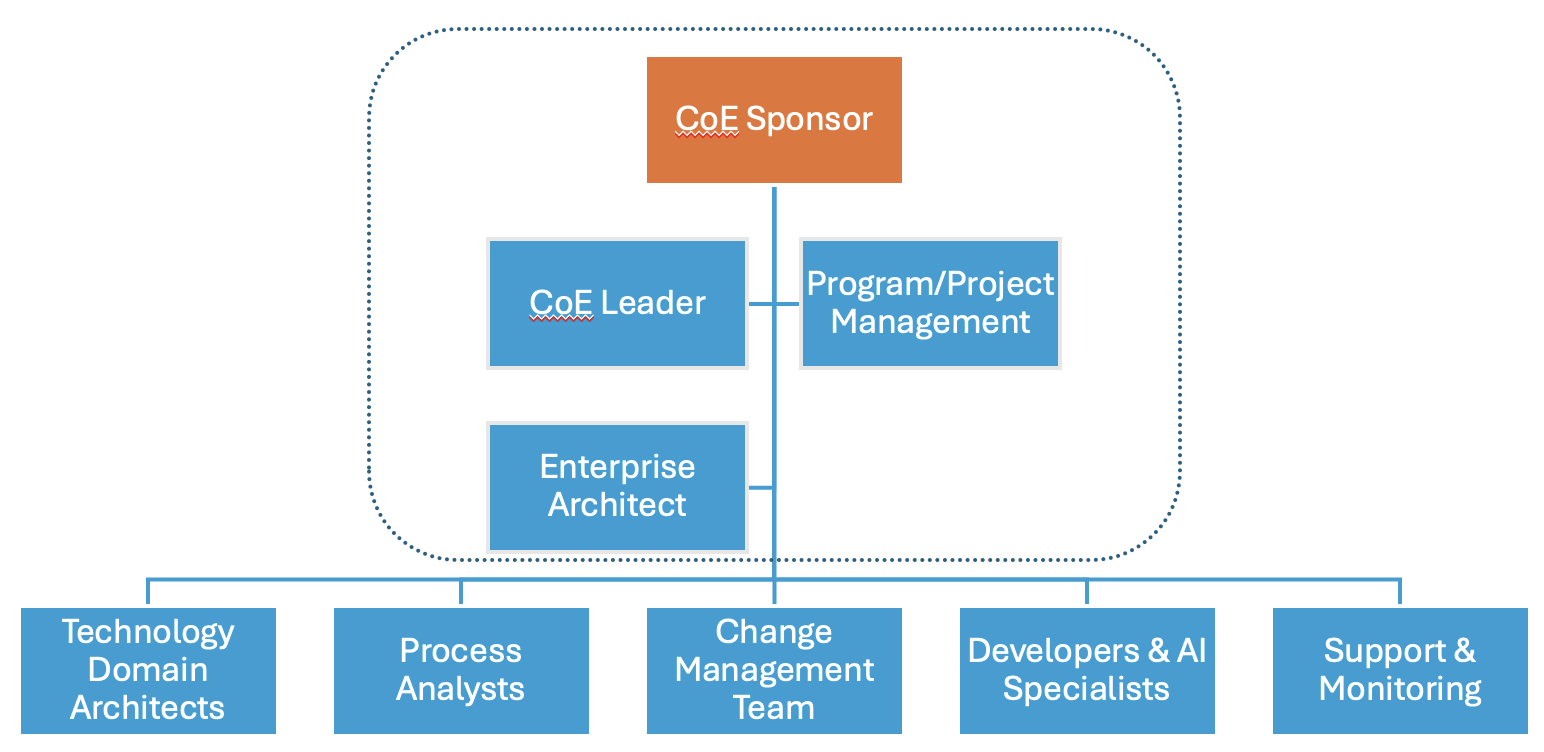
CoE Leadership and Governance Team: The leadership team at the Center of Excellence (CoE) sets the strategic direction and oversees governance, involving senior executives from various business functions. They establish policies for implementing intelligent automation initiatives and ensure alignment with organizational goals. The team secures resources, manages risks, and monitors progress towards achieving IA objectives. Their commitment to governance and oversight enhances the resilience and sustainability of IA initiatives. They continuously evaluate and update governance frameworks, ensuring they remain effective and up-to-date with industry best practices. Their proactive approach to managing compliance, security, and risk helps safeguard the organization against potential threats. By aligning with business goals, the CoE can demonstrate the value of their efforts in improving overall performance and achieving strategic objectives. The CoE sponsor’s role is to advocate for and promote the IA program. The CoE leader acts as the single point of contact and the go-to person. The enterprise architect provides the business oversight, and the program management oversees the delivery of IA solutions.
Technology Domain Architects: IA architects and solution designers are responsible for defining the technical aspects of automation projects and designing solutions that align with business requirements and IT infrastructure. They collaborate with stakeholders to gather requirements and ensure the successful implementation of automation technologies. They work closely with developers and engineers to ensure scalable, efficient, and reliable automation solutions. They stay current on emerging technologies and industry trends to continually improve and innovate automation projects.
Process Analysts: Process analysts are essential in identifying automation opportunities and assessing the feasibility of automating specific business processes. They collaborate with stakeholders to document existing processes and identify tasks best suited for automation. By analyzing these processes, they can pinpoint areas where automation can significantly improve efficiency and reduce errors. This collaboration between IA architects, business units, and process analysts ensures the right processes are automated to drive sustainable growth and success in the digital era. By leveraging process analysts’ expertise, businesses can streamline operations, increase productivity, and achieve transformation goals. By assessing the costs and benefits of automation, businesses can determine which areas yield the highest return on investment. Continuously evaluating and refining automation strategies helps companies stay agile and responsive in an ever-changing business environment, leading to sustained growth and profitability.
Developers and AI Specialists: IA developers and AI specialists are technical experts who create, test, and deploy automation solutions. The developers automate rule-based tasks while AI specialists work on complex tasks involving machine learning, natural language processing, or computer vision. Combining the skills of both can lead to a higher level of automation that can handle a wider range of tasks and processes. This collaboration between developers and AI specialists allows companies to streamline their operations, improve efficiency, and reduce the risk of errors. By leveraging the expertise of both roles, organizations can achieve a more sophisticated level of automation that can adapt to changing business needs and technologies.
Change Management and Training Team: Effective change management and training are crucial for ensuring a smooth and successful adoption of automation solutions, facilitating employee readiness and maximizing the benefits of automation initiatives. The change management team prepares employees for the transition and provides necessary training. The training team educates employees on how to operate and maximize the benefits of automated systems. Regular training sessions ensure that employees stay informed about system changes and updates. Allocating resources to change management and training enables organizations to embrace automation, adapt to new workflows, and enhance efficiency and success. Training programs should cater to employees of all levels, making them engaging and interactive. Prioritizing ongoing education and development in intelligent automation technologies fosters a culture of continuous learning and innovation, enhancing individual performance and driving organizational growth and competitiveness.
Support and Monitoring Team: Automation solutions require regular monitoring and maintenance to ensure optimal performance. The support team handles ongoing maintenance, monitoring of key performance indicators (KPIs), and addressing issues. This proactive approach helps organizations stay ahead of the curve in the rapidly evolving digital landscape. Regular audits are essential to proactively identify potential vulnerabilities or non-compliance issues within IA solutions, safeguarding data integrity and ensuring adherence to regulatory standards. This proactive approach protects sensitive data and information, maintaining the overall integrity and effectiveness of the solutions. Regular audits also play a vital role in maintaining the security and regulatory compliance of automation technologies. Continuous support and updates for automation solutions help organizations proactively address security threats and maintain up-to-date systems with the latest security measures.
Building a Successful CoE
CoE vision and objectives
The first step in establishing a CoE is to define its vision and objectives. The CoE’s vision should align with the organization’s broader business goals, such as improving operational efficiency, reducing costs, or enhancing customer experiences. Key questions to consider include:
What are the organization’s primary goals for adopting intelligent automation, and how will the CoE contribute to achieving these goals?
By clearly defining the vision and objectives of the CoE, stakeholders will have a clear understanding of its purpose and direction, increasing the likelihood of its success. Additionally, having a well-defined vision will help guide decision-making and resource allocation throughout the establishment and operation of the CoE.
How will the CoE support these goals, and what metrics will be used to measure success?
The CoE significantly drives the adoption of intelligent automation across the organization by offering expertise, guidance, and support to diverse teams. It focuses on streamlining processes, improving efficiency, and enhancing overall performance through automation. The effectiveness of the CoE is measured by key performance indicators like process efficiency, error reduction, cost savings, and customer feedback.
What specific outcomes does the CoE aim to achieve (e.g., number of automated processes, cost savings, or efficiency improvements)?
The aim of CoE is to achieve a significant increase in the number of automated processes within the organization, resulting in improved productivity and efficiency. Additionally, the goal is to achieve substantial cost savings by streamlining operations and minimizing errors through automation.
Secure Executive Sponsorship
Executive sponsorship is critical to the success of a CoE. Senior leaders must champion automation efforts, allocate resources, and ensure alignment with business priorities. Gaining executive sponsorship also helps overcome potential resistance and drives organization-wide buy-in for automation initiatives. Without executive sponsorship, it can be challenging to secure the necessary resources and support for the CoE to function effectively. Senior leaders can help remove barriers and provide the necessary guidance to ensure that automation efforts are aligned with the organization’s strategic goals. With robust executive support, the CoE can effectively lead the adoption of automation across the organization and optimize the benefits of automation solutions.
Build a Cross-Functional Team
A successful CoE requires collaboration between multiple business functions, including IT, operations, finance, and HR. Build a cross-functional team that includes experts in business processes, technology, governance, and change management. This diverse team will bring a range of perspectives, ensuring that automation efforts are both technically sound and aligned with business objectives. By bringing together individuals with a variety of skills and backgrounds, the CoE can effectively address any challenges that may arise during the automation process. This collaboration will also foster innovation and creativity, leading to more effective solutions. Establishing a robust cross-functional team is crucial for driving successful automation initiatives and reaching organizational goals.
Don’t Forget About Security and Compliance
To maintain consistency and control over IA initiatives, it’s essential to develop a governance framework that outlines best practices, standards, and guidelines for automation projects. This framework should address the following issues.
Security: Ensure that IA solutions comply with data privacy and cybersecurity requirements. This will help protect sensitive information and prevent potential breaches.
Compliance: Maintain regulatory compliance by establishing checks and audits for automated processes. This will help ensure that all automation projects are in line with industry regulations and internal policies, reducing the risk of any potential breaches.
Risk Management: Identify and mitigate potential risks, such as system failures, security breaches, or process disruptions. This can be done by implementing robust risk management strategies that involve regular risk assessments and contingency planning.

Exercise: The CoE Blueprint Challenge
• Vision and objectives
• Core capabilities
• Roles and responsibilities
• Sponsorship
• Governance
• Budget cuts: “Your CoE’s budget has just been reduced by 20%. How do you adjust your plan to still meet your objectives?”
• Talent shortage: “You’re unable to hire all the specialized staff you need. How do you reallocate roles or leverage external resources?”
• Resistance to change: “A key department is resisting the new processes your CoE is promoting. How do you get them on board?”
• Technology shift: “Your organization has adopted a new enterprise platform. How does this impact the technology stack in your CoE?”

Course Manual 4: Use Case Discovery
Selecting the right use cases is a crucial initial step in the intelligent automation process. With effective process analysis, automation impact analysis, and business objective matching, Organizations can prioritize high-impact operations that generate quantifiable outcomes. For example, a retail company may use case discovery to identify the most time-consuming manual processes in their order fulfilment operations. By automating these processes, they can significantly reduce processing times and improve overall efficiency, leading to increased customer satisfaction and cost savings.
Carefully selecting the right use cases is necessary to maximize the return on investment (ROI) of intelligent automation initiatives. By concentrating on the appropriate use cases, organizations can guarantee that their automation initiatives yield lasting benefits and pave the way for future innovations.
Reviewing Business Objectives
Before delving into particular processes, it is crucial to ensure that automation efforts are in line with the organization’s overall business objectives. This ensures that IA initiatives contribute to the company’s strategic priorities and deliver measurable value. Key objectives to consider are as follows.
Cost reduction: If the primary goal is to cut costs, focus on processes that are labour-intensive, repetitive, and high-volume. Automation can also help improve the speed and accuracy of processes, leading to greater productivity and better customer service. Scalability can be improved, allowing for greater flexibility and adaptability in a rapidly changing market.
Efficiency improvement: For organizations looking to streamline operations, identify bottlenecks and slow manual processes that can be automated. One must look for opportunities to reduce the time and resources required to complete tasks. This not only saves money but also allows employees to focus on more strategic and value-added activities. In addition, automation helps to eliminate human errors and inconsistencies, resulting in higher-quality output and increased customer satisfaction.
Customer experience: If enhancing customer service is a priority, look for use cases where automation can accelerate response times, personalize interactions, or improve service accuracy. Businesses can create a more efficient and satisfying experience for their customers by accelerating response times and personalizing interactions. This not only increases customer satisfaction but also helps to build brand loyalty and drive revenue growth.
Compliance and risk management: In heavily regulated industries, automation can help ensure compliance by automating tasks related to reporting, auditing, and monitoring. For example, in the financial services industry, automation can streamline the process of conducting audits and generating reports to ensure regulatory requirements are met consistently. By automating these tasks, businesses can reduce the risk of non-compliance and avoid costly fines or penalties.
Once the organization’s business objectives are well-defined, they can concentrate on identifying use cases that align with these goals. This involves evaluating which processes can be automated to streamline operations and enhance productivity. By identifying use cases that align with the organization’s objectives, businesses can effectively leverage automation technologies to achieve their desired outcomes. Additionally, continuous monitoring and evaluation of these automated processes are crucial to ensuring they remain effective and compliant with regulations.

Case Study: Tech Mahindra decreases manual work for clients by 95%
[Source: https://www.automationanywhere.com/sites/default/files/internal-assets/casestudy-tech-mahindra_en.pdf]
A client of Tech Mahindra was struggling with monthly reports and statements that needed to be downloaded from more than 100 different website carriers and emails. Before automation, a team of 7 employees was tasked with the downloading of regular reports. With each download, employees faced numerous layers of data security, from one-time passwords to security questions, and there were frequent changes in data parameters. The delays caused by the layers of data security also led to delays in the downstream processes of dashboard production and monthly reporting.
Tech Mahindra developed an RPA solution to eliminate the manual process. The average download time was reduced from ten to six minutes, with just one employee needed to monitor the process. The client saved over 21,000 hours annually.
Case Study: US Department of Motor Vehicles improves customer service with RPA, AI, and ML
[Source: https://www.ey.com/en_us/insights/consulting/ey-consulting-case-studies/case-study-intelligent-automation-shifts-a-state-agency-into-higher-gear]
The DMV recently faced spikes in demand that resulted in long waiting times and service backlogs for its 10 million-plus customers.
With the help of Ernst & Young LLP, DMV implemented an intelligent automation solution to provide virtual services such as vehicle renewals, registrations, and payment processing.
The outcome of the project was new digital service channels, offering customers the end-to-end ability to complete forms, upload documents, make secure online payments, and fulfil state requirements online. These new capabilities also cut back on paper use, reduced carbon footprint, saved time for employees, and made the customer experience much better. The agency saved approximately 300,000 employee hours, more than 4 million sheets of paper and $14.4 million in associated costs.
Process discovery
Process discovery entails thoroughly analyzing current processes to identify the most suitable ones for automation. This process mapping should involve input from various departments, such as IT, operations, finance, and customer service, to ensure a comprehensive view.
Key Criteria for Selecting Use Cases
Repetitive and rule-based: processes that involve repetitive, rule-based tasks are ideal for automation. These tasks follow clear procedures that can be codified into algorithms for bots or AI systems to follow. Examples include data entry, invoice processing, and payroll management.
High volume and frequency: processes that occur frequently and involve high volumes of transactions are good candidates for automation, as the ROI from automating these tasks tends to be higher. For example, automating a high-volume customer inquiry process can save significant amounts of time and resources.
Error-prone processes: tasks prone to human error, such as manual data entry or compliance checks, are prime candidates for automation. IA can ensure accuracy and consistency by reducing the risk of mistakes.
Processes dependent on structured data: processes that rely on structured data, are easier to automate using RPA and IA tools. For example, processing structured customer data from a CRM system can be automated with minimal complexity.
Complex decision-making and cognitive tasks: While RPA handles rule-based processes, AI and ML can be used to automate more complex tasks that require decision-making, learning, or interpretation of unstructured data (e.g., email or document processing). Examples include fraud detection, predictive maintenance, and customer sentiment analysis.
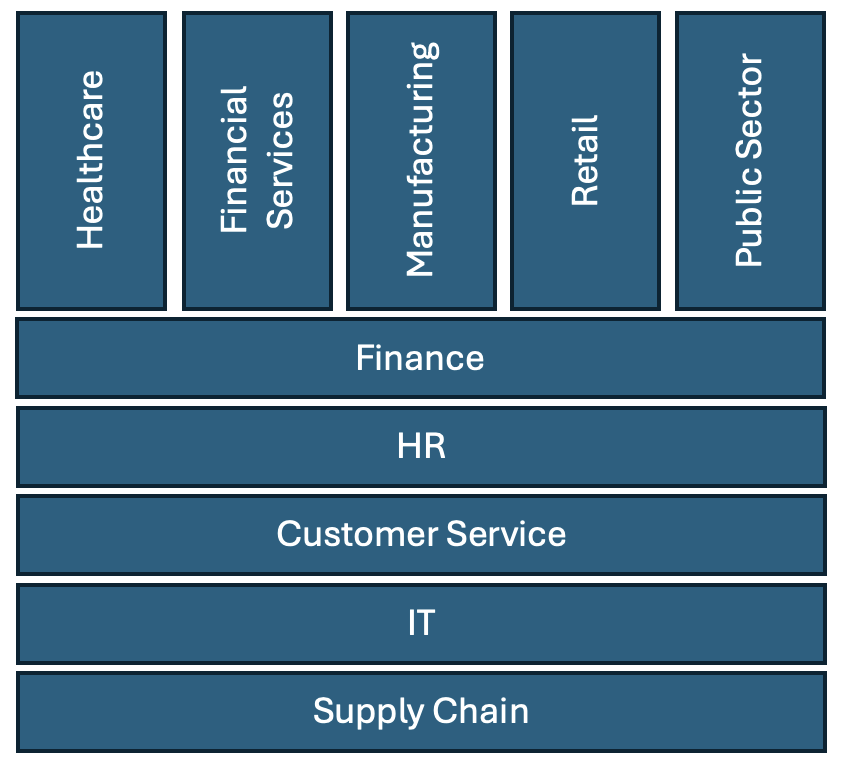
Horizontal Use Cases
These are common front and back-office processes found in most organizations and relate to generic activities that enable organizations to run their business operations. Examples of such process use cases include:
Finance: invoice processing, expense management, account reconciliation, payroll, and financial reporting.
HR: employee onboarding, payroll processing, leave management, and performance management.
Customer Service: automated ticketing systems, chatbots for handling customer queries, and service request management.
IT: system monitoring, user provisioning, incident management, and patch management.
Supply chain: order processing, inventory management, shipment tracking, and supplier communication.

Case Study: Canon leverages AI for document processing
[Source: https://www.uipath.com/resources/automation-case-studies/canon-leverages-ai-for-document-processing]
Canon’s finance department faced a high workload of processing 500 vendor invoices a month. Invoices were complex, often filled with date ranges, machine serial numbers, and charges, often created on paper documents, and processed for small amounts, sometimes under $150. There were 4 FTEs dedicated to processing all of this paperwork.
Canon worked with Greenlight Consulting to replace RegEx-based extraction with customized machine learning (ML) models for invoice processing.
Canon is saving about 6,000 hours annually in employee time through the elimination of manual interventions, and it has eliminated a 4-month backlog of invoices.
Vertical Use Cases
Intelligent automation finds abundant use cases across different industry sectors. Here are some examples:
Healthcare: patient administration, insurance processing, and regulatory compliance. Fraud prevention, treatment planning, and predicting drug outcomes.
Financial Services: know-your-customer, customer services, loan processing. Antimoney laundering and regulatory compliance. Underwriting and claims processing.
Manufacturing: bill of materials, invoice processing, supply chain, and predictive maintenance.
Retail and commerce: inventory management and returns processing.
Public sector: citizen services, reporting, public sentiment analysis, and waiting list management.

Case Study: Select Health Processes Claims Faster
[Source: https://www.blueprism.com/resources/case-studies/select-health-processes-claims-95-faster-with-ss-c-blue-prism-chorus-bpm/]
Select Health is a non-profit health insurance plan that serves over one million members in the US. Each year, 12 million claims are sent to Select Health by medical and dental providers. To guarantee that each claim is paid correctly and on schedule, the data in it must be accurate. However, claims are frequently filed with false information, such as an outdated provider address or an erroneous tax identification number. The provider operations staff would often have 10,000 issues backlogged and waiting to be resolved at any given time. The processing of thousands of false claims resulted in needless delays in the claims payout procedure, lasting almost sixty days.
To speed up the inefficient claims resolution process, Select Health implemented an intelligent automation solution that optimized the workflow. Select Health saw dramatic improvements. Erroneous claims processing was down from 60 days to 3 days. And 95% of claims were processed within 15 days.
Identifying Automation Opportunities
Following the identification of the process use cases, a more thorough investigation is required to identify potential areas for automation implementation and process efficiency improvement. It is possible to pinpoint inefficiencies, bottlenecks, and locations where automation can be most helpful. This in-depth information enables us to choose which processes to automate first and maximize the impact on business operations. The automation can be adjusted to guarantee that it is producing the intended results and continuing to comply with regulations through ongoing monitoring and assessment.
Process Mining
Traditional interview-based process discovery and modeling are costly and time-consuming because of gaps in business knowledge, a lack of objective validation techniques, and poor formalisms. Informal behaviors and ways of working frequently take precedence over standard operating procedures, policies, work instructions, or best practices baked into enterprise applications. Furthermore, non-trivial process workflows do not follow a linear, straightforward path in execution. Due to interdependencies and complex routing, it may be difficult to understand the actual flow of processes. This can lead to increased risks and potential errors when operating business processes. To remedy the situation, many organizations are employing process mining technologies and practices.
Process mining uses data-driven insights and machine learning algorithms to analyze processes, identify inefficiencies, and optimize them for maximum efficiency. This data-driven approach not only improves the accuracy and reliability of process automation but also ensures compliance with regulations and industry standards.
Process mining and monitoring can help identify bottlenecks, inefficiencies, and potential risks in processes. These process analysis insights provide an opportunity for re-engineering and improving the current process. By applying process mining, the data can provide more predictive analytics, highlight process deviation, drive automation, and help provide an end-to-end view of the process. Utilizing process mining and monitoring tools can offer businesses valuable insights into their operations, aiding in the identification of bottlenecks, inefficiencies, and areas for enhancement. Meticulous planning, continuous monitoring, and evaluation are essential for successful integration of automation into business operations to optimize performance and ensure compliance with industry regulations.

Case Study: Deutsche Telekom
[Source: https://www.celonis.com/customer-success-stories/deutsche-telekom-procure-to-pay-process-mining/]
Deutsche Telekom Services Europe (DTSE) has saved over €66M by maximizing the execution capacity of its procure-to-pay process to tackle duplicate payments and cash discount losses. The Shared Services Center combines Finance, Reporting, Procurement, and HR functions to deliver a highly digitized Procure-to-Pay process for the entire Deutsche Telekom group. DTSE’s procure-to-pay
process handles over 2 million order items and processes almost 9 million invoices a year. One of the main challenges faced by DTSE was leveraging the vast amount of data generated daily in the Shared Services Center to eliminate execution gaps and inefficiencies.
DTSE deployed the Celonis process mining system to gain visibility into their process workflows. It consolidated data from over 10 source systems. This enabled them to define new KPIs and develop an early warning system for the KPIs going off-track. The net result was a significant improvement in the performance of the procure-to-pay process.
Prioritization and Planning
Once the processes and potential automation opportunities have been identified, the next step is to prioritize which processes to automate first. It’s often beneficial to start with quick wins—use cases that are easy to implement but deliver high value. These early successes can build momentum, secure executive support, and provide valuable insights for scaling automation efforts.
Some examples of quick wins include:
• Automating repetitive, time-consuming tasks such as data entry or report generation.
• Streamlining high-volume processes like invoice processing or customer inquiries.
• Using chatbots to handle routine customer service requests. Once quick wins are realized, organizations can tackle more complex or strategic use cases that require advanced AI or ML capabilities.
Once the top use cases have been identified and prioritized, organizations need to create a prioritized list for the roadmap. It will help outline the timeline, resources, and key stakeholders for each phase of the automation journey. The key aspects of the roadmap that relate to prioritized use cases include:
Pilot projects: Begin with small-scale pilot projects to test the automation solution and gather feedback.
Scaling: Once pilots are successful, gradually scale the automation across departments or regions.
Continuous improvement: Use data from the initial implementations to optimize and refine processes. IA should be seen as a continuous improvement initiative rather than a one-time project.
Impact of Automation
Besides the identification and prioritization of use cases, it is important to assess the impact of automating each process. This impact can be measured through several factors:
Business Value: Understanding the business value of automating a process is crucial in determining its potential impact. By saving time and costs, automation can lead to increased efficiency and productivity. Additionally, automation can improve the quality and accuracy of the output, ultimately enhancing customer satisfaction and service levels. Evaluating these factors can help prioritize which processes to automate for maximum benefit.
Feasibility: Considering the feasibility of automating a process is essential in determining the most effective approach. If a process is complex and requires integration with multiple systems, it may be more challenging to automate successfully. Additionally, if the data needed for automation is unstructured and requires significant cleaning and organization, it may be more time-consuming to implement. Evaluating these factors can help determine the best course of action for automating processes to maximize efficiency and productivity.
Scalability: Considering scalability is crucial when determining the feasibility of automating a process. If the automation solution can be easily scaled across different departments or regions, it may be more cost-effective and beneficial in the long run. Standardization of the process within the organization can also impact scalability, as a more uniform process may be easier to automate and implement consistently across different areas. By carefully evaluating these factors, organizations can make informed decisions about the automation of processes to achieve optimal results.
Risk and Compliance: By carefully considering risk and compliance factors, organizations can ensure that automation does not inadvertently expose them to regulatory violations or security breaches. Implementing automation tools that are compliant with industry standards and regulations can help mitigate these risks and enhance overall security measures within the organization. Additionally, automation can actually improve compliance by enforcing consistent processes and reducing the likelihood of human error or oversight.
Organizations can prioritize the most impactful and practical processes for automation by assessing the business value, feasibility, scalability, and risk of each use case.
Stakeholder Engagement and Change Management
For successful automation implementation, it is essential to gain support from stakeholders throughout the organization. So it is important to involve key decision-makers from IT, operations, and business units in the use case identification process to ensure alignment with business goals. Additionally, providing regular updates and training sessions for employees who will be affected by the automation can help smooth the transition and increase acceptance.
Change management strategies should be put in place to address any resistance or concerns that may arise during the implementation process. Particular attention should be paid to specific use cases for each stakeholder to understand their concerns and points of view. For example, in a manufacturing company looking to implement automation in their production line, involving IT experts to identify use cases such as predictive maintenance can help reduce downtime and increase efficiency. Regular updates and training sessions for operators and maintenance staff can help them understand the benefits of automation and alleviate any fears about job security.
Additionally, it’s important to implement change management strategies to prepare the workforce for automation. Employees may feel uncertain about how IA will impact their roles, so communication, training, and upskilling programs are essential to ensure a smooth transition. Providing clear explanations of how IA will improve efficiency and streamline specific processes can help alleviate any fears or concerns among employees. Creating a culture of transparency and open communication enables organizations to cultivate trust and garner support from their workforce throughout the IA implementation process. Continuous investment in training and development opportunities is crucial to empower employees to adapt to the evolving automated environment and excel in their roles.

Exercise: Automation Shark Tank
• Feasibility: Is the automation idea realistic and implementable?
• Impact: Does it have a significant positive impact on the business?
• Innovation: Is the idea creative and forward-thinking?
• ROI: Does the automation offer a good return on investment?

Course Manual 5: Target Operating Model
An operating model for intelligent automation provides a structured framework that guides how automation is designed, deployed, and managed across the organization. By aligning automation with business strategy, establishing clear roles and governance, standardizing workflows, and selecting the right technology, organizations can create a strong foundation for IA success.
Why Operating Model Matters
As businesses scale their automation efforts, the need for a formalized operating model becomes increasingly important. Without a clear model, organizations may face inconsistency, inefficiency, and misalignment between automation efforts and broader business goals. A formalized operating model for intelligent automation provides a framework for organizations to effectively manage and optimize their automation initiatives, leading to increased efficiency (e.g., reduced processing time), productivity (e.g., higher output with fewer resources), and competitiveness in the market (e.g., faster response to market changes). Here are key reasons why a Target Operating Model (TOM) is essential for successful IA implementation.
Alignment with business strategy: A target operating model ensures that automation initiatives are aligned with the broader goals of the organization. Whether the aim is to improve efficiency, scale operations, or enhance customer experience, the TOM helps prioritize which processes to automate and in what sequence. Without this alignment, IA projects risk becoming siloed efforts that deliver isolated improvements but fail to contribute to overall business transformation.
Clear definition of roles and responsibilities: As intelligent automation takes over repetitive tasks, the roles of employees will evolve. A TOM outlines how human workers and automated systems will interact, detailing the new responsibilities for employees and ensuring that IA complements human decision-making. This clarity helps avoid confusion and promotes a smooth transition to a more automated operating environment.
Risk management and governance: Implementing IA comes with challenges, such as data security, compliance, and managing bot failures. A TOM addresses these risks by establishing governance frameworks that define how automation initiatives are managed, monitored, and scaled. It provides guidelines on how to handle exceptions and disruptions, ensuring that the business can operate without significant risks.
Scalability and flexibility: A well-designed TOM allows an organization to scale its automation initiatives efficiently. By having a structured roadmap, businesses can progressively implement more advanced forms of automation, from simple task automation using RPA to more complex decision-making tasks using AI and ML. Additionally, a TOM provides flexibility, enabling adjustments as new technologies emerge or as the organization’s needs evolve.
Change management and culture: Intelligent automation not only transforms processes but also impacts organizational culture. The TOM addresses this by including change management strategies such as targeted communication plans, specialized training programs, and employee engagement initiatives that foster a smooth transition to an automated operating environment. By preparing employees for the shifts in their roles and responsibilities, a TOM helps reduce resistance to change and fosters a culture that embraces innovation.
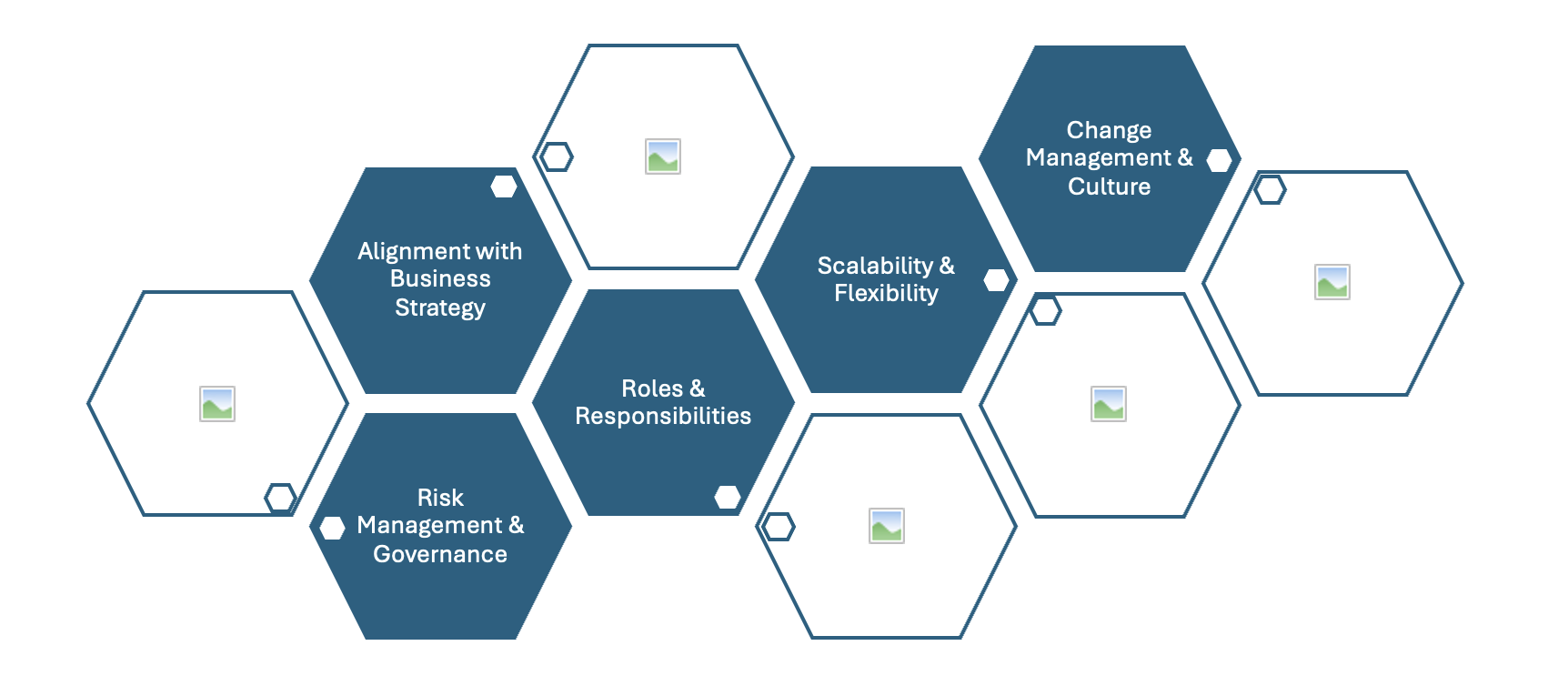
Governance and Control
Governance is a critical element of any operating model, ensuring that automation projects are deployed in a controlled, secure, and compliant manner. A strong governance framework provides oversight by conducting regular audits, establishes accountability through clear reporting structures, and ensures that automation initiatives follow organizational policies, regulatory requirements (e.g., data privacy laws), and ethical standards.
By actively watching over and dealing with possible risks, organizations can reduce the harmful effects of automation projects and uphold a safe and compliant environment. Implementing robust risk management practices can help organizations identify potential threats early on and develop strategies to mitigate them effectively. By incorporating risk management into their operating model, organizations can ensure that their automation initiatives contribute to long-term success and sustainability by proactively identifying and mitigating potential risks, ensuring continuity of operations, and safeguarding against financial losses.
Adhering to compliance and regulatory standards is crucial in ensuring that automated processes are not only efficient but also legally sound. By incorporating these standards into their operating model, organizations can avoid costly fines and legal repercussions. It is essential to regularly review and update automated processes to ensure they remain compliant with any changes in regulations or standards, demonstrating a commitment to upholding legal requirements, minimizing regulatory risks, and maintaining operational integrity. By doing so, organizations can maintain a secure and compliant environment while also reaping the benefits of automation in their operations.
It is important to establish a clear approval process for automation projects. This ensures that all stakeholders are on board and that executives are aware of the potential risks and benefits. It helps to avoid any misunderstandings or conflicts during implementation by ensuring all stakeholders are aligned, clarifying expectations, and facilitating smooth decision-making processes. Additionally, having a defined approval process can help to streamline decision-making by reducing delays in project execution, allocating resources based on priority, and ensuring that projects align with the organization’s strategic goals and compliance requirements.
Finally, automation projects must be thoroughly tested to guarantee that they meet the organization’s quality standards. By implementing quality assurance measures, organizations can minimize the risk of errors or malfunctions in the automated processes. This ensures that the automation solutions deliver the expected results, such as increased operational efficiency and cost savings, and provide value to the organization by improving productivity and customer satisfaction. By prioritizing quality assurance, organizations can increase efficiency and productivity by minimizing errors, enhancing process reliability, and improving overall operational performance.
Roles and responsibilities
The success of an operating model depends on the people involved. Defining clear roles and responsibilities across the organization ensures that automation initiatives are properly managed, executed, and supported. Without clear roles and responsibilities, there can be confusion and inefficiencies within the team. Each member needs to understand their specific duties and how they contribute to the overall success of the automation efforts. By clearly defining roles, organizations can effectively coordinate their resources and ensure that everyone is working towards the same goals.
The roles and responsibilities associated with the automation center of excellence (a specialized team focused on automation best practices) have been covered in a previous course manual. It is worth reviewing these in the context of the operating model.
Automation Champions: Business leaders or executives who sponsor IA initiatives and drive alignment with strategic goals. These champions play a crucial role in fostering a culture of automation within the organization and ensuring that all team members are on board with the automation efforts. They provide guidance and support to the team, helping to break down barriers and overcome challenges that may arise during the implementation process.
Decision Makers: Decision makers are responsible for approving the resources and funding necessary for the successful implementation of IA initiatives. They play a key role in prioritizing automation projects based on their potential impact on the organization’s strategic objectives. By involving decision makers in the IA process, organizations can ensure that automation efforts are aligned with overall business priorities and are able to deliver maximum value. Additionally, decision makers can help to drive adoption of automation technologies across different departments and functions within the organization.
Architects: Experts who design and oversee the technical architecture and solutions for automation. Enterprise and business architects play a crucial role in ensuring that automation projects are implemented in line with business goals and strategy. Technical solution architects oversee the development and implementation of specific automation solutions, ensuring they meet technical requirements and are integrated seamlessly with existing systems. Process architects focus on analyzing and improving existing processes to make them more efficient and effective through automation. They work closely with stakeholders to identify areas that can benefit from automation and develop strategies to streamline workflows.
Analysts: Professionals responsible for identifying suitable automation use cases and mapping out business processes. Business analysts gather requirements from stakeholders, conduct research, and analyze data to determine the best approach for implementing automation. Process analysts work to understand the current state of processes within an organization, identifying bottlenecks and inefficiencies that can be addressed through automation. By creating detailed process maps and conducting thorough analysis, process analysts are able to make informed recommendations for automation solutions that will ultimately improve overall business performance.
Developers and AI specialists: Technical staff who build and deploy automation solutions. These professionals work closely with analysts to understand the requirements and objectives of the automation project. They use their technical expertise to design and implement automation software, robotics, machine learning algorithms, and other technologies that streamline processes and improve efficiency.
Change managers: Specialists who focus on the human side of automation implementation. They work with employees to ensure they understand the benefits of automation and are prepared for any changes that may come with it. Change managers also help to mitigate resistance to new technologies and processes by providing training, support, and communication throughout the implementation process.
Support and maintenance teams: Teams responsible for monitoring and maintaining automated processes post-implementation. These teams are crucial for ensuring that automation continues to run smoothly and effectively. They are tasked with troubleshooting any issues that arise, making necessary updates to the system, and providing support to employees who may encounter difficulties with the new technology.

Case Study: Target Operating Model for Transformation Program at Automotive Manufacturer
[Sourced from: https://www.migso-pcubed.com/case-studies/case-study-target-operating-model-transformation-program/]
A luxury automotive manufacturer established a new department to develop and implement digital service offerings for their consumers to support a broader move toward using data for connected vehicles and autonomous driving objectives. However, the department failed to define roles and responsibilities, resulting in delays and inconsistent service quality that regularly led to cost overruns.
The manufacturer engaged an external consultancy, Migso-Pcubed, to implement a new target operating model that focused on a set of key areas of improvement:
• People-focused capability enhancements and upskilling.
• New and improved governance structures.
• Redefined operating processes.
• Enhanced technology solutions.
• Increased usage of data, data synthesis, and strategy-focused insights.
• Reinvigorated partnering arrangements to foster increased knowledge sharing.
The new target operating model enabled the manufacturer to drive increased benefits from the transformation program, including:
• 10% time reduction during the project mobilization phase due to a standardized and more robust project delivery approach.
• A new data insight strategy identified six new revenue streams, with the potential to unlock additional income between £5 and $20 million.
• Implementation of a data lake that provided a single repository for all of the client data, removing dependency on 3rd party data providers and enabling instant access to 120% more data values
• Development of automated analytical dashboards, enabling the client to develop the most impactful services for their customers
• The introduction of a novel low-code digital capacity management solution enabling improved resource utilization across delivery projects, and
• Significantly increased collaboration between sub-divisions.
Continuous Improvement Process
Intelligent automation is not a one-off implementation. It is a continuous journey that requires regular refinement and optimization. Integrating IA into a continuous improvement process helps organizations maximize the value of their automation efforts, ensuring that systems evolve and improve over time in response to changing business needs, technological advancements, and operational challenges.
Adapting to Evolving Business Needs
Business environments are dynamic, and processes that are automated today may not be relevant tomorrow. A continuous improvement approach allows IA systems to be flexible and responsive. By continuously evaluating the effectiveness of automated processes, businesses can adapt to new demands, regulations, and market conditions, ensuring IA remains aligned with strategic goals.
Performance Optimization
Once intelligent automation is deployed, it’s essential to monitor its performance. Through continuous improvement, organizations can track key performance indicators (KPIs) like speed, accuracy, and cost savings. These metrics provide valuable insights, allowing businesses to tweak algorithms, adjust workflows, or reassign automation to higher-value tasks. Continuous monitoring helps eliminate bottlenecks and ensures optimal system performance.
Incorporating Feedback Loops
The success of IA depends on effective feedback from employees, customers, and the system itself. Continuous improvement establishes regular feedback loops where stakeholders can report issues, suggest improvements, or highlight new automation opportunities. This feedback is crucial for identifying inefficiencies, enhancing the user experience, and improving the overall reliability of IA systems.
everaging New Technologies
Automation technologies, such as machine learning, natural language processing, and AI, are constantly evolving. A continuous improvement mindset encourages organizations to stay up-to-date with the latest innovations. Businesses can progressively integrate new technologies into their IA framework, enhancing the capabilities of existing automation and ensuring long-term scalability.
Managing and Mitigating Risks
Continuous improvement processes help identify and mitigate risks associated with IA. Automation systems, like any technology, can encounter errors or fail to handle exceptions effectively. Continuous improvement ensures that these issues are detected early and addressed proactively. By regularly reviewing and testing automation workflows, organizations can minimize downtime and enhance the reliability of their IA initiatives.
Enhancing Employee and Customer Experience
Automation often transforms the roles of employees and the customer experience. Through continuous improvement, organizations can assess how IA is impacting the workforce and customers. If there are gaps in training, employee resistance, or customer dissatisfaction, adjustments can be made to the processes or change management strategies. Continuous improvement allows organizations to fine-tune their IA solutions, ensuring that automation complements human work and enhances service delivery.

Exercise: TOM Jigsaw Puzzle Challenge
• Aligns with the strategic goals of the fictional organization.
• Integrates intelligent automation in a way that enhances efficiency, quality, and scalability.
• Defines clear roles and processes for people, technology, and governance.

Course Manual 6: Organizational Change Management (OCM)
Organizational Change Management (OCM) is a structured approach to managing the human aspects of organizational change to ensure a successful transformation. It focuses on preparing, equipping, and supporting individuals within an organization to adopt new processes, systems, or ways of working while minimizing resistance and ensuring that the changes achieve their intended outcomes.
Intelligent automation can have a disruptive impact when deployed in an organization. It affects employees directly by changing their daily tasks and responsibilities, leading to resistance and uncertainty. Therefore, a comprehensive organizational change management (OCM) strategy is essential to help employees adapt to the changes brought about by intelligent automation. Incorporating OCM into the intelligent automation roadmap yields several benefits.
One of the most significant challenges with automation is resistance from employees who fear job displacement. This resistance can also stem from employees who struggle to adapt to new processes. Without proper guidance, employees may resist the adoption of IA solutions, leading to delays or reduced efficiency. OCM provides a structured approach to minimize resistance. It starts with clear communication about why the change is necessary, what benefits it will bring, and how employees will be supported throughout the transition. By addressing concerns early on, organizations can ease the emotional and psychological impact of automation.
For IA to succeed, employees must not only accept the technology but actively engage with it. OCM helps build this engagement by involving employees in the change process. This involvement includes gathering feedback, understanding pain points, and aligning automation goals with employee roles. Training and upskilling programs are key components of OCM. Instead of making employees feel like it has replaced them, they empower them to work alongside automation. This proactive approach ensures that employees see IA as a tool that enhances their work, rather than a threat.
Automation projects often fail when the human aspect is neglected. OCM ensures that the technical and human sides of automation are integrated effectively. It involves redesigning workflows, adjusting roles, and setting clear expectations for how employees will interact with IA systems. By managing the organizational impact of automation, OCM helps reduce the risk of disruptions and ensures that IA aligns seamlessly with existing business processes.
Lastly, change management is not just about the initial rollout of IA; it’s about sustaining the change over time. OCM focuses on reinforcing new behaviors and processes, ensuring that employees continue to embrace IA solutions even after the initial implementation phase. Continuous communication, feedback loops, and performance tracking help maintain momentum and identify areas for improvement. This long-term approach to change ensures that IA delivers lasting value to the organization.
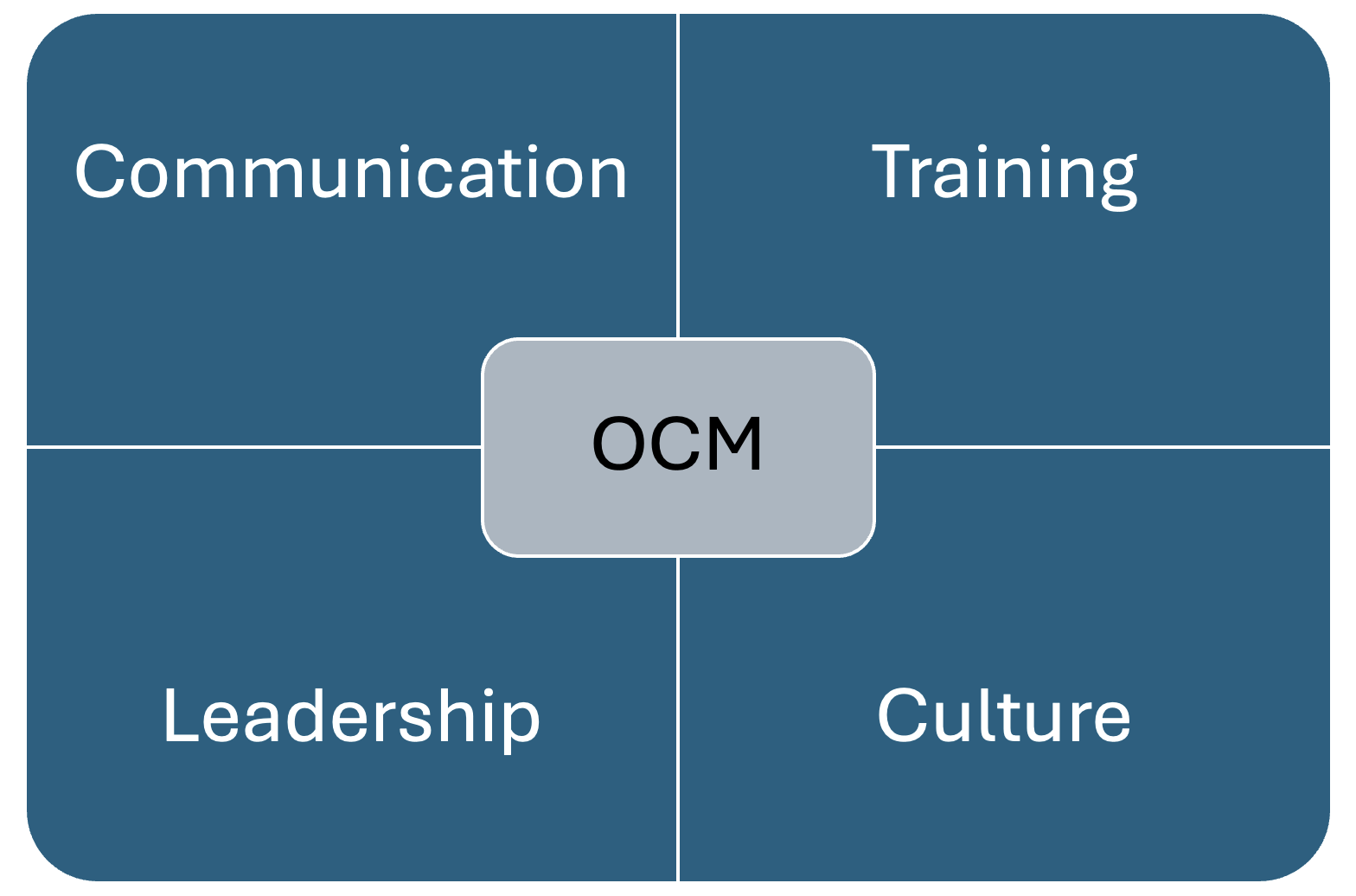

Case Study: Cap Gemini sees OCM as the missing link in Intelligent Automation
[Source: https://www.capgemini.com/wp-content/uploads/2022/01/Organizational-Change-Management-OCM-factsheet.pdf]
Cap Gemini noticed several challenges and barriers in the adoption of intelligent automation amongst its clients. Many of these challenges relate to the people-related aspects of change management.
When researching and investigating the issues further, it found that OCM could help remove these barriers.
In the case of one of their transportation clients, they introduced intelligent automation in their accounts payable process in the form of intelligent document processing (extraction of data from unstructured documents). Almost 90% of the entire work was automated. OCM was used to ensure that people would stop conducting the manual processing themselves and allow automation to handle it instead, trusting the solution and thereby growing the business.
In another case, they deployed an AI-based solution to categorize incoming queries and automate the extraction of key details from multiple systems. Such an advanced solution, utilizing state-of-the-art AI and machine learning approaches, would usually create distrust among process owners and employees. OCM was introduced early on to increase employee participation in developing the necessary training. The process became easier to understand thanks to the use of gamification, which also improved the performance of the AI solution and generated fresh ideas for development and improvement.
In a third case, an organization benefited from combining IA with OCM in its cash collections function. In this solution, a virtual assistant dynamically generates a human-like voice and that automatically makes collection calls in 24 languages, with local accent variants. OCM was extended beyond the organization itself, to accommodate external stakeholders and their own culture of work.
Effective Communication
In order to successfully implement intelligent automation, it is important to have an effective communication strategy. Communication with employees needs to be transparent and frequent. They need to understand not only what changes are coming but why they are necessary, how these changes will benefit both the organization and its workforce, and what the future holds. Leaders can address any concerns or resistance that may arise during the transition to intelligent automation by fostering open and honest communication. This not only helps to build trust and buy-in from employees but also ensures that everyone is on board with the changes being implemented. Moreover, clear communication is essential for establishing realistic expectations and milestones during the implementation process, ensuring everyone stays informed and engaged on the path to increased efficiency and success.
Clarity and transparency
It is crucial to communicate a clear vision for automation and its strategic value to the organization to help employees grasp the broader context and understand how their roles contribute to the overall goals. This can foster motivation and dedication among employees, encouraging them to embrace the changes and actively contribute towards achieving common objectives. Furthermore, open communication about the benefits of intelligent automation can alleviate any fears or uncertainties that employees may have about the transition, creating a more positive and collaborative work environment.
Communicating early and often addresses potential concerns about job security or shifting responsibilities. By proactively addressing these concerns, employees will feel more informed and supported throughout the automation process. This can help build trust and morale within the team, fostering a culture of transparency and teamwork. Maintaining open lines of communication enables organizations to smoothly navigate the transition to automation, minimizing disruptions and maximizing efficiency.
Messages should be tailored for different audiences, from senior leaders to frontline employees. This will ensure that everyone understands the reasons behind the automation and how it will benefit the organization as a whole. It is important to emphasize the opportunities for growth and development that automation can bring, rather than focusing solely on the potential challenges. Additionally, providing training and resources for employees to adapt to the changes will help them feel more confident and empowered in their roles.
Employee Engagement
Engaging employees in the change process from the beginning ensures they feel involved and valued. Instead of being passive recipients of change, employees should have opportunities to provide input, ask questions, and even help shape the automation journey. This level of engagement not only fosters a sense of ownership and accountability but also allows employees to see the benefits of automation firsthand. By actively involving employees in the process, organizations can build trust and create a culture of continuous improvement.
One way to actively engage employees is to involve them in process assessments and automation use case identification. This will not only ensure that the right processes are being automated but also that employees feel valued and heard in the decision-making process. This collaborative approach can also help identify any potential roadblocks or challenges early on, allowing for swift resolution and a more streamlined automation journey.
Setting up feedback channels is important to capture employee concerns and suggestions. This will not only help ensure that the automation processes are aligned with the needs and requirements of the employees but also foster a culture of continuous improvement and innovation within the organization.
Workshops can be conducted to demonstrate the potential of IA and gather input. These initiatives can help employees understand the benefits of automation and how it can streamline their work processes. Additionally, providing opportunities for training and upskilling can empower employees to take full advantage of the new automated systems, further driving efficiency and effectiveness in the organization.
Training and Upskilling
One of the greatest fears around automation is job displacement. While some roles may indeed change or become redundant, IA also creates opportunities for employees to move into higher-value roles. Change management must include a focus on upskilling and reskilling employees to thrive in the future of work. By offering training programs and resources for employees to learn new skills or enhance existing ones, organizations can ensure that their workforce remains competitive and adaptable in the face of automation. Investing in upskilling and reskilling not only benefits individual employees but also the company as a whole, as it allows for a smoother transition into the automated workplace and ultimately drives innovation and growth. Embracing these opportunities for learning and development can help employees feel more secure in their roles and more confident in their ability to contribute to the organization’s success in the long run.
Investing in upskilling and reskilling initiatives helps organizations ensure that their workforce remains adaptable and competitive in the rapidly evolving job market. By proactively addressing skills gaps and providing relevant training, businesses can future-proof their workforce and position themselves for long-term success in the age of automation.
Learning programs should be developed to teach employees how to work with automated systems and understand the fundamentals of IA technologies. By fostering a culture of continuous learning and upskilling, organizations can empower their employees to adapt to new technologies and industry changes.
It is crucial to encourage employees to cultivate critical thinking, problem-solving, and innovation skills that will be essential in an increasingly automated work environment. This will not only benefit individual employees but also drive overall organizational success. For example, a company could implement a training program that teaches employees how to use AI-powered software for data analysis, allowing them to make informed decisions and improve operational efficiency. Encouraging employees to participate in hackathons or innovation challenges can help them develop their problem-solving skills and contribute fresh ideas to the organization’s growth and adaptation to automation.
Role of Leadership
Leadership involvement is crucial for the success of any organizational change. Without active leadership support, automation initiatives can fail. Senior leaders need to actively support IA initiatives and set an example by embracing new ways of working. By demonstrating a commitment to innovation and continuous improvement, leaders can inspire employees to adapt to new technologies and processes. Additionally, having sponsors within the organization who foster a culture of innovation, learning, and development can help drive change at all levels.
Leadership involvement can take many forms. For example, securing executive sponsorship for IA projects helps demonstrate leadership commitment. By doing so, leaders can show their dedication to embracing change and driving transformation. This proactive approach will help employees feel supported and motivated to contribute to the success of automation initiatives.
Leaders can also be encouraged to communicate the benefits of IA and engage with teams to address concerns. This open communication and collaboration will help ensure that everyone is on board with the IA projects and understands the importance of embracing new technologies.
Finally, managers must be trained to be change champions who guide their teams through the automation transition. By empowering managers to champion change and support their teams, organizations can effectively navigate the challenges that come with implementing IA projects. Through ongoing training and support, managers can help their teams adapt to new technologies and processes.
Culture Shift: From Resistance to Innovation
For intelligent automation to succeed in the long term, the organization’s culture must evolve. Innovation and continuous improvement are essential for scaling automation efforts across the business. Embracing this culture shift will not only enhance efficiency and productivity but also boost employee morale and engagement. Employees who feel empowered to work alongside automation technologies will be more motivated to contribute their unique skills and ideas to the organization. Automation can struggle to gain traction in organizations with a risk-averse or change-resistant culture.
Several steps can be taken to allay fears and concerns that generate resistance among employees. Firstly, a change in mindset should be promoted to shift from viewing automation as a threat to seeing it as an opportunity for innovation and growth. This allows for streamlined processes, increased accuracy, and the ability to tackle more complex tasks. As organizations continue to embrace automation and integrate it into their daily operations, it creates a more dynamic and fulfilling work environment for employees.
Secondly, organizations should foster a culture of continuous learning, where employees are encouraged to experiment with new technologies and seek out improvement opportunities. This enables employees to adapt and thrive in an ever-evolving technological landscape. Embracing automation as a tool for growth not only streamlines processes but also opens up new possibilities for creativity and innovation within the workplace.
Finally, organizations should create a culture that recognizes and rewards behaviors that support automation adoption and innovation. By acknowledging and incentivizing employees who actively seek out ways to incorporate automation into their daily tasks, organizations can create a culture that values efficiency and forward-thinking. This can inspire others to follow suit and contribute to a more dynamic and proactive work environment.

Exercise: Change Agents Role-Play

Course Manual 7: Intelligent Automation Technology
Selecting the right technologies for intelligent automation is a critical step in ensuring the success of any automation initiative. It is not just about choosing the most advanced tools but about aligning technology with business goals, processes, and people. By focusing on key factors such as integration, scalability, ease of use, security, and vendor support, organizations can build a technology stack that empowers them to drive meaningful change through automation.
The right IA technologies should support organizational goals and align with long-term business strategy. They will also provide the necessary tools and resources to adapt to changing market conditions and customer requirements. Any IA technology should also integrate smoothly with existing systems and infrastructure without causing any disruption to current business operations. Scalability is another key factor when considering IA technologies. IA solutions should be able to adapt to changes in demand and scale up or down accordingly. This flexibility allows businesses to easily adjust to market fluctuations and evolving industry trends without the need for costly upgrades or replacements. The technology should also be adaptable and adapt to changing requirements.
Business Objectives and Requirements
Before assessing specific technologies, it’s crucial to understand the organization’s goals with intelligent automation. Defining business objectives helps narrow down the selection of technologies based on specific needs, such as increasing efficiency, improving decision-making, or enhancing customer experience. For example, a retail company looking to enhance customer experience may prioritize technologies that offer personalized recommendations and seamless checkout processes. On the other hand, a manufacturing company focused on increasing efficiency may prioritize technologies that streamline production processes and automate repetitive tasks.
Once business objectives have been clearly defined, it is important to also consider the specific requirements that must be met to achieve these goals. Additionally, conducting a thorough assessment of current processes and workflows can help identify technologies that can have the greatest impact and provide the most value.
Pain Points
When developing automation solutions, it makes sense to look at the known challenges and shortcomings in existing processes and solutions. For example, a retail company may notice that its inventory management system is inefficient and prone to errors, leading to stockouts and excess inventory. The root cause may be down to deficiencies in integration between the inventory management and point of sale systems. In addition, the lack of decision-making capabilities may contribute to errors and poor customer service. So when looking at technology options for such a use case, one must ensure that the solution has good integration capabilities and a decision-making engine that can address the pain points identified.
KPIs
Performance metrics, such as cycle time reduction, error rate improvement, and cost savings, enable us to measure the effectiveness of automation solutions. Knowing what metrics are being targeted can be an important consideration when assessing technical requirements. For example, a manufacturing company implementing automation solutions may track metrics such as production efficiency, downtime reduction, and quality control to monitor the impact of the new systems. Again, addressing each KPI and ensuring the technical solution can fulfill the improvement requirement is an important consideration when building technical solutions.
Processes and workflows
Processes and workflows, such as data extraction, validation processes, and risk profiling, have specific requirements that will have a bearing on the technical solution. For instance, a Know Your Customer (KYC) process involves multiple steps, while integrating with several back and front office systems. It may start with the creation of a KYC case and data from the account opening form. Data may need to be extracted from documents and validated. Based on the data collected, a risk profile may need to be created. This is a complex use case with a diverse set of requirements and would therefore need a combination of technical capabilities, including RPA, workflow automation, and machine learning for risk prediction.
Cognitive requirements
Certain business problems may have a cognitive element, such as fraud detection, image classification, or customer behaviour recommendation. These requirements dictate the choice of technologies in the automation solutions. For example, for fraud detection, machine learning algorithms can be used to analyze patterns and anomalies in transaction data to identify potential fraudulent activity. Image classification tasks may require deep learning models to accurately classify images based on certain criteria. Customer behaviour recommendation systems may rely on natural language processing algorithms to analyze customer feedback and make personalized recommendations. Overall, the cognitive element in these use cases necessitates the integration of advanced technologies like AI and machine learning in automation solutions.

Case Study: Reducing patient waiting lists across two ICS within the NHS
[Source: https://e18innovation.com/automating-waiting-list-validation/]
Since the outbreak of the COVID-19 pandemic, the pressure on NHS patient waiting lists in the UK has grown. Manual assessment and validation of the waiting list is an impossible task, exacerbated by the lack of available resources. Therefore, the NHS required new, automated ways of assessing and validating the waiting lists. They developed a capability using automated calling (chatbot and contact center technology), text messaging, and a referral management call handling system to process and validate the waiting lists automatically.
Using this solution, the NHS was able to tackle the backlog of waiting lists and reduce waiting times, while maintaining quality of care.
They have successfully contacted over 200,000 patients since starting in late 2021. Campaigns have included handling patient lists of 10,000 per week. Over 80% of those with validated numbers were successfully contacted.
This solution saves huge amounts of time and staff resources, reducing hospital costs. Using automation avoids the need for temporary admin teams to be interviewed, employed, onboarded, trained, and so on. The automation costs are a tiny fraction of those incurred in producing, printing, and posting letters.
Functional Capabilities
Intelligent automation encompasses a wide range of technologies, each suited to particular functional capabilities. The figure below shows the IA technology categories.
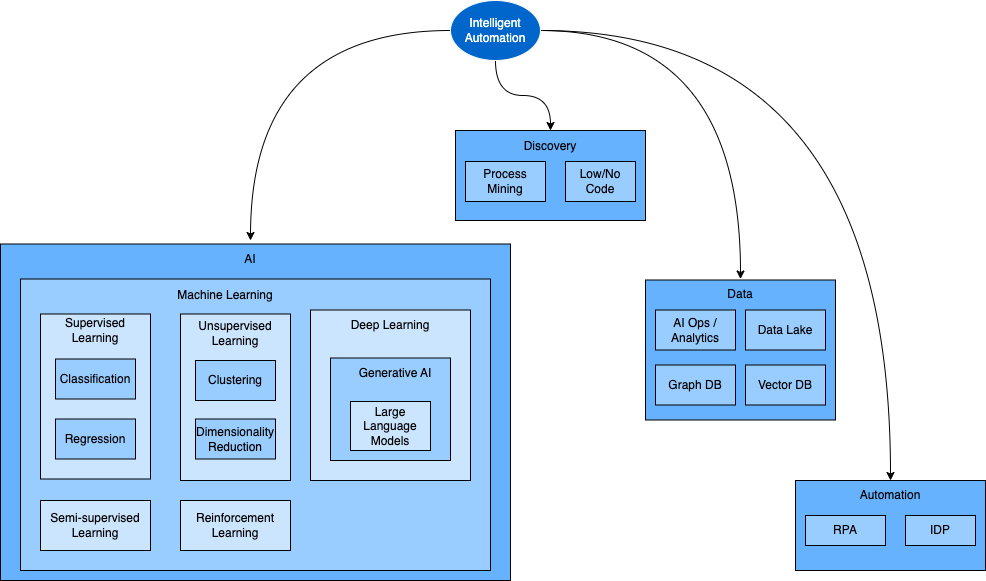
Artificial Intelligence (AI)
AI is the key enabling technology that makes automation smart and intelligent. Rather than simply automating manual, repetitive tasks, automation can include more abstract decision-making capabilities. This is accomplished with machine learning models and algorithms that can help with tasks requiring human reasoning. Machine learning enables systems to learn from data and improve over time without explicit programming. By combining natural language processing with machine learning, cognitive automation can understand unstructured data, handle decision-making, and simulate human reasoning. It is ideal for complex tasks like risk analysis, forecasting, fraud detection, and personalized marketing. It is particularly useful in advanced use cases, such as analyzing legal documents or processing complex insurance claims.
Generative AI takes cognitive automation to the next level by allowing systems to create new content, such as writing articles, composing music, or even generating artwork. By leveraging generative AI, companies can save time and resources while also producing high-quality, personalized content at scale. The figure below shows the expected use case of Generative AI.
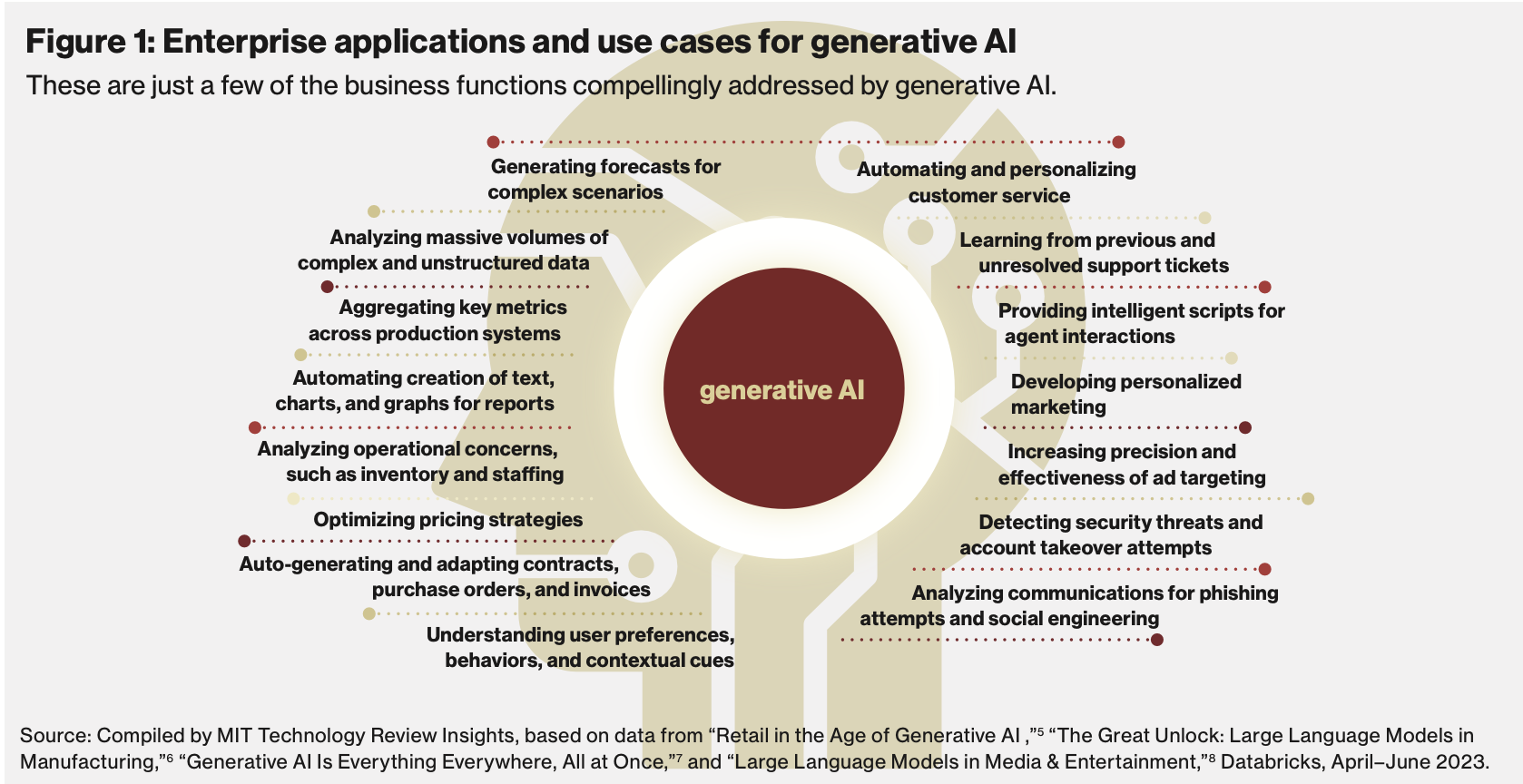
Task Automation
Business process automation is built out of workflows, and workflows are rules-driven. So, rule-based orchestration and robotic process automation systems continue to be important technologies in intelligent automation. Robotic process automation is ideal for automating rule-based tasks such as data entry, invoice processing, and basic administrative functions. It offers quick implementation and works well with existing applications. For more complex activities such as dealing with large volumes of documents (such as invoices, contracts, or forms), intelligent document processing technologies can be employed. IDP systems use AI to extract and classify data from unstructured content.
Process Discovery
Process mining and related business process management tools are used to analyze, monitor, and optimize end-to-end business processes. These tools provide insights into how processes are being executed within an organization, allowing for the identification of bottlenecks, inefficiencies, and areas for improvement.
Data Management
Data management technologies are an important part of intelligent automation and should not be overlooked. In addition to traditional relational and non-relational technologies that manage structured data, new capabilities such as graph and vector databases should be considered.
Graph databases are used to represent complex relationships and connections between data points, making them ideal for analyzing processes with multiple dependencies. Vector databases, on the other hand, are designed for high-speed querying and analysis of large datasets, making them essential for optimizing business processes in real-time. By incorporating these advanced data management technologies into intelligent automation systems, organizations can gain a deeper understanding of their processes and make more informed decisions.
Integration Capabilities
One of the most critical factors when selecting IA technologies is how well they can integrate with your existing IT systems and applications. Intelligent automation often interacts with various systems, such as enterprise resource planning (ERP), customer relationship management (CRM), and other business applications. Seamless integration is essential for avoiding data silos, ensuring smooth workflows, and driving collaboration between human workers and automated systems.
Non-functional Considerations
In addition to the functional capabilities, one must also consider the operational capabilities and constraints of IA technologies. A strong understanding of how the IA technology will operate within the existing infrastructure and processes of the organization is crucial for successful implementation. These non-functional considerations play a significant role in determining the overall effectiveness and efficiency of intelligent automation in enhancing business operations.
Scalability and Flexibility
When selecting IA technology, it’s important to consider the scalability of the solution. As the organization grows, so will the automation needs. The right platform should allow the expansion of the scope of automation beyond initial use cases, enabling the automation of additional processes, integration of new technologies, and deployment across multiple departments or regions. For example, a company implementing intelligent automation for customer service may start with automating basic inquiries through chatbots. As the company expands and customer needs evolve, the platform should be able to scale to automate more complex inquiries and integrate with new communication channels like social media or voice assistants. This flexibility ensures that the automation solution can adapt to changing business requirements and continue to enhance efficiency across various departments.
User Experience and Ease of Use
Successful adoption of IA technologies depends heavily on how easy they are to use and how quickly they can be integrated into the daily operations of the workforce. Tools that require minimal technical knowledge or coding experience can accelerate adoption and reduce resistance to change. It’s essential to seek platforms with user-friendly interfaces, intuitive design, and low-code or no-code functionality to cater to non-technical users.
Security and Compliance Considerations
Intelligent automation solutions will often process sensitive company data, so security and compliance should be top of mind when selecting a technology platform. Any potential solution should have built-in safeguards to ensure data privacy, protect against cyber threats, and comply with industry regulations.
Vendor Support and Ecosystem
The technology vendor’s support and the broader ecosystem around the platform also play a crucial role in determining its suitability. A supportive vendor can provide valuable resources, such as customer support, training programs, and access to a community of users, while the platform’s ecosystem can determine the availability of third-party solutions, integrations, and tools to extend functionality.
Role of Enterprise Architecture
Enterprise architecture (EA) provides the framework needed to align IA initiatives with overall business objectives, ensuring scalability, integration, and long-term success. EA helps to manage complexity by providing a holistic view of the organization’s current and target states, covering domains such as business architecture, data architecture, application architecture, and technology architecture.
Technical Reference Architecture
A strategic reference solution architecture for intelligent automation provides the foundation for the development of standards and solutions for business use cases. This Technical Reference Architecture serves as a blueprint for implementing automation technologies in a way that aligns with the organization’s overall goals and objectives. It also provides a common standard and prevents the proliferation of point solutions for automation requirements across the organization.
An example reference architecture is shown below.
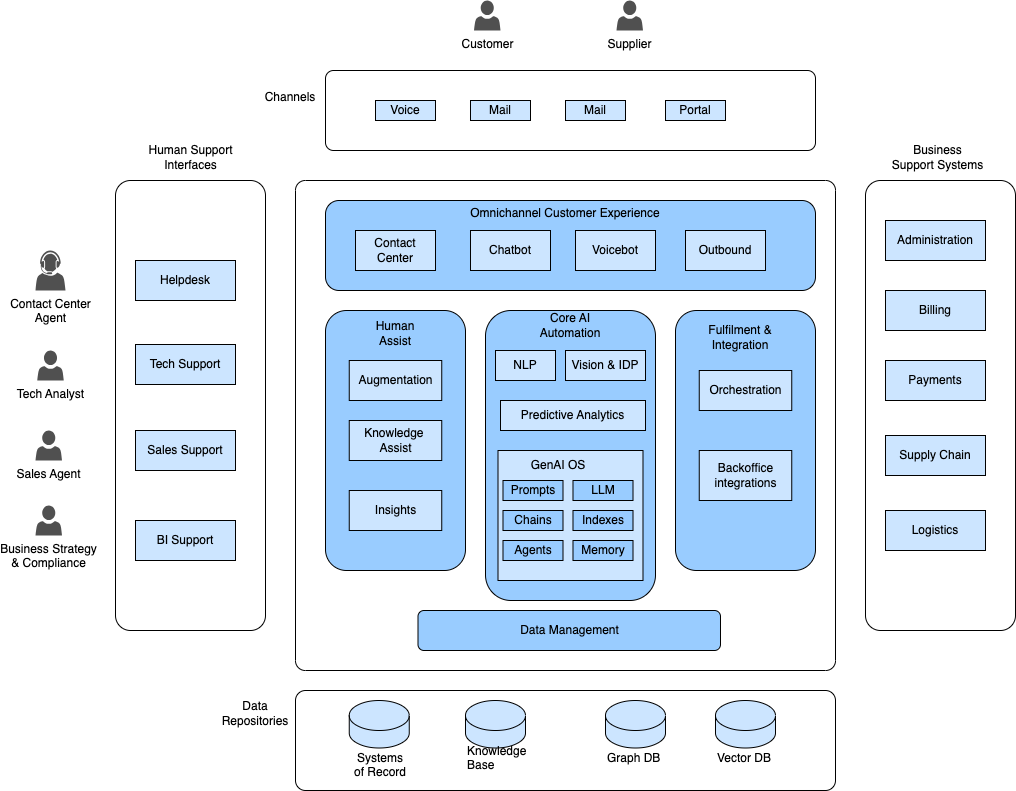
Alignment with Business Strategy
One of the core principles of enterprise architecture is ensuring that technology investments are aligned with business objectives. When implementing intelligent automation, it is crucial to identify how automation initiatives support the organization’s strategic goals. It can help with the definition of which business processes should be automated, where IA can deliver the most value, and how automation efforts fit into the broader digital transformation strategy.
By providing a top-down view of the organization, EA ensures that IA initiatives are prioritized based on their potential impact on business performance. This avoids the pitfall of automating processes in silos, ensuring that automation is aligned with the organization’s vision for long-term growth and competitiveness.
Scalability and Flexibility
Intelligent automation requires scalability to deliver value at the enterprise level. What may start as a small-scale automation project often needs to be expanded across departments or even globally. Enterprise architecture plays a crucial role in defining the standards, frameworks, and governance needed to scale IA solutions effectively.
EA ensures that automation solutions are built with flexibility in mind. This allows businesses to adapt to evolving technologies and business requirements without needing to overhaul their entire system architecture. For example, EA can help determine the best integration points for automation tools, enabling the reuse of automation solutions across different business units or functions.
Integration of Disparate Systems
A significant challenge when implementing IA is integrating it with existing systems and processes. Organizations often have a mix of legacy systems, cloud platforms, and third-party applications. Without a clear roadmap for integration, IA solutions can create isolated pockets of automation that fail to deliver enterprise-wide benefits.
Enterprise architecture addresses this challenge by mapping out the entire IT landscape and identifying how new IA technologies can seamlessly integrate with existing systems. By providing a holistic view of an organization’s IT infrastructure, EA enables the smooth integration of IA solutions, ensuring data flows across systems, and supporting end-to-end process automation.
Governance and Compliance
Intelligent automation entails managing substantial amounts of data, including confidential information. Implementing IA without proper governance can lead to data security vulnerabilities, compliance issues, and even operational disruptions. Enterprise architecture establishes governance frameworks that ensure IA solutions adhere to regulatory requirements, data privacy standards, and industry best practices.
EA helps organizations set policies for managing automation workflows, access controls, and data security protocols. By embedding governance into the IA strategy, EA ensures that automation projects are auditable, secure, and compliant, minimizing the risks associated with automation technologies.
Optimizing Technology Investment
Intelligent automation involves significant investments in technology, tools, and infrastructure. Without a structured approach, there is a risk of overinvesting in tools that don’t align with long-term goals or underutilizing existing assets. Enterprise architecture helps organizations make informed technology investment decisions by providing a clear understanding of how IA fits within the broader technology ecosystem.
EA provides insights into which automation technologies can be reused, what platforms need upgrading, and where new investments are necessary. This holistic view helps maximize the return on IA investments by ensuring that organizations choose the right tools for their needs and avoid redundant or conflicting technologies.
Enhancing Collaboration Across Teams
Implementing intelligent automation necessitates collaboration among IT, business process owners, data scientists, and compliance officers. Enterprise architecture facilitates collaboration by providing a shared language and common framework for understanding the organization’s automation goals and challenges. By promoting transparency and communication, EA enables stakeholders to work together more effectively, ensuring that IA projects meet both business and technical requirements. This collaborative approach reduces friction between departments and fosters a culture of innovation where automation initiatives can flourish.
Role of Data Architecture
Intelligent automation thrives on data—it’s the fuel that powers automated processes, machine learning algorithms, and AI-driven insights, such as real-time decision-making and personalized recommendations. Yet, without a well-defined and robust data architecture, even the most advanced IA tools can fail to deliver meaningful outcomes.
Data architecture is crucial for Intelligent Automation (IA) implementation, ensuring seamless data flow and optimal functionality. It supports real-time decision-making and AI-driven workflows.
Data Integration Across Systems
In most organizations, data is scattered across various systems—ERP systems, CRM platforms, data lakes, cloud services, and even legacy databases. For IA to deliver value, it requires access to data from all relevant systems. Data architecture plays a critical role in ensuring that disparate data sources are integrated effectively.
A well-constructed data architecture enables smooth data flow between systems, ensuring that automation tools can access the information they need in real-time.
Data Standardization and Quality
Inconsistent or low-quality data can lead to flawed insights, unreliable automated decisions, and process failures. Therefore, establishing data standards across the organization is critical to ensuring that IA systems work efficiently.
Data architecture defines how data should be structured, standardized, and cleansed. It ensures that data is uniform across all systems and processes, allowing IA solutions to function without errors caused by data inconsistencies. For instance, if an AI-powered chatbot is using customer data, good data policies ensure that the information is in a consistent format, with no duplicates or missing fields.
Data Governance and Compliance
Intelligent automation relies on data, including sensitive information such as personal customer data or confidential business details. Ensuring compliance with data privacy regulations (such as GDPR or HIPAA) is essential for avoiding legal risks and maintaining customer trust.
Data architecture defines the governance framework that controls data access, usage, and security across the organization. It establishes policies for the storage of data, who can access it, and how automation systems should handle it. Inadequate governance in IA initiatives can result in data breaches, regulatory infringements, and operational inefficiencies.
Enabling Real-Time Decision Making
One of the key benefits of intelligent automation is its ability to make real-time decisions. For instance, an AI-driven system can assess real-time data from IoT devices in a factory and adjust production processes instantly to optimize output. To support this kind of dynamic decision-making, the IA solution must enable real-time data access and processing.
Modern data architectures, such as event-driven architectures and real-time data streaming, allow IA systems to process large volumes of data instantly.
Supporting Machine Learning and AI Workflows
AI and machine learning are at the core of many intelligent automation solutions and require vast amounts of historical data, which needs to be easily accessible and well-organized. Effective data management provides the foundation for storing, managing, and processing the data required for machine learning workflows.
Moreover, as ML models are retrained with new data, the architecture must support versioning, monitoring, and governance of the models themselves. A scalable and flexible data architecture ensures that AI models can be continuously refined, improving the performance and effectiveness of automation systems over time.

Exercise: Tech Battle Royale

Course Manual 8: Lean Agile Development
Lean and Agile are separate methodologies for software development that have gained popularity in recent years. Lean focuses on eliminating waste and improving efficiency in the development process, while Agile emphasizes flexibility and collaboration among team members. Combining Lean and Agile methodologies can create a strong approach to developing automation solutions, enabling teams to deliver high-quality solutions rapidly and adapt to changing requirements efficiently. Combining Lean principles such as continuous improvement with Agile practices like iterative development and frequent feedback enables teams to streamline processes and enhance responsiveness in development.
Value Driven Development
IA Value Proposition
The value proposition of intelligent automation lies in its ability to streamline operations, enhance decision-making, and improve customer and employee experiences. Value-driven development prioritizes the needs and pain points of end users, ensuring that solutions directly address their challenges and enhance their experiences. This approach ensures that the solutions being implemented address real problems and provide tangible benefits to the organization.
The Value Proposition Canvas is a useful tool for identifying how automation solutions can pinpoint areas for improvement and innovation in business processes. It allows businesses to better understand the specific benefits that automation can bring to their organization and prioritize projects that will have the greatest impact on their bottom line. An example value proposition canvas is shown below.
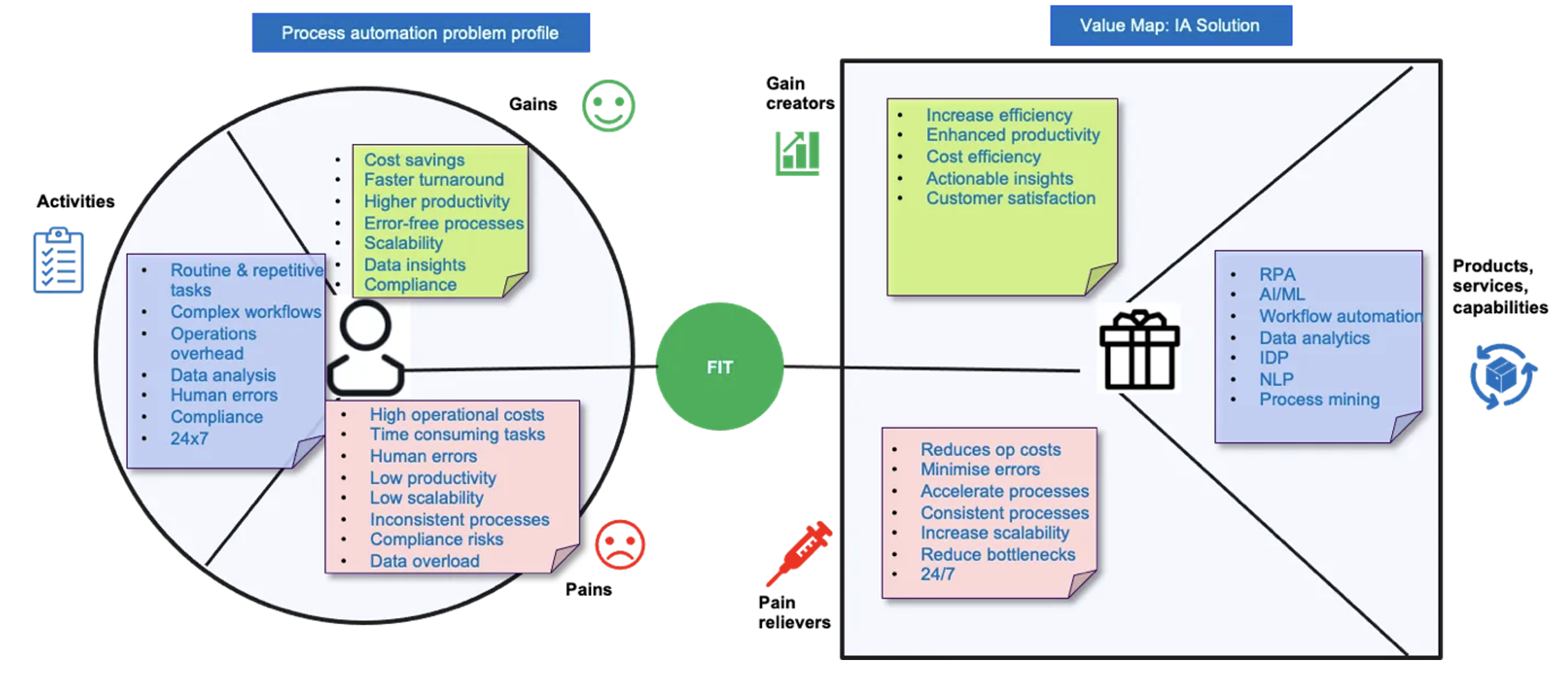
Through an analysis of the current business state and a comparison with the desired future state, organizations can gain insights into the strategic shifts required to fully utilize intelligent automation. The value proposition canvas can also highlight any gaps in resources or skills that may need to be addressed to successfully implement automation solutions.
Benefit Hypothesis
Benefit hypothesis is a Design Thinking concept used to validate the assumptions of a target audience’s requirements when developing a product or service. It ensures that process automation meets the needs of the business and that resources are prioritized to provide the most value to end users. Developers can use benefit hypotheses to develop a minimal version of the automation solution to gain feedback from end users.
It begins with clearly identifying the potential value that automation could bring to an organization. This value could be financial (e.g., cost reduction), operational (e.g., increased efficiency), or strategic (e.g., enhanced customer experience). By clearly defining the expected benefits in advance, businesses can prioritize automation opportunities that align with their broader goals and achieve measurable results. For example, a benefit hypothesis might state, “By automating the invoice processing workflow using IA, we expect to reduce processing time by 60% and minimize manual errors, leading to a 15% cost reduction in operational expenses.”
Value Stream Mapping
Value stream mapping (VSM) is a powerful tool used to analyze, visualize, and improve business processes through automation. VSM helps organizations identify inefficiencies and bottlenecks within their workflows, making it easier to prioritize which processes should be automated for maximum value.
VSM offers a comprehensive visual representation of the end-to-end flow of value within an organization’s processes, highlighting inefficiencies and areas for improvement. It captures every step involved in delivering a product or service, from initial customer requests to final delivery. VSM helps organizations pinpoint inefficiencies, such as bottlenecks, long cycle times, unnecessary approvals, and other forms of “waste” (i.e., activities that do not add value to the customer). These inefficiencies are prime targets for automation. For instance, an insurance company might utilize Value Stream Mapping to uncover that manual data entry in claims processing is leading to delays. Automating this step using automation can significantly reduce processing time and eliminate human error.

Case Study: Value Stream Mapping for a Biotech Firm
[Source: https://flevy.com/topic/value-stream-mapping/case-value-stream-mapping-initiative-biotech-firm-life-sciences]
A biotech firm was facing challenges in its drug development pipeline due to inefficient processes and wasteful activities, impacting productivity and time-to-market. Initial analysis revealed overcomplexity in R&D protocols, communication breakdowns between departments, and outdated technology. Based on this analysis, the firm conducted a VSM exercise to dig deeper into root causes of inefficiency and waste.
After implementation of VSM, the firm was able to reduce cycle time by 25% by addressing bottlenecks and streamlining processes. Process-related costs decreased by 20% through the elimination of non-value-adding activities. Process cycle efficiency was improved by 15% through the integration of digital tools and adoption of best practices.
Lean Agile Methodology
Lean-Agile is a hybrid approach that combines the principles of Lean Thinking with the flexibility and adaptability of Agile methodologies. Lean, originating from Toyota’s production system, emphasizes maximizing value while minimizing waste. Agile, initially designed for software development, focuses on iterative delivery, collaboration, and rapid response to changing needs.
Together, Lean-Agile provides a framework that enables businesses to deliver value quickly and continuously, ensuring that processes remain efficient, customer-focused, and adaptable to change. By embracing Lean-Agile principles, organizations can implement IA in a way that maximizes value, minimizes waste, and drives continuous improvement.
Several reasons make Lean-Agile ideal for implementing intelligent automation.
Faster Time to Value
In traditional automation projects, long lead times and rigid structures often slow down progress. By contrast, the Lean-Agile approach encourages breaking down large, complex automation initiatives into smaller, manageable pieces, or “sprints.” This allows teams to deliver value incrementally and get feedback early. Instead of waiting months for a comprehensive automation solution, organizations can deploy working solutions faster, driving immediate value while fine-tuning the approach.
Continuous Improvement
Lean principles emphasize eliminating waste and continuously improving processes, which aligns perfectly with the objectives of IA. Automation projects often require ongoing optimization, as initial results may reveal new opportunities or challenges. Through iterative Agile cycles, organizations can refine their automation initiatives in real-time, ensuring that automation solutions evolve to meet business needs.
Alignment with Business Needs
Agile’s focus on collaboration ensures that IA implementations stay aligned with business goals. By working closely with cross-functional teams, stakeholders can identify which processes need automation and prioritize them accordingly. This close feedback loop allows organizations to focus on automating tasks that provide the most business value rather than automating for the sake of technology.
Scalability and Flexibility
Automation technologies evolve rapidly. An Agile approach allows businesses to stay flexible, adapting to new tools and capabilities as they emerge. It also allows for easy scaling. For instance, after successful completion of an automation sprint, the organization can replicate or adapt the process to other areas. Lean principles, on the other hand, ensure that automation is done efficiently and without unnecessary complexity.
Risk Mitigation
Large-scale automation projects can be risky, especially if they involve heavy investment and process changes. Lean-Agile mitigates this risk by embracing a “fail fast” mindset. By developing IA solutions incrementally, teams can quickly identify what works and what doesn’t. Early failures become learning opportunities rather than costly setbacks, enabling teams to adjust and avoid major losses.

Case Study: Lean Agile Mindset in Implementing SAFe
[Source: https://scaledagileframework.com/lean-agile-mindset/]
SAFe is a framework for implementing Agile at scale in large enterprises. It compiles principles of Lean, Agile, and DevOps methodologies to drive business agility in large scale transformation programs.
SAFe fosters a “Lean-Agile growth mindset” where the principles and essence of Lean Thinking and Agile are used together when applying SAFe in enterprises.
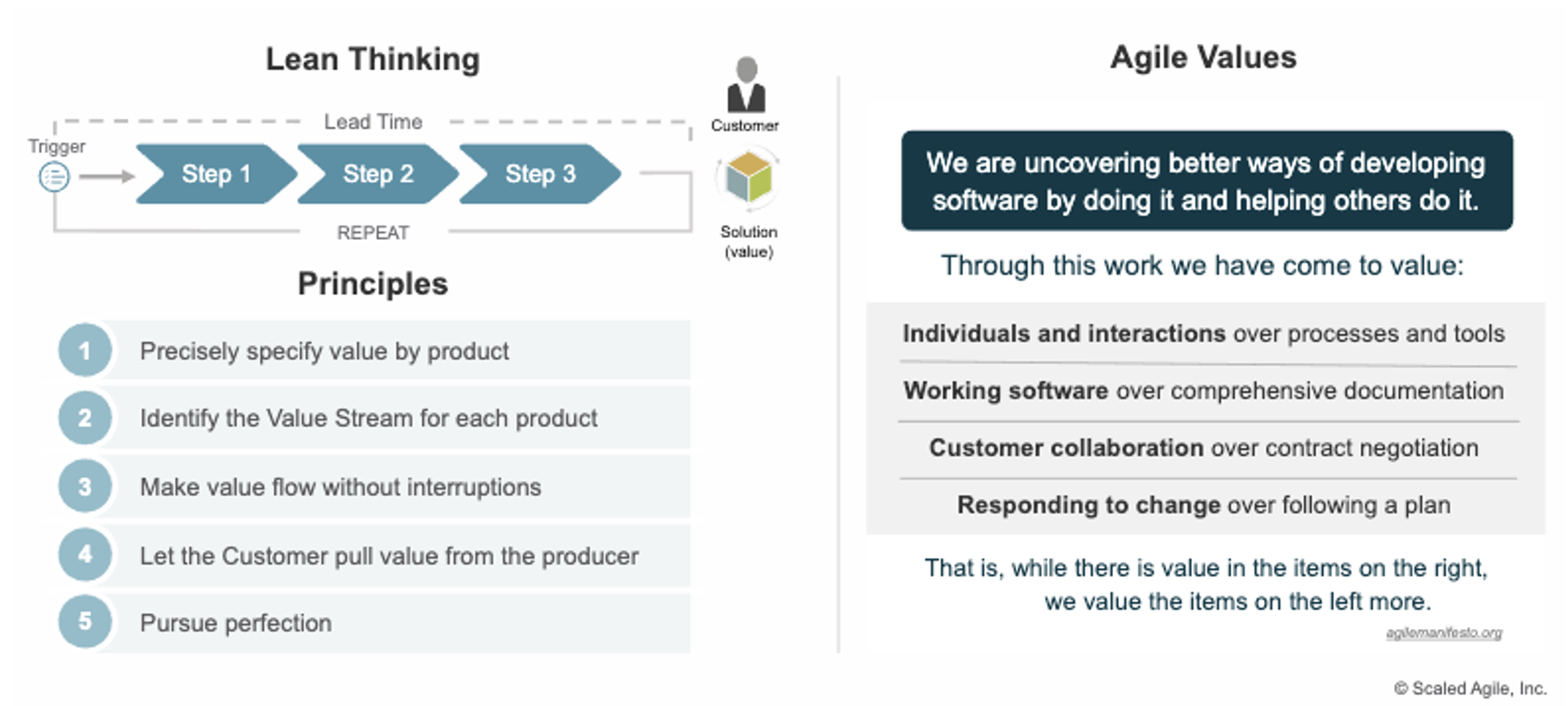
These principles collectively form the core values of the SAFe methodology.
Customer Development
A key challenge in IA implementation is the definition of problem requirements. The requirements often need to be refined iteratively, and this can be a lengthy and laborious process. The Customer Development process from the Lean Startup methodology can help in this regard.
It is a structured methodology that can help validate customer requirements, tailor IA solutions, and ensure that automation initiatives deliver measurable business value. It was originally aimed at helping startups understand their customers and build products that meet market needs. However, its principles are highly applicable to IA projects, and the process can help with understanding the specific pain points that IA can solve, validating the solution through pilot projects, and continuously refining the automation strategy based on feedback and performance data.
Implementing IA is a strategic initiative that often involves significant changes in business processes, workforce dynamics, and technology ecosystems. Without a deep understanding of customer needs, organizations run the risk of automating the wrong processes or failing to achieve the desired outcomes. There are four stages in the customer development process.
Customer Discovery
The first stage is all about understanding the customer’s needs, pain points, and the broader business context in which intelligent automation will be implemented. During this phase, the goal is to identify key processes that could benefit from automation and align IA solutions with the organization’s strategic goals. This is where benefit hypotheses are created for prospective solutions.
Customer Validation
In the second stage, organizations test the assumptions made during the discovery phase by building a prototype or running a pilot project. This allows them to validate whether the IA solution solves the identified problem and delivers tangible benefits.
Customer Creation
Once the IA solution has been validated through a successful pilot, the next phase involves scaling it to other processes, departments, or even across the entire organization. Customer Creation focuses on turning the validated solution into a broader IA initiative that generates lasting value across the organization.
Company Building
The final stage of the customer development process is about institutionalizing intelligent automation within the organization. This means moving beyond individual automation projects to embed IA into the core of business strategy, operations, and culture.
Solution Design
So far, the focus has been on the definition and validation of requirements. We now need to shift attention to the solution design. This stage involves creating a detailed plan for how the IA solution will be implemented, including the technology stack, architecture, and user experience. Solution design also involves considering scalability, security, and integration with existing systems.
The solution design process involves the following steps.
Understanding business objectives and mapping out the processes that will be automated. Tools like process mining, process mapping, and value stream mapping can help visualize workflows, highlighting inefficiencies and opportunities for automation.
Selecting the right automation technologies ensures that the solution is built with the best-fit technology in a cost effective manner.
Integration and scalability must be considered to understand how automation technologies will integrate with existing systems, such as ERPs, CRMs, or legacy systems. Additionally, the design should account for scalability—allowing the automation solution to grow as the business expands or as new processes need to be automated. Scalability ensures that the IA solution can accommodate future business needs without significant rework.
User centric design considers the user experience, ensuring that automation complements human work rather than disrupting it. This could involve designing user-friendly interfaces, providing employees with tools to oversee or intervene in automated processes, and ensuring that the transition to automation is smooth.
Risk management and compliance are important to identify potential risks and ensure compliance with industry standards or regulations. IA systems must handle data securely, especially in industries with strict regulations like healthcare, finance, or insurance. The design should include built-in checks for monitoring compliance, managing exceptions, and ensuring data security and privacy.
Exemplar Blueprints
IA solutions can benefit from pre-designed templates or frameworks that guide the implementation of automation projects. These blueprints represent best practices and proven strategies, allowing organizations to fast-track their IA initiatives by leveraging established methods rather than building solutions from scratch. Exemplar blueprints can help automation projects in several ways.
Accelerating implementation: By starting with a pre-defined blueprint, organizations can reduce the time needed to design and implement automation solutions. These blueprints often come with predefined workflows, decision logic, and integration points, streamlining the setup process and reducing the trial-and-error phase of design. For example, blueprints for automating invoice processing, customer service inquiries, or data extraction are widely available, allowing teams to deploy automation faster.
Standardizing best practices: Exemplar blueprints reflect industry best practices and have been tested across multiple implementations. They offer a reliable approach to automation, ensuring that projects are based on proven methods and standards. This reduces the risk of errors or inefficiencies, especially for organizations new to intelligent automation. For instance, blueprints for compliance-related processes in finance or healthcare might include built-in regulatory checks, ensuring that the automation aligns with legal standards and reduces compliance risks.
Ensuring scalability: Blueprints are designed to accommodate both small-scale and large-scale automation initiatives. Organizations can implement the initial blueprint, gain value from it, and then expand or modify the blueprint as their needs grow. For example, an automation blueprint for handling customer support tickets can be scaled by integrating more complex AI-driven analytics or machine learning algorithms to enhance decision-making as the business scales.
Enhancing flexibility and customization: While exemplar blueprints provide a solid foundation, they also allow for flexibility. These templates can be customized to suit an organization’s unique needs, whether through tweaking workflows, integrating specific AI models, or adjusting performance metrics. The blueprint serves as a guide, but businesses retain the freedom to tailor it according to their specific goals and requirements. For instance, a blueprint for employee onboarding can be adjusted to include local regulatory compliance steps or specific company processes, making it a customized solution that fits perfectly within the organization’s framework.
Improving ROI and reducing costs: By using exemplar blueprints, organizations can significantly reduce the time and costs associated with solution design, testing, and deployment. With a blueprint that has already been tested and optimized, the need for extensive development is minimized. This leads to faster realization of the benefits of automation, improved return on investment (ROI), and reduced overall implementation costs.
Some common exemplar blueprints are as follows.
• Invoice processing blueprint: Automates the end-to-end process of handling vendor invoices, from receipt to approval and payment, with built-in validation and error handling.
• Customer support blueprint: Uses chatbots and AI to handle common customer queries, escalate issues when necessary, and provide real-time responses.
• Data extraction blueprint: Automates the extraction of structured and unstructured data from documents using AI and OCR (Optical Character Recognition) technologies.
• Compliance monitoring blueprint: Automatically monitors business activities to ensure they meet regulatory requirements, flagging non-compliant actions for review.

Case Study: NHS England Global Digital Exemplar
[Source: https://www.england.nhs.uk/digitaltechnology/connecteddigitalsystems/exemplars/]
The NHS Global Digital Exemplar (GDE) programme is an ambitious initiative by the National Health Service (NHS) in the UK aimed at accelerating digital transformation in healthcare. Launched in 2016, it involved a select group of NHS trusts to partner together to become global leaders in healthcare technology. A number of exemplars have been developed with the goal of adopting advanced digital systems, improving care delivery, and sharing best practices across the NHS.
One exemplar relates to appointment scheduling and patient communication. NHS staff previously spent a significant amount of time scheduling appointments, sending reminders, and following up with patients. By implementing robotic process automation, hospitals within the GDE program have automated appointment scheduling, reminders, and patient communication. The automation systems automatically send reminders via text, email, or phone and can reschedule appointments based on patient preferences. This automation significantly reduced missed appointments, improved patient engagement, and allowed administrative staff to focus on higher-value activities.
Another exemplar relates to electronic patient record management. Managing patient records is a time-consuming task that is prone to errors. The need for accurate data entry and retrieval is critical for ensuring high-quality care. An automated system is being used to automate the extraction, entry, and updating of electronic patient records. Automated data capture tools, combined with AI, ensure that data is accurately recorded and updated in real time, reducing human error. This has enhanced the speed and accuracy of record-keeping, streamlined clinical workflows, and ensured clinicians have up-to-date patient information at their fingertips.
Citizen Development
Citizen development is reshaping how businesses approach intelligent automation, empowering non-technical employees to create and deploy automation solutions without relying on traditional IT departments. Leveraging low-code and no-code platforms, citizen developers can automate repetitive tasks, streamline workflows, and build custom applications, accelerating the adoption of IA across the organization. These platforms provide visual tools, drag-and-drop interfaces, and pre-built templates, allowing users to design workflows and automate tasks without needing programming expertise. The advantages of citizen development in intelligent automation are as follows.
Accelerating automation initiatives: With citizen development, organizations can implement IA faster by decentralizing the development process. Instead of waiting for IT teams to build automation solutions, business users can quickly create automations for tasks like data entry, reporting, or customer support.
Bridging the IT-business gap: Citizen development brings IT and business teams closer by empowering non-technical users to automate processes that directly impact their daily work. This reduces the backlog of requests for automation and allows IT teams to focus on more complex, high-priority projects.
Fostering innovation and agility: When employees can independently identify and automate time-consuming tasks, it fosters a culture of innovation. Citizen developers, who are closest to the business processes, are often best positioned to spot inefficiencies and create automation solutions tailored to specific needs.
Lowering the barrier for automation: Low-code platforms make it easy for employees to experiment with automation, reducing the learning curve typically associated with traditional software development. This democratization of automation allows even small departments or teams with limited technical resources to benefit from IA.
Agile Delivery
Agile delivery plays a crucial role in the successful implementation of Intelligent Automation (IA), helping organizations quickly adapt to change, deliver value incrementally, and mitigate risks throughout the automation journey. By breaking down complex IA projects into manageable sprints, Agile enables teams to implement automation solutions iteratively, refining them based on continuous feedback and real-world outcomes.
Agile delivery supports intelligent automation in a number of ways.
Incremental delivery of automation solutions: Rather than automating entire systems in one large project, Agile delivery allows IA projects to be broken down into smaller, more manageable pieces. Teams can automate specific tasks or workflows in each sprint, providing immediate business value while reducing the complexity and risk of large-scale implementation.
Continuous feedback and improvement: Agile’s iterative nature encourages constant feedback from stakeholders and end-users. This feedback loop helps ensure that the automation solution is aligned with business needs and is refined continuously, resulting in higher-quality and more effective automation outcomes.
Faster time to value: By delivering automation solutions incrementally, organizations can see benefits faster. For example, an RPA bot might automate a single process within weeks, allowing the business to realize efficiency gains while additional automations are developed in subsequent sprints.
Adapting to changing business needs: Intelligent automation projects often encounter evolving business requirements as automation solutions reveal new possibilities. Agile delivery enables teams to adapt to these changes by reprioritizing features, automating new processes, or improving existing ones in upcoming sprints.

Exercise: Build, Measure, Learn Challenge

Course Manual 9: Measuring Value
The Need for KPIs
Organizations need clear metrics and evaluation strategies to track their progress and determine whether their automation investments are yielding tangible results. It is crucial to measure the impact and success of intelligent automation to achieve long-term results and maximize ROI. Using a data-driven approach to assess IA success helps organizations improve processes, encourage innovation, and ensure continuous business growth support.
A continuous measurement framework not only aligns IA initiatives with strategic goals but also fosters accountability, transparency, and adaptability in the face of changing business landscapes. It enables organizations to proactively address challenges and seize opportunities for improvement, ensuring sustained value delivery. Measuring success helps organizations identify areas for improvement such as process bottlenecks, resource inefficiencies, and customer satisfaction gaps, leading to increased operational efficiency, cost-effectiveness, and competitive advantage in the market. Moreover, a robust evaluation framework facilitates transparent communication of outcomes and illustrates the influence of IA initiatives on overarching business objectives.
Measuring the impact of automation helps organizations with the following.
Ensure alignment with business goals: Assessing outcomes ensures IA aligns with strategic objectives, allocates resources effectively, and contributes to organizational success. Regular evaluation helps identify areas for optimization and drive continuous improvement, ensuring organizations remain competitive.
Optimize processes: Metrics help identify successful automation areas and areas needing improvement, enabling organizations to streamline processes, increase efficiency, and drive cost savings. Continuous optimization ensures short-term success and long-term sustainability, enabling agility in business operations.
Validate ROI: To justify automation costs, organizations should track KPIs like productivity, errors, and time-to-market. The data-driven approach helps justify initial investment, provides insights for process optimization, and drives continuous improvement. It results in better-informed decisions and improved operations.
Improve decision-making: Continuous measurement helps organizations refine automation strategies by analyzing trends and patterns. This approach aligns automation efforts with organizational goals, enhancing efficiency and driving continuous improvement and innovation. This continuous feedback loop ensures alignment with organizational goals.
Support scalability: Early automation success analysis aids in scaling across departments or regions. By identifying best practices, organizations can streamline rollouts, ensure consistency, and prioritize resources for maximum impact.
Process Efficiency and Cost Savings
Improving process efficiency is a key reason organizations invest in IA. Automating routine, repetitive tasks can dramatically reduce the time it takes to complete workflows, allowing human employees to focus on more strategic activities. Measuring the impact on process efficiency is a clear indicator of success. Streamlining operations and reducing unnecessary steps with IA can boost productivity and speed up cycle times. This not only improves financial performance but also enhances overall operational efficiency. Measuring and tracking these enhancements enables organizations to consistently refine and optimize their processes over time.
Key metrics for process efficiency include:
Cycle time reduction: Compare the time it takes to complete tasks before and after automation. A significant decrease in cycle time demonstrates improved efficiency.
Task completion rate: Measure the number of tasks completed in a given period (daily, weekly, monthly). Higher completion rates indicate increased process throughput.
Time savings: Calculate the total hours saved by automating manual processes and redeploying employees to higher-value tasks.
The value of these metrics and the time savings in process activities can be modelled as shown below.
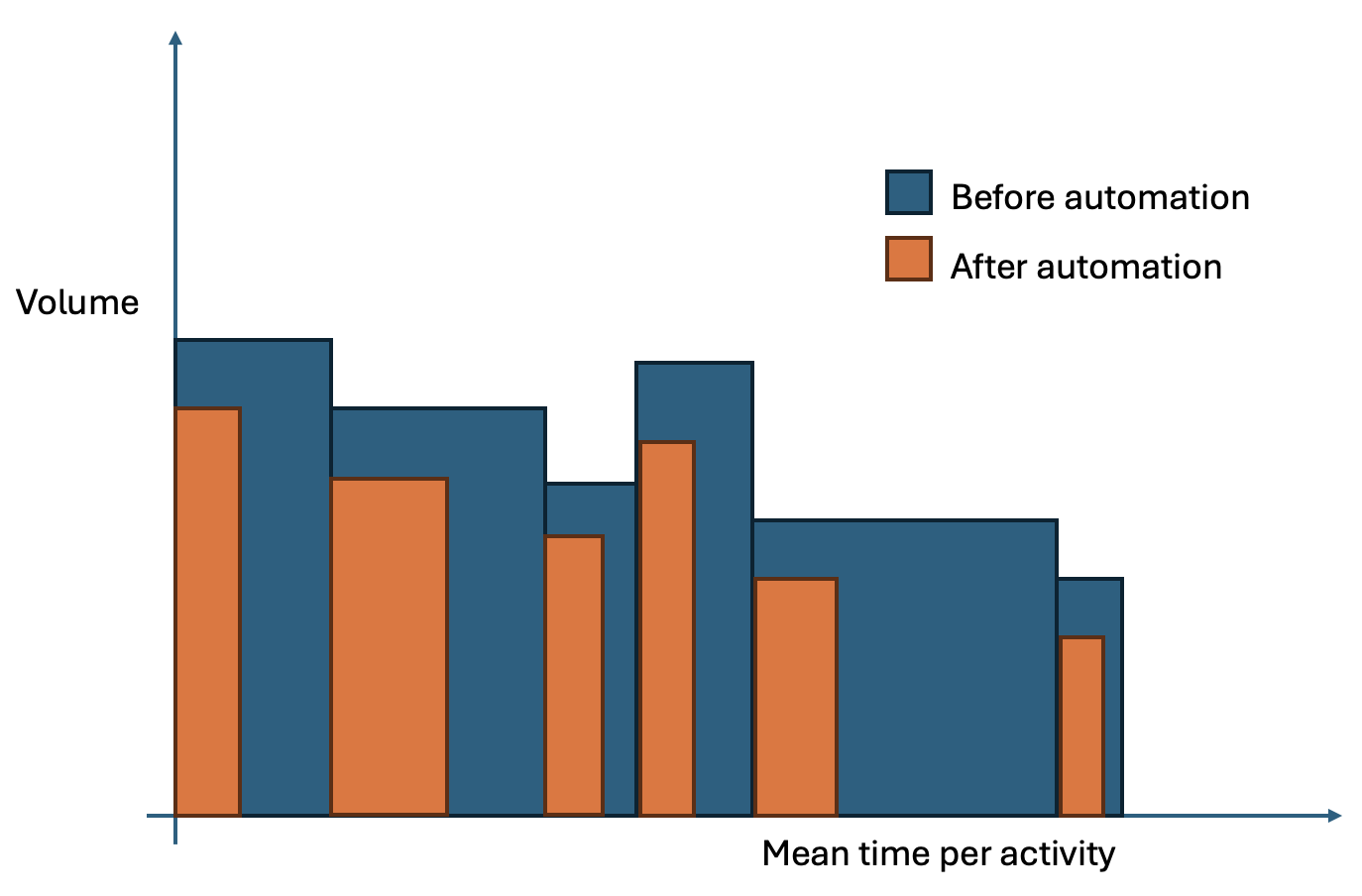
Cost reduction stands out as a primary driver for the implementation of intelligent automation. By automating tasks that previously required manual intervention, organizations can reduce labour costs, eliminate human errors, and avoid operational inefficiencies. To measure the financial success of IA, organizations must track cost savings and calculate their return on investment (ROI). One way to calculate ROI is to compare the costs of implementing intelligent automation against the savings achieved over a specific time period. This can help organizations determine the efficiency and effectiveness of their automation efforts. Additionally, by analyzing the impact of IA on productivity and employee satisfaction, organizations can further assess the overall benefits of implementing automation technologies.
Key metrics for cost savings include:
Labor cost reduction: Calculate how much the organization saves by automating labour-intensive tasks (e.g., reduction in full-time equivalent [FTE] hours).
Error reduction savings: Track cost savings due to fewer errors, rework, or compliance issues after automation is implemented.
ROI: Compare the total cost of IA implementation (including software, infrastructure, and training) against the financial gains achieved through cost savings and increased productivity.

Case Study: Consumer Electronics Company
[Source: https://sautomation.co.uk/case_studies/intercompany-reconciliation/]
The company identified the corporate finance department as an area that had huge inefficiencies and manual, repetitive tasks that were ideal for automation. Each month, the entities would submit AP/AR spreadsheets to the Global Accounting office via a shared network drive.
They put in an automation solution for the validation and reconciliation of data.
The company reported 80% FTE time-saving in the process and the accounts department was able to improve KPIs for their month-end reporting.
Case Study: Healthcare Insurer
[Source: https://www.cognizant.com/us/en/case-studies/intelligent-automation-strategy-health-insurer]
Cognizant implemented automation for one of their healthcare clients who wanted to improve their processing of 100,000 claims per day.
The solution involved augmenting the client’s workforce with more than 2,000 bots. The bots run 20 hours a day, six days a week, and include self-healing properties to ensure minimum downtime without manual intervention.
The solution enabled claims to be processed 600% faster and yields an 8x ROI.
Accuracy and Error Reduction
One of the significant benefits of automation is the elimination of human errors, particularly in tasks that involve large amounts of data, repetitive actions, or complex calculations. Errors can lead to costly rework, compliance risks, and customer dissatisfaction. For example, a financial services company implemented robotic process automation to automate their claims processing system. By using bots to handle data entry and calculations, they were able to drastically reduce errors and ensure accuracy in their claims processing. This not only improved customer satisfaction but also saved the company time and money by avoiding costly mistakes.
Measuring how automation improves accuracy is crucial to understanding its success. By reducing errors, automation can also improve overall efficiency and quality of work. This leads to increased customer satisfaction and loyalty, as well as a more positive reputation for the organization. Additionally, the time saved from not having to correct mistakes can be redirected towards more strategic tasks, further enhancing productivity and profitability.
Key metrics for error reduction include:
Error rate reduction: Compare the number of errors (e.g., data entry mistakes, compliance violations) before and after automation. A reduction in errors translates to improved accuracy and fewer risks.
Compliance adherence: Track the number of compliance breaches or incidents that occur after automation to ensure that IA is enhancing regulatory compliance.
Rework cost savings: Quantify the financial and time savings generated by reducing the amount of rework needed due to fewer errors.

Case Study: Fulcrum Digital
[Source: https://fulcrumdigital.com/case-studies/risks-and-human-errors-reduction-with-smart-automation/]
One of the company’s clients was facing a challenge with complex and tedious manual reporting.
The organization generates weekly, monthly, and quarterly reports to track performance. The challenge was to automate these reports from multiple systems, reducing manual work and rework. The team assessed the setup and developed a plan to automate the process.
An RPA-based solution was put in place that used bots to extract data from multiple systems, format it into tables, pivots, and charts, and send reports to stakeholders, handling exceptions and using AI/ML models for accurate results.
The solution resulted in reducing errors and achieving high accuracy, as well as savings in time and effort.
Customer Experience and Employee Productivity
Intelligent automation can significantly impact customer experiences by reducing response times, improving service accuracy, and ensuring a seamless journey through automated workflows. Measuring customer satisfaction and service improvements is a vital component of understanding IA’s overall business impact. By streamlining processes and eliminating human error, IA can enhance customer satisfaction by providing quicker and more accurate service. This can lead to increased loyalty and repeat business from satisfied customers. Additionally, the data collected from automated processes can be analyzed to identify areas for further improvement and drive continuous enhancement of customer experiences.
Key metrics for customer experience improvement include:
Customer satisfaction score (CSAT): Measure customer satisfaction through surveys or feedback tools, comparing scores before and after automation.
Net promoter score (NPS): Track the willingness of customers to recommend your organization based on their experience with your automated services.
Service level agreements (SLAs) adherence: Monitor the ability to meet or exceed SLAs for response times, order fulfilment, or customer support with automation in place.
Contrary to the common fear that automation will replace jobs, intelligent automation often enhances employee productivity by freeing workers from mundane tasks and enabling them to focus on more strategic, creative, and value-driven activities. For example, a company implementing automation in their customer service department can track NPS to see if customers are more satisfied with the quicker response times and efficient service. They can also monitor SLA adherence to ensure that automated processes are meeting or exceeding the agreed-upon standards for order fulfilment and customer support.
Measuring how automation impacts employee engagement and productivity is key to evaluating its broader organizational success. By allowing employees to shift their focus to more meaningful tasks, automation can increase job satisfaction and overall engagement. This can lead to a more motivated workforce that is willing to go above and beyond to achieve company goals. Additionally, by measuring the impact of automation on employee productivity, organizations can ensure that they are maximizing the benefits of this technology while also supporting their workforce in reaching their full potential.
Key metrics for employment productivity improvements include:
Employee productivity increase: Measure the increase in output from employees after automation. This can be tracked by comparing the number of high-value tasks employees complete before and after automation.
Time spent on value-added activities: Track how much more time employees spend on critical, non-automated tasks (e.g., decision-making, customer relationship management, innovation).
Employee satisfaction and engagement: Use surveys or feedback tools to gauge employee satisfaction and engagement post-automation. Engaged employees are more likely to embrace and benefit from IA.

Case Study: Airline Customer Experience
[Source: https://www.cognizant.com/us/en/case-studies/chatbot-improves-airline-customer-experience]
One of Cognizant’s airline clients saw a change in customer behaviour regarding contact centre engagement and took proactive measures to find new ways to engage with customers who typically ignored the airline’s Frequently Asked Questions page and called the contact centre directly. The airline aimed to lower direct call costs while maintaining round-the-clock passenger assistance.
Cognizant implemented a virtual agent chatbot for the airline that would converse with customers and automate their requests.
As a result of the solution, the virtual assistant was able to answer 80% of queries with 90% accuracy.
Case Study: U.S. healthcare equipment and service provider
[Source: https://us.nttdata.com/en/case-studies/intelligent-automation-elevates-staff-productivity-and-customer-care]
NTT Data worked with a healthcare provider that serves two million customers. They wanted to maximize operational efficiency, boost productivity, and improve patient satisfaction.
NTT DATA implemented an intelligent automation solution to transform the organization’s operational workflows, resulting in more quick and effective claim and order processing— and expedited new patient onboarding. Using an RPA platform, they automated over 50 business processes related to order processing and claims authorization.
The solution resulted in time savings of 20 seconds per claim or order and freed 75+ FTEs from repetitive manual claim and order processing
Adoption and Innovation
Measuring the adoption rate of IA in departments such as finance, human resources, and customer service can indicate how effectively automation is being integrated and scaled within the organization. Success is often reflected in how quickly and easily IA can be extended to new use cases, regions, or business units. Having a high adoption rate indicates that employees are comfortable with using IA tools and are realizing the benefits of automation. Scalability is crucial for organizations looking to expand their use of IA across various functions and locations. The ability to seamlessly integrate IA into new areas of the business demonstrates the flexibility and effectiveness of the technology.
Key metrics for measuring adoption include:
Automation penetration rate: Track the percentage of business processes or tasks automated over time. A higher penetration rate indicates successful adoption and scalability.
Number of processes automated: Measure the number of processes that have been successfully automated since the IA initiative began.
Adoption rate by department or team: Evaluate how many teams or departments have embraced automation and how it has improved their operations.
Intelligent automation has the potential to enhance an organization’s agility and ability to innovate. For example, a company implementing intelligent automation technology may track their automation penetration rate by monitoring the percentage of customer service inquiries resolved using chatbots. They may also measure the number of HR processes automated, such as onboarding new employees, to gauge the success of their IA initiative within the organization. This data can help identify areas for improvement and showcase the benefits of adopting intelligent automation across different departments.
Automation can reduce the time it takes to launch new products, enter new markets, or adapt to changing customer needs. Measuring the impact on business agility and innovation helps ensure that automation is driving long-term competitiveness. By streamlining processes and increasing efficiency, IA allows organizations to pivot quickly in response to market changes and customer demands. This flexibility enables companies to stay ahead of the competition and seize new opportunities as they arise.
Key metrics for measuring impact in innovation include:
Time-to-market reduction: Measure the decrease in time it takes to launch new products or services due to faster, more efficient processes.
Innovation index: Track the number of new products, services, or business models introduced since automation was implemented.
Response time to market changes: Assess how quickly the organization can respond to market or customer shifts with automation-enhanced processes.
A Continuous Measurement Framework
A continuous measurement framework is valuable for consistently tracking key metrics and adapting strategies based on insights. This framework should include monitoring key performance indicators related to efficiency, cost savings, and customer satisfaction. The framework includes tools and templates to model and analyze performance metrics. It enables a methodology to identify what metrics to measure and a classification of metrics. The methodology also includes the association of KPIs with business processes and users, as well as data collection, interpretation, and reporting.
Other key characteristics of a KPI framework include:
Setting baseline data: Gather data on current performance before implementing automation to create a benchmark.
Regular reviews: Conduct quarterly or bi-annual reviews of IA metrics to track progress and make necessary adjustments.
Stakeholder feedback: Continuously gather feedback from employees, customers, and stakeholders to refine and improve automation initiatives.
Iterative improvement: Use the data collected to iterate and optimize automated processes, ensuring that IA continues to deliver value over time.

Case Study: KPI Institute
[Source: https://kpiinstitute.org/Performance-Measurement-Framework-6-Pillars-worldwide.pdf]
The KPI Institute helps organizations build performance measurement capabilities, and they have consolidated their best practices into a framework of “six pillars”:
1. KPI Selection: KPI selection is a challenging aspect for professionals, often leading to organizations focusing on easy-to-measure or traditional KPIs, despite having experience in using them for decision-making.
2. KPI Documentation: The documentation of performance measurement approaches for monitored KPIs establishes a standardized and reliable framework, ensuring a consistent measurement process and clear procedures for data custodians.
3. Target Setting: Target achievement, a part of KPI documentation, is considered a separate pillar due to its significant impact on employee performance and professional competencies.
4. Data Gathering: Data gathering is a challenging process for measuring performance, involving issues like timeliness, accuracy, and completeness, and may be more expensive than anticipated.
5. KPI Data Visualisation: The KPI Measurement Framework emphasizes data visualization competencies for efficient management, facilitating the understanding and reporting of KPI results through visually appealing scorecards, dashboards, or reports.
6. Governance: The Performance Measurement Governance Framework identifies key stakeholders involved in the system and their roles and responsibilities.
Case Study: SOPHOI Archipelago Eco Investors
[Source: https://sophoi.co.uk/2023/06/developing-kpi-frameworks-for-impact-investment-results/]
Archipelago Eco Investors (AEI) is an investment firm that was looking for investment opportunities to generate value from plastics reduction, reuse, and recycling. They wanted to deliver and demonstrate social, environmental, and financial return on investments in this nascent but expanding sector.
SOPHOI created a KPI framework based on three quantitative, impact-level KPIs: CO2 emissions avoided, tonnes of virgin plastic avoided, and financial return on investment. The KPI framework is structured so that results can be aggregated upwards from individual investor companies, through AEI as the fund manager, and up to overall impact, as shown below.
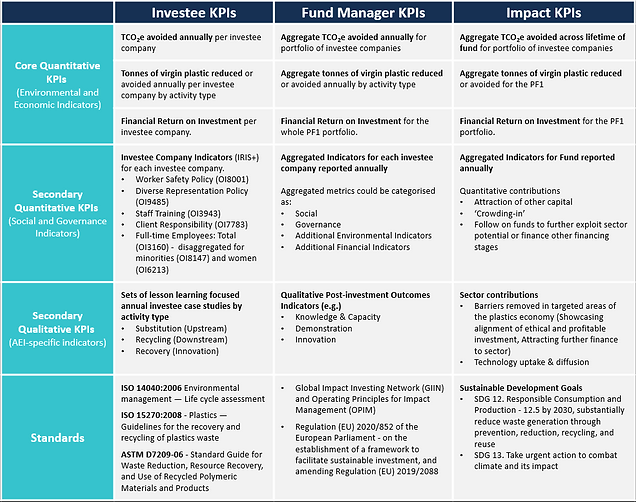
The KPI framework has enabled better impact investment decision-making, where fund managers learn which investments work and why.

Exercise: The KPI Game Show
• For invoice processing: “Time to process an invoice,” “Number of invoices processed per hour,” “Error rate in invoice data entry.”
• For HR onboarding: “Time to onboard a new employee,” “Employee satisfaction with the onboarding process,” “Reduction in paperwork.”
• For the customer service chatbot: “Response time to customer inquiries,” “Number of inquiries resolved by chatbot,” “Customer satisfaction score.”.

Course Manual 10: Roadmap Delivery
Once the main components of the IA roadmap are understood, it is time to think about bringing the roadmap to life. To accomplish this, the first step is to establish an implementation timeline. This timeline should outline key milestones and major activities for each phase of the IA implementation process. The next step is to adopt a project management approach to manage the development and delivery of IA as an enterprise program rather than a set of technical point solutions. The actual implementation of solutions consists of two phases. A pilot phase where initial prototype solutions are implemented to validate and gain feedback. Following this, the organization-wide development and deployment of solutions ramps up during the scaleup phase.
Implementation Timeline
A project roadmap with key milestones and a broad timeline provides a high-level view of an IA project or program and explains the different phases. It acts as a guide and communication tool to keep the stakeholders informed. It helps ensure that all members of the organization are on the same page and working towards a common goal. Additionally, it enables project managers to monitor progress, identify potential roadblocks, and make necessary adjustments to keep the project on track. Having a clear timeline helps bring clarity in support of the roadmap.
Managing expectations: Stakeholders understand when key milestones will be reached and the likely timeframe for seeing results.
Resource allocation: Ensures that people, time, and budgets are appropriately assigned at each stage of implementation.
Risk management: Helps identify potential bottlenecks or risks early, allowing for contingency planning.
Measuring progress: Provides a framework for tracking progress and performance at each stage.
An example roadmap timeline is shown below.
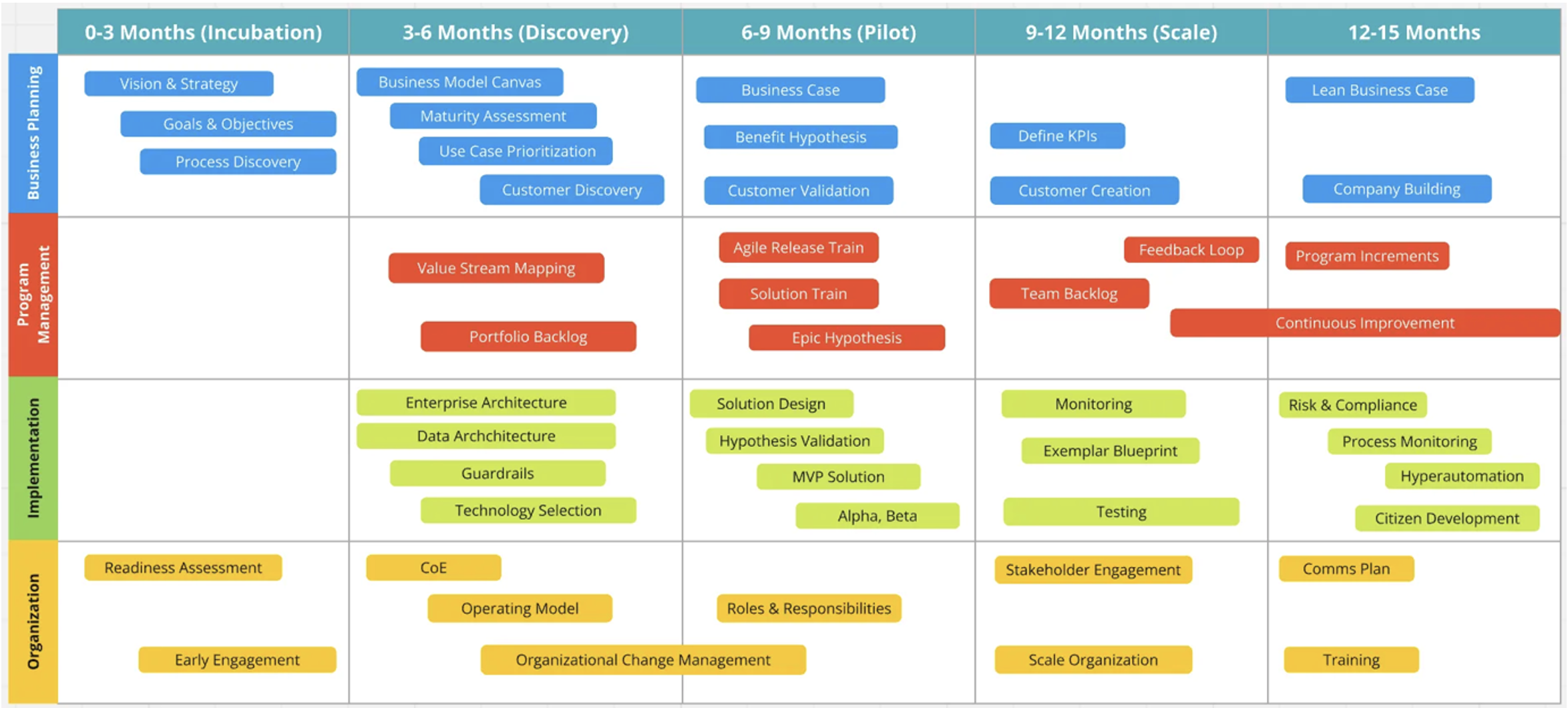
Different perspectives—business planning, program management, implementation, and organization—organize the timeline. This makes it clear what tasks various parts of the organization are responsible for carrying out. The timeline also progresses through stages to show when various activities are to be carried out. Each phase has its own unique milestones and deliverables, and mapping out these phases helps organizations take a structured approach to IA deployment. It’s important to note that the timescales provided in the example may vary depending on the organization’s size, maturity, and specific requirements. Actual timelines will vary depending on factors such as the organization’s size, maturity level, and specific project requirements.
0-3 months: Incubation
This is the initial exploratory phase where the vision, strategy, and objectives are laid out, together with an initial discovery of processes to be automated. A readiness assessment of the organization is done in this stage, as well as engagement with the sponsor and probing of interest in intelligent automation throughout the organization.
3-6months: Discovery
The next discovery phase is all about planning, where maturity assessment is conducted and process use cases are analyzed to identify and prioritize automation opportunities. This will result in an initial portfolio backlog that will be used for value stream mapping. From the technical perspective, this phase is about architecture readiness and technology selection. In terms of the organization, the CoE is set up together with the operating model.
6-9 months: Pilot development
In this phase, initial prototype solutions are developed to gain validation and feedback on benefit hypotheses. The solution and ART backlogs are developed here along with Epic hypotheses. The roles and responsibilities of CoE and support teams are also defined here. An organizational change management plan is also defined. The output of this phase should include a minimum viable product/solution (MVP).
9-15 months: At scale deployment
Once the benefit hypotheses have been validated and an MVP is in place, the next phase is aimed at scaled-up deployment. Continuous improvement processes and lean business cases are set up to deliver a backlog of validated features in program increments. Non-functional requirements as well as risks and compliance issues are considered in this phase. Enhanced functional capabilities are introduced, and employee communication and training plans are set in place.
Adjusting the Timeline Based on Organizational Factors
While the phases outlined above provide a general roadmap for implementing intelligent automation, the exact timeline may vary depending on several organizational factors.
Complexity of processes: Highly complex processes may require longer planning, testing, and refinement phases.
Size of organization: Larger organizations may need more time for scaling and training across different departments and regions.
Regulatory and compliance requirements: Certain industries may face strict compliance requirements that extend the timeline for readiness assessments and governance setup.
Resource availability: The availability of technical expertise, budget, and leadership support can impact how quickly an organization can implement IA.
Technology infrastructure: Organizations with outdated or siloed systems may need more time to integrate automation tools with existing infrastructure.
Agile Program Management
Agile program management is a dynamic and iterative approach to managing large, complex projects. Unlike traditional project management methods, which follow a linear, phase-based process, Agile emphasizes flexibility, collaboration, and continuous improvement. Teams work in sprints—short, focused work periods where specific tasks are completed—and prioritize rapid delivery of value over long planning cycles.
In the context of intelligent automation, agile program management is particularly useful because automation technologies evolve quickly, and businesses need to be able to respond to new opportunities and challenges as they arise.
Scaled Agile program management extends Agile principles beyond individual teams to encompass the entire organization. It’s designed to manage complex, cross-functional projects that involve multiple teams working in parallel, often across various departments or business units. SAFe helps synchronize these efforts, ensuring that teams remain aligned with strategic objectives while delivering incremental value.
For intelligent automation, which often involves automating processes across multiple departments (e.g., finance, HR, IT, and operations), frameworks such as SAFe provide a structured approach to scaling automation initiatives without losing agility or speed.
Scaled Agile Framework (SAFe)
SAFe is an agile methodology that aims to assist large organizations in managing and scaling complex projects by fostering collaboration, transparency, and iterative delivery, ultimately promoting organizational agility. It provides a set of principles and practices for managing workflows across multiple teams, aligning them with business goals, and ensuring rapid delivery of value.
By following SAFe principles, organizations can ensure that cross-functional teams are aligned, dependencies are managed effectively, and communication flows smoothly throughout the entire process. This framework also emphasizes the importance of feedback cycles, allowing for continuous improvement and adaptation as the project progresses. Overall, utilizing SAFe in conjunction with the four key phases of IA implementation can lead to a successful and sustainable deployment of automation technologies within an organization.
SAFe consists of four levels:
1. Team: Individual agile teams following frameworks like Scrum or Kanban.
2. Program: Coordination across multiple teams working toward common objectives.
3. Large Solution: Scaling for larger projects with additional dependencies.
4. Portfolio: Aligning automation efforts with enterprise strategy and managing investment.
All four levels are important for automation projects. The Large Solution level allows for scaling up automation projects to meet the needs of larger initiatives, while the Portfolio level ensures that automation efforts are in line with the overall strategy of the organization and are managed effectively. By integrating these four levels of SAFe with the key phases of IA implementation, organizations can ensure a successful and sustainable deployment of automation technologies that drive business value and innovation.
A full configuration of SAFe 6.0 is shown below (courtesy scaledagileframework.com).
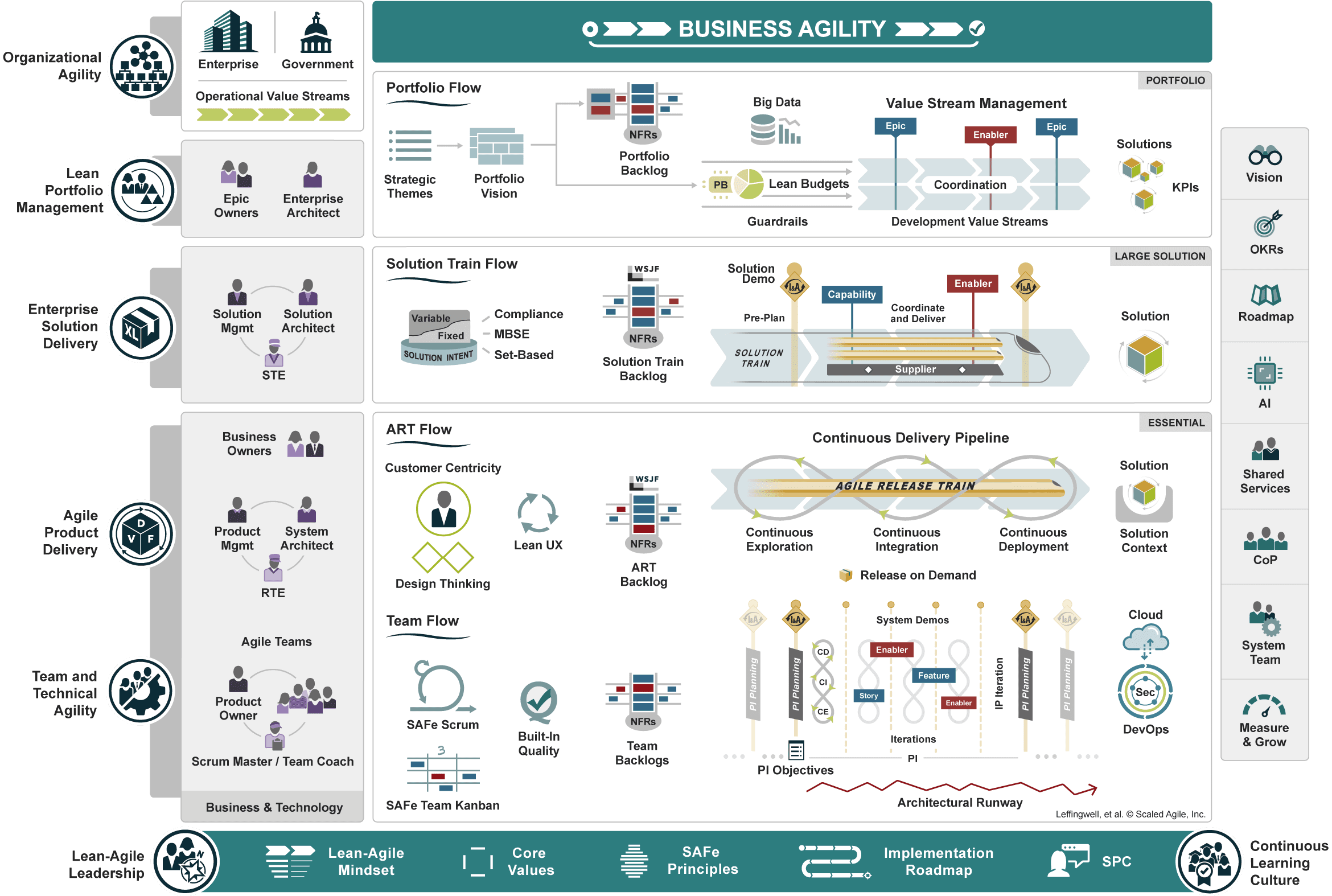
The following concepts in SAFe are very pertinent for intelligent automation.
Development Value Streams (DVS): The value stream concept is adopted from Lean Thinking and is fundamental to SAFe. A DVS is a unit of governance in a SAFe-managed portfolio and is committed to building, deploying, and supporting automation solutions. Key actions include the definition of value streams and creating a measurable flow of value. For example, a loan request process automation would include multiple DVS for different steps in the process, including front-end services and core banking services.
Agile Release Train (ART): The ART in SAFe represents a cross-functional team of teams working together to deliver value through automation. Each ART focuses on a set of automation use cases, delivering them in a series of Program Increments (PIs). Key actions include organizing teams around business functions (e.g., finance, HR, customer service) or technology platforms (e.g., RPA, AI), and planning PIs to deliver automation solutions in iterative cycles. As an example, a healthcare provider could create an ART focused on automating patient onboarding, medical billing, and claims processing across multiple teams.
Epic Prioritization: In SAFe, Epics are large bodies of work that need to be broken down into smaller tasks or features. When implementing intelligent automation, epics represent high-value use cases that deliver significant business benefits. These epics must be broken down into smaller tasks that can be tackled iteratively. For example, in a retail company, an epic might involve automating inventory management, with smaller features such as automating stock updates, reordering, and warehouse reporting.
Team Collaboration: SAFe emphasizes collaboration across teams and departments. To implement intelligent automation successfully, cross-functional collaboration between business units, IT, operations, and automation teams is essential. Key actions include setting up of regular Scrum of Scrums meetings to align the efforts of different teams working on related automation use cases. As an example, an insurance company automating claims processing could involve both business teams (who understand the claims workflows) and IT teams (who implement automation solutions) in regular alignment meetings.
Program Increments (PIs): Program Increments (PIs) are time-boxed periods (typically 8-12 weeks) during which teams deliver a set of automation solutions. During each PI, teams work on delivering features and user stories related to the automation use cases identified in the planning stage. Key actions include conducting PI planning sessions to ensure teams are aligned on goals and priorities and using iterative sprints to develop and test automation features. An example of this would be an automotive company, during a PI, might focus on automating its supply chain processes, delivering automation for order processing and inventory tracking within the time frame.

Case Study: Standard Bank Adopts SAFe
[Source: https://v5.scaledagileframework.com/standard-bank-case-study/]
Standard Bank is Africa’s largest banking group and has approximately 600 projects to manage each year. It struggled to complete a fraction of the projects on time and on budget.
To address the complexities of program management, the bank decided to deploy SAFe across the organization. Before rolling out SAFe, the bank decided to address the culture and organizational change issue to prepare the workforce for new ways of working.
Also, to facilitate the shift, Standard Bank employed an automation challenge to spark interest in skills and set out to develop a fully automated, scripted self-provisioning environment.
This had several tangible results, including:
• 20 minutes: Time to deploy application server stack end-to-end
• 30 seconds: Time to release new code to customers
• 0 per cent: Deployment impact on customers
In the first program increment, 300 people got together from the Card and Emerging Payments group, which depends on more than 32 systems with numerous codependencies. This created a major shift in thinking and ways of working and served as the springboard to successive projects.
As a result of this initiative, the bank noted the following improvements:
• Time-to-market reduced from 700 to 30 days.
• Deployments increased from once or twice a year to monthly.
• Productivity increased by 50 per cent.
• Cost decreased by 77 per cent
Pilot Development
Pilot implementations provide a low-risk, high-impact way to assess the feasibility of automation, offering valuable insights before scaling automation across the entire organization. For example, the finance team could start by automating the initial steps of invoice processing (e.g., data extraction from invoices) while leaving more complex tasks, like payment authorization, for manual intervention during the pilot.
Pilot implementations also act as a test bed for Intelligent Automation solutions, allowing organizations to validate whether their chosen technologies, processes, and strategies work as intended before full-scale deployment. This helps organizations identify and address any potential issues or challenges early on, ensuring a smoother transition to automation.
The key activities involved in pilot development include:
• Develop the pilot automation solution for the selected use case(s).
• Integrate automation tools with existing systems and infrastructure.
• Conduct user acceptance testing (UAT) to ensure the solution works as expected and meets business requirements.
• Measure the performance of the pilot, including efficiency gains, error reductions, and overall ROI.
The key deliverables in a pilot solution include:
• Fully functional pilot automation.
• UAT feedback and adjustments.
• Performance metrics from the pilot project.
Pathway to Release
Pilot development may go through iterative stages of refinement before the solution is ready for wider-scale deployment. The iterative process helps gather feedback from end users and stakeholders to make necessary adjustments and improvements. The iterations may include the following.
Proof of concept: Essential to demonstrate the feasibility of a new idea or concept before investing significant resources into development. Moving from PoC to MVP allows for further refinement and testing of the idea to ensure it meets the needs of users.
MVP: Crucial stage in the development process because it represents a functional version of the product that real users can test and validate. This stage allows for valuable feedback to be incorporated into the final product, improving its overall quality and user experience.
Alpha release: The purpose of an alpha product is to define your launch feature set. Think of it as an advanced variation on your MVP, but testable. The alpha release is a crucial step in the development process as it allows for further refinement and optimization of the product before its official release. This stage involves thorough testing and gathering of feedback from a select group of users, helping to identify any issues or areas for improvement.
Beta release: The beta release is the next phase in the product development cycle, where the product is made available to a wider audience for testing and feedback. This stage allows for even more comprehensive testing and refinement, as a larger number of users can provide valuable insights into the product’s performance and usability.
Launch release candidate: This phase involves finalizing any last-minute adjustments and ensuring that the product is fully optimized for its official release. Companies may also use this time to create marketing campaigns and promotional materials to generate excitement and attract early adopters.
Pilot Evaluation
Testing and evaluation during pilot iterations must follow a few best practices.
Start small: Automate a limited scope of the process first, focusing on a few key tasks or workflows.
Test thoroughly: Conduct testing at every stage to ensure the automation is functioning correctly, including integration with existing systems.
Monitor in real-time: Use real-time monitoring to identify any issues or bottlenecks during the pilot and resolve them promptly.
Collect feedback: Gather feedback from employees who are interacting with the automation to identify any challenges they face during the transition.
Scaling Out
Once the pilot has been successfully tested and validated, the next step is to plan for scaling the automation solution across the organization. This includes refining the technology, optimizing processes, and preparing the workforce for broader adoption. Additionally, they will need to optimize processes to ensure efficiency and effectiveness across all departments. Lastly, preparing the workforce for broader adoption will involve training and change management to ensure a smooth transition to the automated system. For example, based on the success of the accounts payable pilot, the finance team might plan to scale automation to other processes, such as accounts receivable or expense management, while providing training and resources to employees to support the transition.
Key activities during the scaling phase include:
• Refine the pilot solution based on lessons learned during testing.
• Develop a roadmap for scaling automation to other business units or processes.
• Implement necessary infrastructure upgrades to support broader automation efforts.
• Roll out the automation solution in phases to minimize disruption to daily operations.
• Provide training and support for employees to ensure smooth adoption of new automated processes.
Key deliverables of the scaling phase include:
• Expanded automation footprint across the organization.
• Training materials and workshops for staff.
• Documentation of newly automated processes.
Capturing Feature Demand
As the adoption of intelligent automation grows across the organization, there will be increasing demand for features and new requirements. This demand is best managed in an Agile backlog, or more specifically in Solution Train or ART backlogs in SAFe terminology. Kanban systems are utilized to manage and visualize these backlogs, facilitating the continuous flow of value to end users by capturing, defining, evolving, and prioritizing features, capabilities, and enablers. The systems capture, define, evolve, and prioritize features, capabilities, and enablers to guarantee a constant flow of value to end users, ensuring that the organization meets evolving user needs effectively. The Kanban system facilitates a continuous delivery pipeline as shown below (courtesy scaledagileframework.com).
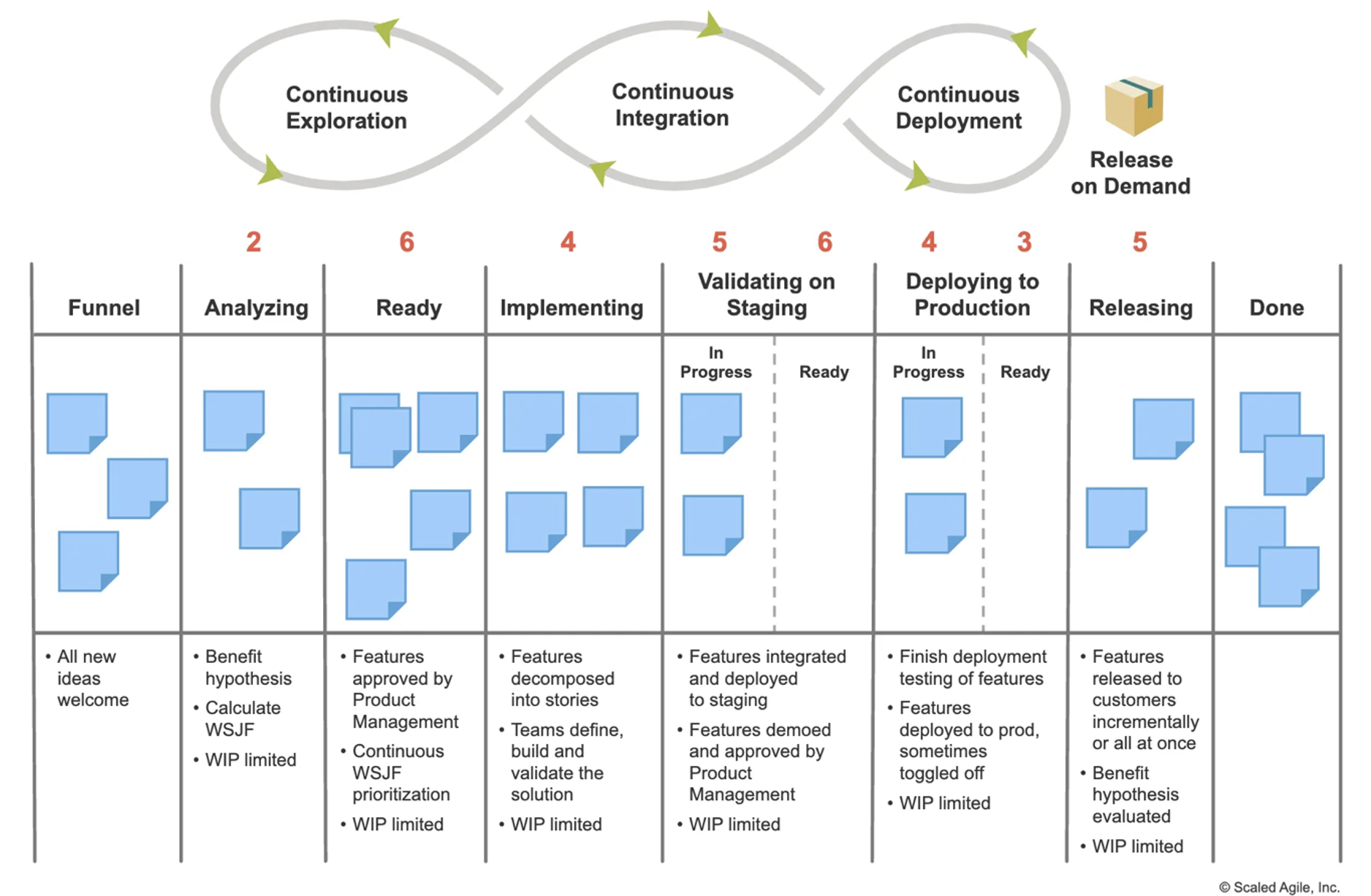
Deploying Features and Capabilities
The Solution Train and ART backlogs described above are refined to a Team Backlog Kanban. This is the lowest level backlog used to capture functional and non-functional requirements that implement the validated features and epics.
A product owner manages the team backlog, and the delivery of automation features and functionality follows a pattern similar to a typical agile software development process. For example, a software development team using Kanban may have a backlog item for implementing a new login feature. The product owner would prioritize this item in the Team Backlog Kanban, and the team would work on developing and testing the feature before deploying it to production.

Exercise: The Automation Timeline Challenge
• Risk Card 1: “A key stakeholder is unavailable for 2 weeks, delaying approvals.”
• Risk Card 2: “Technical issue with bot integration adds 1 week to development.”
• Risk Card 3: “New regulatory requirements mean additional testing is required.”.

Course Manual 11: Continuous Improvement
Continuous improvement ensures that automation processes remain up-to-date, effective, and in line with organizational objectives. Without an ongoing commitment to refining and evolving the IA strategy, automation initiatives can become stagnant, fail to scale, or miss out on emerging opportunities. Adapting to changing market conditions, customer needs, and technological advancements through continuous evaluation and updating of the IA processes is crucial for success. Continuous improvement not only sustains the organization’s competitive advantage but also cultivates an innovative and adaptable culture.
Here are a few reasons why continuous improvement is critical for IA success.
Evolving business needs: As the business grows, changes, or adapts to market demands, automated processes need to evolve accordingly to support new strategies and goals.
Technological advancements: The rapid pace of AI, machine learning, and automation technologies means that there are always new tools, methods, and best practices to adopt.
Process optimization: Even well-designed automated processes can become inefficient over time due to unforeseen bottlenecks or changing workflows, making regular refinement crucial.
Scalability: Continuous improvement allows organizations to fine-tune their automation systems to ensure they scale effectively across departments, regions, or use cases.
Maximizing ROI: By optimizing and expanding automation efforts, businesses can maximize the return on investment (ROI) from their IA initiatives over the long term.
Continuous Process Monitoring
During the initial discovery phase of the project, processes will be analyzed using process mining and other tools to build the automation solution. This needs to be continued to establish a feedback loop for regularly monitoring key metrics, identifying areas for improvement, and making data-driven decisions to optimize automation workflows. Continuous refinement and streamlining of processes enable businesses to minimize inefficiencies and maximize the impact of their automation efforts. This iterative approach allows for ongoing improvements that can lead to significant cost savings, increased productivity, and ultimately, a higher ROI.
Feedback Loop
A continuous monitoring feedback loop can be implemented by setting up regular check-ins with key stakeholders to review performance metrics, analyze trends, and identify any bottlenecks or opportunities for enhancement. By collecting feedback from stakeholders directly engaged in the automation workflows, businesses can obtain valuable insights to make informed decisions on further process optimization. The feedback loop ensures that adjustments can be made in real time, leading to a more agile and efficient automation strategy that aligns with the organization’s goals and objectives. Key steps for implementing a feedback loop include:
Track key performance indicators (KPIs): Identify the most important KPIs for IA initiatives, such as process efficiency, error rates, cost savings, and employee productivity. Regularly measure these metrics to understand the impact of automation.
Collect feedback from users: Gather input from employees who interact with automated systems to uncover inefficiencies, pain points, or opportunities for enhancement.
Analyze system performance: Use monitoring tools to assess the performance of automation platforms, including task completion times, error logs, and system downtimes.
Regular review meetings: Schedule periodic review meetings with key stakeholders, including process owners, IT teams, and business leaders, to discuss automation performance and areas for improvement.
Example: A retail company using IA to automate inventory management could track metrics such as stock turnover rate, order accuracy, and time saved in inventory replenishment. By analyzing this data regularly, the company can identify areas where automation can be fine-tuned to improve efficiency.
Process Mining
Process mining is a data-driven technique that extracts and analyzes event logs from enterprise systems such as ERP, CRM, and other transactional platforms. It reconstructs the flow of processes based on actual data, providing a transparent and objective view of how operations are truly being executed in real-time. This visibility enables organizations to detect inefficiencies and deviations from standard procedures, highlighting opportunities for improvement.
Process mining supports continuous improvements in IA as follows:
Data-Driven Process Discovery: Process mining allows organizations to visualize their existing workflows in detail, revealing how processes operate in practice. This discovery phase is crucial for identifying high-impact processes that are suitable candidates for automation, ensuring IA solutions target areas where they can deliver the most value.
Optimization of Automated Processes: Once automation is implemented, process mining continuously monitors and evaluates the performance of automated workflows. By analyzing key performance indicators (KPIs) such as cycle times, error rates, and throughput, organizations can identify areas where IA solutions may need to be refined or optimized for better performance.
Uncovering Bottlenecks and Inefficiencies: Process mining uncovers bottlenecks, delays, and other inefficiencies that may not be apparent from a top-down process analysis. By understanding exactly where processes slow down or break down, organizations can fine-tune automation strategies to eliminate these obstacles and improve overall efficiency.
Ensuring Process Compliance: Process mining can also help ensure that automated workflows adhere to regulatory requirements or internal standards. By comparing the actual flow of operations against predefined compliance rules, businesses can identify deviations and take corrective actions, reducing risks related to non-compliance.
Supporting Continuous Improvement Cycles: Intelligent automation is not a one-time initiative but an ongoing journey of improvement. Process mining provides the data and insights needed for continuous iteration, helping organizations measure the impact of IA implementations and make data-informed decisions about how to further optimize processes.
Continued Iterative Development
Agile methodologies are highly effective not only for the initial implementation of automation but also for ongoing development. By incorporating process mining data into the Agile backlog, teams can prioritize automation initiatives based on the data-driven insights provided. This combination of Agile methodologies and process mining creates a powerful framework for organizations to continuously optimize their processes and drive sustainable improvements in efficiency and effectiveness.
As new automation opportunities are discovered, organizations can create lean business cases by outlining the potential benefits, costs, and feasibility of implementing these opportunities. These lean business cases can then be used to justify investments in automation projects, ensuring that resources are allocated to initiatives with the highest potential for impact.
Agile release trains or solution trains can be created for incremental improvements. These release trains help break down large automation projects into smaller, more manageable pieces, allowing for quicker implementation and feedback from stakeholders.
Regular demos and feedback loops encourage new opportunities for automation to be found in existing use cases. Incorporating feedback from stakeholders is essential for ensuring that automation solutions align with their needs and deliver value.
Backlog refinement and prioritization are regular activities that take into account the changing business and technology landscape. By continuously refining and prioritizing the backlog, organizations can stay ahead of the curve and adapt to any shifts in the market or technology.
Agile methodology promotes a culture of continuous learning, essential for organizations looking to improve their automation initiatives. By holding retrospectives at the end of each sprint or program increment, teams can reflect on what did and did not work and how automation can be further optimized.
Fostering a Continuous Improvement Culture
A fundamental aspect of ongoing enhancement is fostering an environment where team members are motivated to learn, innovate, and identify opportunities for process optimization. This entails delivering continuous education, nurturing a culture of inquiry, and establishing a setting where constructive feedback and creativity are appreciated. Creating an environment that fosters ongoing enhancement encourages employees to be more engaged and committed to the company’s success. Enhancing productivity, efficiency, and overall performance is achievable through focused efforts. Furthermore, by encouraging employees to take responsibility for their tasks and consistently seek enhancement, organizations can maintain their competitive edge and continually adapt to the evolving demands of their clientele. This mindset is essential for IA, as automation technologies frequently necessitate continuous adjustments and updates to enhance accuracy and effectiveness. Incorporating continuous improvement as a fundamental principle enables organizations to maintain the relevance, adaptability, and high performance of their automation solutions over time. Teams are motivated to consistently identify inefficiencies and explore new avenues for improving processes via automation.
Continuous learning can be promoted in several ways:
Ongoing training: Provide employees with continuous learning opportunities to upskill in automation, AI, and other emerging technologies. This helps them stay current with the latest tools and trends.
Innovation incentives: Encourage employees to identify automation opportunities or suggest process improvements by offering rewards or recognition for their contributions.
Open communication: Establish regular forums or workshops where employees can share feedback, insights, and lessons learned from their experiences with IA.
Example: A healthcare provider could offer training sessions on using IA tools in patient data management, empowering staff to identify new areas for automation and improve service delivery.

Case Study: How Toyota Uses Kaizen
[Source: https://businessmap.io/lean-management/improvement/what-is-kaizen]
Toyota is famous for using the Kaizen philosophy as one of the core principles of manufacturing capability. By implementing Kaizen, Toyota has been able to continuously improve its production processes and increase efficiency. This philosophy encourages employees at all levels to identify and suggest small, incremental improvements to their work. This commitment to constant improvement has helped Toyota maintain its position as a leader in the automotive industry.
The Kaizen process is a 7-step cycle that encourages continuous improvement through self-accountability. The steps in the process are:
1. Foster employee involvement
2. Identify problems
3. Develop a strategic solution
4. Pilot the solution
5. Evaluate the outcomes
6. Implement organization-wide
7. Repeat steps to address new problems.
The process is centered around a focused activity referred to as “Kaizen Blitz.” During a Kaizen Blitz, employees from various departments come together to identify issues and brainstorm solutions in a concentrated and efficient manner. This collaborative approach fosters a sense of ownership and accountability among employees, leading to higher levels of engagement and motivation.
By implementing concepts such as just-in-time processing and moving tools with workers on the assembly line, Toyota was reportedly able to reduce defects by 50% and reduce production time. The success of the Kaizen Blitz approach has made it a popular method for continuous improvement in many industries, not just manufacturing. Companies around the world have adopted similar practices to streamline processes, increase productivity, and drive innovation.
Continuous Improvement Framework
To achieve sustainable results, organizations must establish a structured framework that supports continuous improvement in IA. This framework should include regular assessments of the effectiveness of IA systems, as well as mechanisms for identifying and addressing any issues that arise. By constantly monitoring and refining their IA processes, organizations can ensure that they are able to adapt to changing regulations and technological advancements while maintaining ethical standards.
Here’s a simple framework for embedding continuous improvement into your automation strategy.
Baseline metrics: Start by establishing baseline performance metrics for each automated process. These metrics should be specific, measurable, achievable, relevant, and time-bound (SMART) in order to accurately track progress and identify areas for improvement. Regular Monitoring: Implement a system for monitoring the performance of automated processes on a consistent basis. This will help to quickly identify any deviations from expected outcomes and allow for timely corrective actions to be taken.
Data collection: Continuously collect data on the performance of automated processes, systems, and tools. This data can provide valuable insights into the efficiency and effectiveness of the automation, as well as help in identifying any bottlenecks or issues that may arise. Having a robust data collection system in place can also help in forecasting future trends and making proactive adjustments to ensure continued success.
Regular review cycles: Schedule regular review cycles (e.g., quarterly or biannually) to assess automation performance and identify areas for optimization. During these review cycles, it is important to analyze the data collected to determine if the automation processes are meeting the desired goals and objectives. Regular review cycles also provide an opportunity to address any emerging issues before they become major problems, allowing for continuous improvement and adaptation to changing circumstances.
Prioritize improvements: Based on the insights from your reviews, prioritize automation improvements that align with business goals and have the greatest impact. This will ensure that resources are allocated efficiently and that the most critical areas are addressed first. Prioritizing improvements based on impact will help achieve quick wins and build momentum for further enhancements in the future.
Implement agile adjustments: Make incremental adjustments using agile methodologies to ensure rapid, effective changes. By implementing agile adjustments, one can quickly respond to feedback and make necessary changes in a timely manner. This approach allows for flexibility and agility in addressing any issues that may arise during the improvement process.
Scale proven solutions: Once an optimized solution has been validated, scale it across other processes, departments, or regions. Scaling proven solutions across various areas within the organization can help streamline operations and drive consistent improvements in performance. This approach not only maximizes the impact of successful initiatives but also fosters a culture of continuous improvement and innovation.
Employee engagement: Involve employees in the continuous improvement process by encouraging feedback, participation, and learning opportunities. This can help create a sense of ownership and accountability among employees, leading to increased motivation and commitment to the organization’s goals. Empowering employees to contribute their ideas and insights helps businesses tap into a wealth of knowledge and experience accumulated in human capital over time.
Continuous Governance Updates
Governance is essential to maintaining the security, compliance, and performance of automated systems. As IA initiatives grow and evolve, organizations must continuously update their governance frameworks to address new risks, regulatory requirements, and ethical considerations. This may involve regular reviews of policies and procedures, as well as ongoing training for employees on best practices for IA implementation. By staying proactive in updating governance structures, organizations can ensure that their IA initiatives remain aligned with their overall goals and values. In addition, by regularly assessing and adapting governance frameworks, organizations can better mitigate potential risks and ensure a smooth and successful integration of IA technologies.
Key governance considerations include:
Compliance monitoring: Regularly update automated processes to comply with new regulations or standards in areas such as data privacy, financial reporting, or industry-specific requirements. Regular monitoring of compliance ensures that organizations stay ahead of any regulatory changes and avoid costly penalties or legal issues. It also helps in maintaining trust and credibility with stakeholders and customers.
Security assessments: Conduct ongoing security assessments to identify and address vulnerabilities in automated workflows, particularly when integrating new technologies. Regular security assessments are essential to protect sensitive data and prevent potential cyber threats. By proactively addressing vulnerabilities in automated workflows, organizations can minimize the risk of data breaches and maintain the integrity of their systems. Additionally, security assessments help ensure that compliance with industry-specific regulations and standards is consistently met, further enhancing the overall security posture of the organization.
Ethical AI: Ensure that AI-driven automation is transparent, fair, and free from bias by implementing ethical guidelines and monitoring AI decisions. This will help build trust with customers and stakeholders, as well as mitigate the risk of discrimination and unethical practices. It is important for organizations to continuously educate and train employees on the ethical use of AI technology to uphold ethical standards and protect individual rights. By prioritizing ethical considerations in AI development and deployment, organizations can ensure that their automated workflows contribute to a more secure and trustworthy digital environment.
Example: A financial services firm using IA for fraud detection must continuously update its compliance policies to adhere to new regulations while also ensuring that AI-driven decisions are transparent and ethical.

Exercise: Automation Kaizen Sprint

Course Manual 12: Adoption and Industry Trends
The success of an intelligent automation project ultimately depends on easy and rapid adoption. Additionally, businesses must stay informed about industry trends and best practices to maximize the return on investment in IA.
Driving Adoption
Successful adoption of intelligent automation requires more than just rolling out new technologies. It involves winning over stakeholders, training employees, and aligning automation initiatives with organizational goals. To drive the adoption of intelligent automation, organizations must prioritize communication and education to address any resistance from employees. When employees see the benefits of IA and how it improves their workflows, they are more likely to accept the technology. Additionally, organizations should continuously evaluate and adjust their automation strategies to ensure they remain aligned with changing business needs and industry trends.
Below are key strategies to help drive adoption.
Executive Sponsorship and Buy-In
To achieve organization-wide IA adoption, leadership must be actively engaged and supportive of the initiative. Executive sponsorship offers essential resources and strategic guidance to advance the initiative.
There are a number of ways to secure executive buy-in.
Demonstrate ROI: Present a compelling business case that highlights potential cost savings, efficiency gains, and competitive advantages IA can offer. Use pilot results to show proof of value.
Align with business goals: Ensure that automation efforts align with the company’s strategic objectives, such as improving customer experience, increasing revenue, or enhancing compliance.
Communicate a clear vision: Senior leaders should articulate a clear vision of how IA will benefit the organization and why it is essential for long-term success.
Example: A large retail company might secure executive buy-in for an IA project by showing how automating the inventory management process can reduce stockouts, enhance customer satisfaction, and cut operational costs.
Employee Participation
Adoption requires an organizational mindset shift toward embracing automation. Employees should grasp how IA will affect their work, the benefits it offers them, and how they can engage in automation initiatives.
Steps to build a culture of automation:
Communicate the benefits to employees: Explain how IA can reduce mundane tasks, allowing employees to focus on higher-value work such as decision-making and customer interaction.
Involve employees early: Engage employees in identifying processes for automation and involve them in the design and testing phases to foster a sense of ownership.
Create automation champions: Identify and train a group of employees who can act as champions for automation within their departments, promoting its use and supporting their colleagues.
Example: In a financial services company, employees might be encouraged to suggest tasks they believe could be automated, such as repetitive data entry or reporting processes, making them active participants in the automation journey.
Comprehensive Training and Upskilling
Fear and uncertainty among employees about IA adoption stem from concerns that automation may replace their jobs or render their roles obsolete. A comprehensive training and upskilling program is essential to overcoming these fears and ensuring employees can work effectively alongside automated systems.
The following approaches are commonly used for training and adoption.
Role-based training: Offer targeted training programs based on job roles to ensure employees understand how IA will impact their specific tasks and workflows.
Upskilling opportunities: Provide opportunities for employees to learn new skills in areas like automation management, data analysis, and AI to make them valuable contributors to IA projects.
Ongoing support: Offer continued access to resources, help desks, and training sessions to assist employees as they interact with new IA tools.
Example: A manufacturing company introducing robotic process automation (RPA) for inventory tracking could provide training on how the new system works, while also upskilling employees to handle data analysis and maintenance tasks related to the automation.
Avoiding Big-bang Change
To encourage broad adoption, it’s important to start with small, manageable IA initiatives that can demonstrate quick wins and deliver measurable value. Pilot projects are an excellent way to introduce IA, test its feasibility, and gather feedback before scaling across the organization.
Benefits of starting small include:
Low risk: Pilots allow you to experiment with automation in a controlled environment, minimizing the risk of disrupting core business processes.
Proof of value: Successful pilots provide tangible evidence of IA’s benefits, making it easier to gain support for further automation initiatives.
Feedback and improvement: Pilots offer an opportunity to gather feedback from employees, identify areas for improvement, and refine workflows before broader implementation.
Example: An HR department might start by piloting automation for tasks like candidate screening and onboarding, reducing manual paperwork, and speeding up the hiring process.
Risks and Ethics
As intelligent automation becomes increasingly integrated into business processes, it brings not only vast potential but also a set of risks and ethical considerations that organizations must navigate. These risks include potential job displacement, data privacy concerns, and the ethical implications of AI decision-making. Organizations must carefully consider how to balance the benefits of IA with the potential negative impacts on employees and society as a whole. Ensuring transparency, accountability, and fairness in the deployment of IA technologies is crucial to maintaining trust and integrity in the workplace. By addressing these risks and ethical considerations upfront, organizations can proactively mitigate potential harm and maximize the positive impact of IA on their operations.
Job Displacement and Workforce Impact
One of the most prominent risks of intelligent automation is the potential displacement of jobs, particularly in roles that involve repetitive or administrative tasks. As businesses automate these tasks, employees may face job insecurity, and the organization could encounter resistance to automation initiatives.
Ethical consideration: Organizations must take responsibility for supporting their workforce through this transition. Ethical automation involves investing in reskilling and upskilling employees, providing them with opportunities to move into more value-added roles. A clear communication plan that outlines the benefits of IA for both the company and the workforce helps mitigate fears.
Bias and Fairness in AI Algorithms
IA often relies on AI algorithms to make decisions, whether it’s approving loan applications, selecting job candidates, or predicting consumer behaviour. However, Biases can enter AI systems through the data they are trained on, resulting in unfair or discriminatory results. For example, if a hiring algorithm is trained on historical data that reflects gender or racial bias, it may unintentionally perpetuate those biases.
Ethical consideration: Ensuring fairness and transparency in AI decision-making is critical. Organizations must rigorously evaluate their algorithms, use diverse data sets, and continuously monitor IA systems for potential bias. Additionally, creating explainable AI models (where decisions are transparent and understandable) is key to maintaining trust and accountability.
Data Privacy and Security
IA often requires access to large volumes of data, including sensitive personal or financial information. This raises concerns about how data is collected, stored, and used. A breach of data privacy could result in significant harm to individuals and damage the organization’s reputation.
Ethical consideration: Businesses must ensure that IA systems comply with data privacy regulations, such as the General Data Protection Regulation (GDPR). Transparent data practices, informed consent, and strong data security protocols are essential to protecting user privacy and maintaining trust. Organizations should only collect data that is necessary for the automation task and ensure it is securely stored.
Accountability and Governance
As IA systems take over more decision-making processes, the question of accountability becomes critical. Who is responsible if an automated system makes a mistake, causes harm, or violates regulations? Without clear governance, organizations may struggle to assign responsibility for decisions made by IA systems.
Ethical consideration: Establishing a clear governance framework is essential. This includes defining the roles and responsibilities for monitoring IA systems, setting up audit trails for automated decisions, and ensuring human oversight where necessary. Organizations should also have mechanisms for addressing errors or negative outcomes resulting from automation.
Over-reliance on Automation
While IA can improve efficiency, over-reliance on automation can introduce risks, such as reduced critical thinking or innovation among employees. In some cases, automated systems might make decisions without understanding the full context, leading to suboptimal outcomes.
Ethical consideration: IA should augment human capabilities, not replace them entirely. Organizations must strike a balance between automation and human involvement, ensuring that employees still have the opportunity to make decisions, provide oversight, and add creative input. Continuous improvement processes should involve regular assessments of IA’s effectiveness and potential unintended consequences.
Process Automation Trends
Hyperatutomation
Hyperautomation takes intelligent automation to the next level by automating complex processes end to end. This area will continue to grow, and new products and platforms are likely to emerge.
In addition to AI, ML and RPA, hyperautomation may incorporate other technologies such as blockchain, metaverse, and IoT. This combination of new technologies and toolchains is going to create new opportunities for automation and new ways of working.
By staying informed about the latest trends and advancements in hyperautomation, businesses can stay ahead of the curve and make informed decisions about how to leverage these technologies effectively.
Citizen Development & Low-Code Platforms
Low-code platforms/citizen development is another area of active innovation at the moment. It is likely to incorporate LLM-driven chabot functionality using technologies such as ChatGPT, Microsoft Co-pilot, and Google Gemini. With such features, process analysts and non-developers will be able to create complex automation applications and capabilities simply by specifying the process flow in a “prompt”. This will democratize the development process even further, allowing for faster and more efficient creation of automation solutions.

Case Study: Microsoft Copilot with Power Automate
[Source: https://learn.microsoft.com/en-us/power-automate/get-started-with-copilot#create-a-flow-using-the-cloud-flows-designer-with-copilot]
Microsoft Power Automate is a cloud-based service that allows users to automate workflows and tasks.
Microsoft Copilot is an LLM-powered productivity assistant that is integrated into Power Automate. It provides intelligent suggestions and assistance to help users build automated workflows (flows) more efficiently. Copilot can create automated workflows through quick and easy natural language expressions. A flow can be created by describing what is needed through multiple steps of conversation.
Cloud Flows is the core automation capability in Power Automate. The Cloud Flows copilot can perform the following actions:
• Create a flow based on the scenario prompt provided.
• Auto-set up the required connections to enable a working automation.
• Apply the required parameters in the flow based on the prompt.
• Respond to requests to make changes to flow, such as update and replace actions.
• Answer questions about the flow. For example, one can ask Copilot questions about the flow like, What does this flow do? Or how do I access child flows? Or how do I access licenses?.
• Suggest a description for the flow when editing the flow’s details.
New BOAT on the Horizon
Gartner, in its crystal ball view of the future, sees a new paradigm emerging for intelligent business process automation. A new term has been coined for this: Business Orchestration and Automation Technologies.
BOAT platforms combine a shared set of features from RPA, iPaaS, and BPA technologies. Additionally, they incorporate technologies like process mining and intelligence document processing. Furthermore, a BOAT platform is integrating generative and specialized AI to let autonomous agents carry out a variety of tasks. Prompt-driven development, process design, targeted content creation, unstructured data extraction, orchestrating numerous LLMs, and other areas are often the focus of BOAT’s generative AI capabilities. The native orchestration, integration, and embedded intelligence offered by BOAT providers, along with bundled licensing and unified development and operations under a single platform, will be of interest to enterprise application leaders.
This shift towards commoditization may lead to increased accessibility and affordability of intelligent automation solutions for businesses of all sizes. As more companies adopt BOAT’s generative AI capabilities, the potential for streamlining operations, increasing efficiency, and improving overall performance becomes more attainable. With all the necessary tools and resources bundled into a single platform, enterprise application leaders can focus on leveraging AI to drive innovation and growth within their organizations.
The recommendation is for companies not to overinvest in proprietary, in-house technical capabilities. Instead, they should consider partnering with a trusted provider offering a BOAT platform to access cutting-edge technology without the high costs associated with developing and maintaining their own AI systems. By leveraging BOAT’s expertise and resources, companies can stay ahead of the competition and achieve their business goals more efficiently.
Generative AI and AGI
The dust has not quite settled on Generative AI. Future advancements in artificial intelligence, including the development of Artificial General Intelligence (AGI), hold great promise for businesses looking to further enhance their automation capabilities. AGI promises to transform all of the qualities of human intelligence—such as context awareness, problem-solving ability, and future planning—into “intelligence on demand,” a resource that everyone can access whenever they choose. AI will handle everyday company activities, and people will become so accustomed to using personal AGIs in their daily lives that it will be impossible to imagine living without them.
AGI systems will enhance business decision-making by providing intuitive judgment, reasoning skills, and predictive intelligence. AGI solutions will analyze billions of data variables, generating complex insights for precision decisions like dynamic pricing, predictive maintenance, risk management, and logistics optimization. As AGI matures, its applications will expand exponentially.
An essential component of human interactions and communication is our capacity to predict, comprehend, and even simulate the mental processes of others. AGI systems will train on human interactions and learn to make judgment calls, respond to variability, and optimize complex tasks.
A crucial component of artificial general intelligence (AGI) will be real-time learning, which will enable these systems to continuously add to and improve the training data as they travel the world. AGI will be able to extract useful information from almost every interaction it has, including interactions with people, sensory input from its environment, and, of course, data gathered from the internet and other networked sources.
AGI will enhance intelligent automation across industries. In finance, AGI has the potential for algo-based trading, portfolio management, insurance, credit risk modelling, and fraud analytics. AGI can match or outperform analysts in spotting patterns, valuations, risk factors, and predictive insights, enabling data-driven decisions. Manufacturing automation in the future will use factory data for self-learning, optimize operations, and empower autonomous control of systems and operations. Retail giants like Amazon and Walmart use big data analytics and AI capabilities for analyzing billions of customer interactions. AGI will enhance these capabilities to transform personalization, demand forecasting, and supply chain resilience.
It can also optimize logistics, enable scenario modelling, and offer interconnected, data-driven capabilities.

Exercise: Automation Adoption Puzzle
Project Studies
Project Study (Part 1) – Customer Service
The Head of this Department is to provide a detailed report relating to the Roadmap for Success process that has been implemented within their department, together with all key stakeholders, as a result of conducting this workshop, incorporating process: planning; development; implementation; management; and review. Your process should feature the following 12 parts:
01. Strategy and Vision
02. Readiness Assessment
03. Cross-functional CoE
04. Use Case Discovery
05. Target Operating Model
06. Organizational Change Management (OCM)
07. Intelligent Automation Technology
08. Lean Agile Development
09. Measuring Value
10. Roadmap Delivery
11. Continuous Improvement
12. Adoption and Industry Trends
Please include the results of the initial evaluation and assessment.
Project Study (Part 2) – E-Business
The Head of this Department is to provide a detailed report relating to the Roadmap for Success process that has been implemented within their department, together with all key stakeholders, as a result of conducting this workshop, incorporating process: planning; development; implementation; management; and review. Your process should feature the following 12 parts:
01. Strategy and Vision
02. Readiness Assessment
03. Cross-functional CoE
04. Use Case Discovery
05. Target Operating Model
06. Organizational Change Management (OCM)
07. Intelligent Automation Technology
08. Lean Agile Development
09. Measuring Value
10. Roadmap Delivery
11. Continuous Improvement
12. Adoption and Industry Trends
Please include the results of the initial evaluation and assessment.
Project Study (Part 3) – Finance
The Head of this Department is to provide a detailed report relating to the Roadmap for Success process that has been implemented within their department, together with all key stakeholders, as a result of conducting this workshop, incorporating process: planning; development; implementation; management; and review. Your process should feature the following 12 parts:
01. Strategy and Vision
02. Readiness Assessment
03. Cross-functional CoE
04. Use Case Discovery
05. Target Operating Model
06. Organizational Change Management (OCM)
07. Intelligent Automation Technology
08. Lean Agile Development
09. Measuring Value
10. Roadmap Delivery
11. Continuous Improvement
12. Adoption and Industry Trends
Please include the results of the initial evaluation and assessment.
Project Study (Part 4) – Globalization
The Head of this Department is to provide a detailed report relating to the Roadmap for Success process that has been implemented within their department, together with all key stakeholders, as a result of conducting this workshop, incorporating process: planning; development; implementation; management; and review. Your process should feature the following 12 parts:
01. Strategy and Vision
02. Readiness Assessment
03. Cross-functional CoE
04. Use Case Discovery
05. Target Operating Model
06. Organizational Change Management (OCM)
07. Intelligent Automation Technology
08. Lean Agile Development
09. Measuring Value
10. Roadmap Delivery
11. Continuous Improvement
12. Adoption and Industry Trends
Please include the results of the initial evaluation and assessment.
Project Study (Part 5) – Human Resources
The Head of this Department is to provide a detailed report relating to the Roadmap for Success process that has been implemented within their department, together with all key stakeholders, as a result of conducting this workshop, incorporating process: planning; development; implementation; management; and review. Your process should feature the following 12 parts:
01. Strategy and Vision
02. Readiness Assessment
03. Cross-functional CoE
04. Use Case Discovery
05. Target Operating Model
06. Organizational Change Management (OCM)
07. Intelligent Automation Technology
08. Lean Agile Development
09. Measuring Value
10. Roadmap Delivery
11. Continuous Improvement
12. Adoption and Industry Trends
Please include the results of the initial evaluation and assessment.
Project Study (Part 6) – Information Technology
The Head of this Department is to provide a detailed report relating to the Roadmap for Success process that has been implemented within their department, together with all key stakeholders, as a result of conducting this workshop, incorporating process: planning; development; implementation; management; and review. Your process should feature the following 12 parts:
01. Strategy and Vision
02. Readiness Assessment
03. Cross-functional CoE
04. Use Case Discovery
05. Target Operating Model
06. Organizational Change Management (OCM)
07. Intelligent Automation Technology
08. Lean Agile Development
09. Measuring Value
10. Roadmap Delivery
11. Continuous Improvement
12. Adoption and Industry Trends
Please include the results of the initial evaluation and assessment.
Project Study (Part 7) – Legal
The Head of this Department is to provide a detailed report relating to the Roadmap for Success process that has been implemented within their department, together with all key stakeholders, as a result of conducting this workshop, incorporating process: planning; development; implementation; management; and review. Your process should feature the following 12 parts:
01. Strategy and Vision
02. Readiness Assessment
03. Cross-functional CoE
04. Use Case Discovery
05. Target Operating Model
06. Organizational Change Management (OCM)
07. Intelligent Automation Technology
08. Lean Agile Development
09. Measuring Value
10. Roadmap Delivery
11. Continuous Improvement
12. Adoption and Industry Trends
Please include the results of the initial evaluation and assessment.
Project Study (Part 8) – Management
The Head of this Department is to provide a detailed report relating to the Roadmap for Success process that has been implemented within their department, together with all key stakeholders, as a result of conducting this workshop, incorporating process: planning; development; implementation; management; and review. Your process should feature the following 12 parts:
01. Strategy and Vision
02. Readiness Assessment
03. Cross-functional CoE
04. Use Case Discovery
05. Target Operating Model
06. Organizational Change Management (OCM)
07. Intelligent Automation Technology
08. Lean Agile Development
09. Measuring Value
10. Roadmap Delivery
11. Continuous Improvement
12. Adoption and Industry Trends
Please include the results of the initial evaluation and assessment.

Project Study (Part 9) – Marketing
The Head of this Department is to provide a detailed report relating to the Roadmap for Success process that has been implemented within their department, together with all key stakeholders, as a result of conducting this workshop, incorporating process: planning; development; implementation; management; and review. Your process should feature the following 12 parts:
01. Strategy and Vision
02. Readiness Assessment
03. Cross-functional CoE
04. Use Case Discovery
05. Target Operating Model
06. Organizational Change Management (OCM)
07. Intelligent Automation Technology
08. Lean Agile Development
09. Measuring Value
10. Roadmap Delivery
11. Continuous Improvement
12. Adoption and Industry Trends
Please include the results of the initial evaluation and assessment.

Project Study (Part 10) – Production
The Head of this Department is to provide a detailed report relating to the Roadmap for Success process that has been implemented within their department, together with all key stakeholders, as a result of conducting this workshop, incorporating process: planning; development; implementation; management; and review. Your process should feature the following 12 parts:
01. Strategy and Vision
02. Readiness Assessment
03. Cross-functional CoE
04. Use Case Discovery
05. Target Operating Model
06. Organizational Change Management (OCM)
07. Intelligent Automation Technology
08. Lean Agile Development
09. Measuring Value
10. Roadmap Delivery
11. Continuous Improvement
12. Adoption and Industry Trends
Please include the results of the initial evaluation and assessment.

Project Study (Part 11) – Logistics
The Head of this Department is to provide a detailed report relating to the Roadmap for Success process that has been implemented within their department, together with all key stakeholders, as a result of conducting this workshop, incorporating process: planning; development; implementation; management; and review. Your process should feature the following 12 parts:
01. Strategy and Vision
02. Readiness Assessment
03. Cross-functional CoE
04. Use Case Discovery
05. Target Operating Model
06. Organizational Change Management (OCM)
07. Intelligent Automation Technology
08. Lean Agile Development
09. Measuring Value
10. Roadmap Delivery
11. Continuous Improvement
12. Adoption and Industry Trends
Please include the results of the initial evaluation and assessment.

Project Study (Part 12) – Education
The Head of this Department is to provide a detailed report relating to the Roadmap for Success process that has been implemented within their department, together with all key stakeholders, as a result of conducting this workshop, incorporating process: planning; development; implementation; management; and review. Your process should feature the following 12 parts:
01. Strategy and Vision
02. Readiness Assessment
03. Cross-functional CoE
04. Use Case Discovery
05. Target Operating Model
06. Organizational Change Management (OCM)
07. Intelligent Automation Technology
08. Lean Agile Development
09. Measuring Value
10. Roadmap Delivery
11. Continuous Improvement
12. Adoption and Industry Trends
Please include the results of the initial evaluation and assessment.
Program Benefits
Management
- Strategic alignment
- Collaborative management
- Increased efficiency
- Cost reduction
- Agile delivery
- Technical framework
- Operational streamlining
- Improved adoption
- Scalable automation
- Innovation acceleration
Operations
- Cost efficiency
- Revenue growth
- Work throughput
- Increased productivity
- Staff morale
- Process quality
- Flexibility scalability
- Enhanced compliance
- Better oversight
- Reduced debt
Customer Service
- Omnichannel service
- Faster response
- Better quality
- Error reduction
- Customer personalization
- Churn reduction
- Enhanced security
- Smart insights
- Customer satisfaction
- Proactive support
Client Telephone Conference (CTC)
If you have any questions or if you would like to arrange a Client Telephone Conference (CTC) to discuss this particular Unique Consulting Service Proposition (UCSP) in more detail, please CLICK HERE.






















